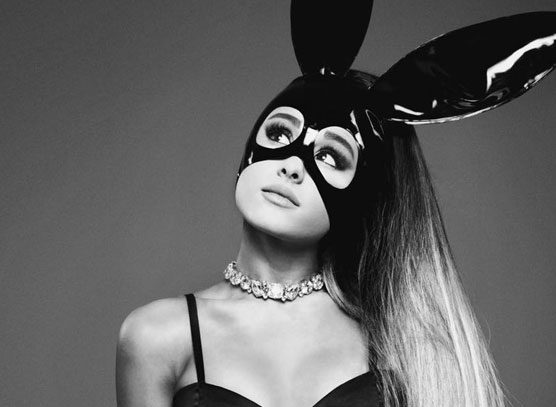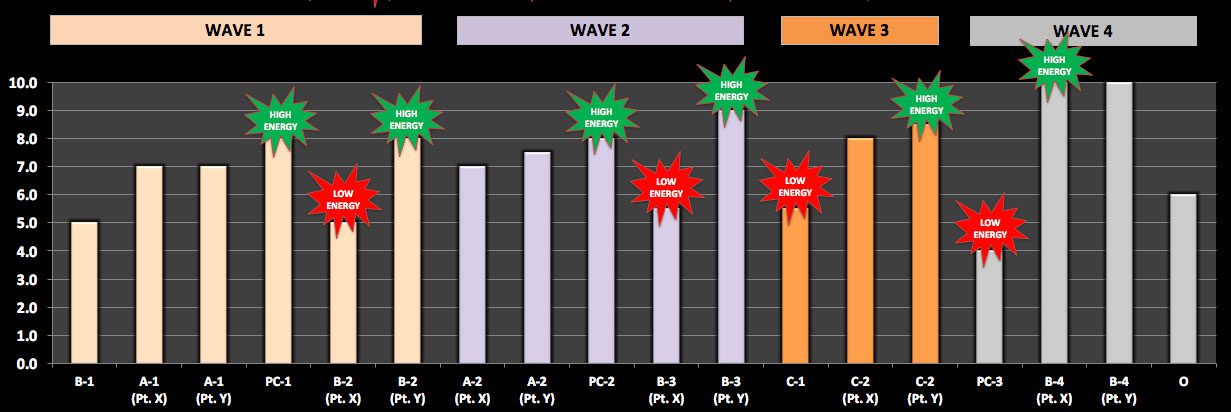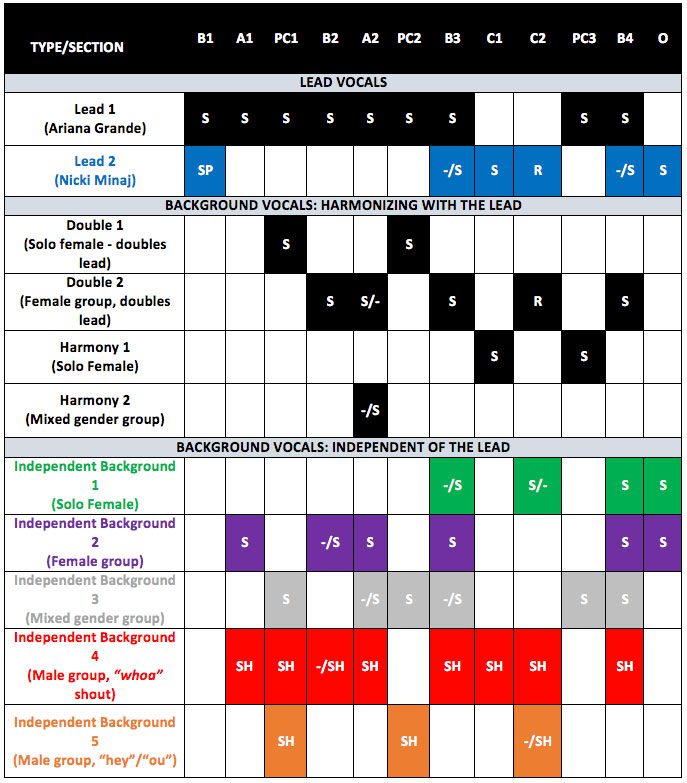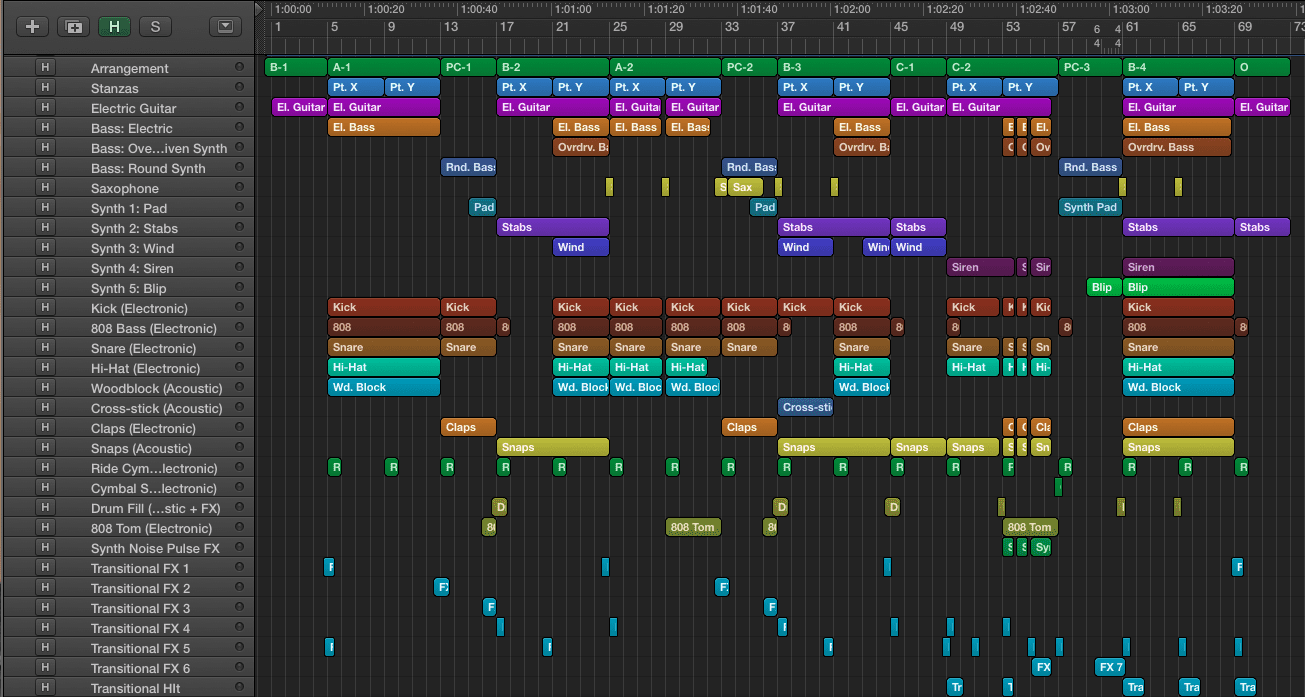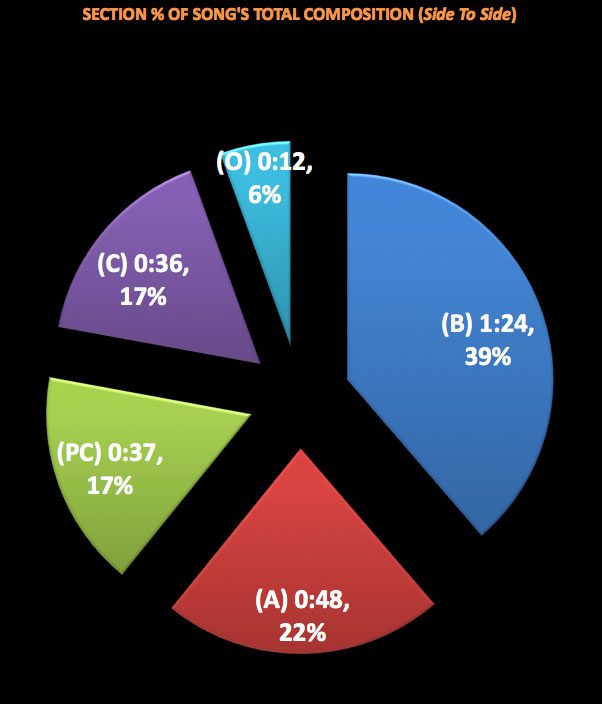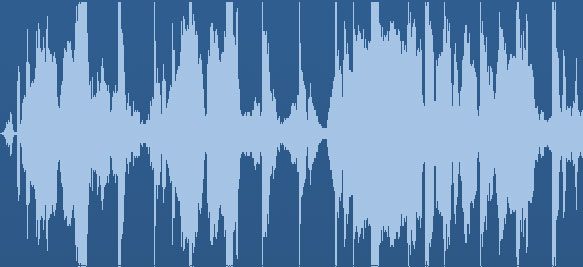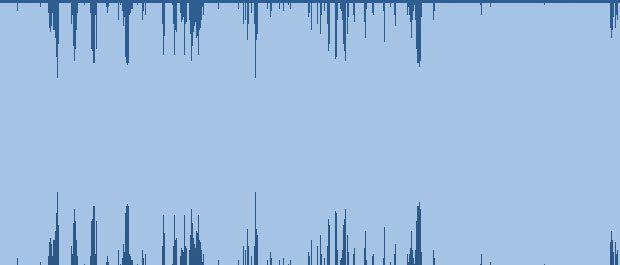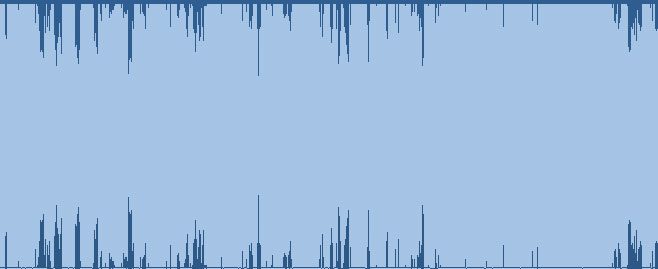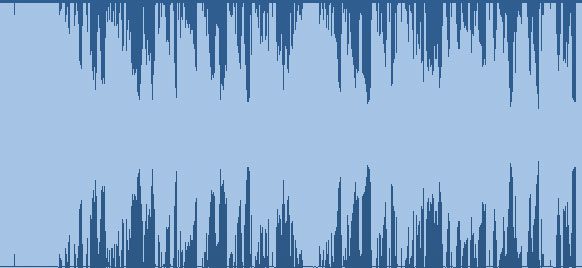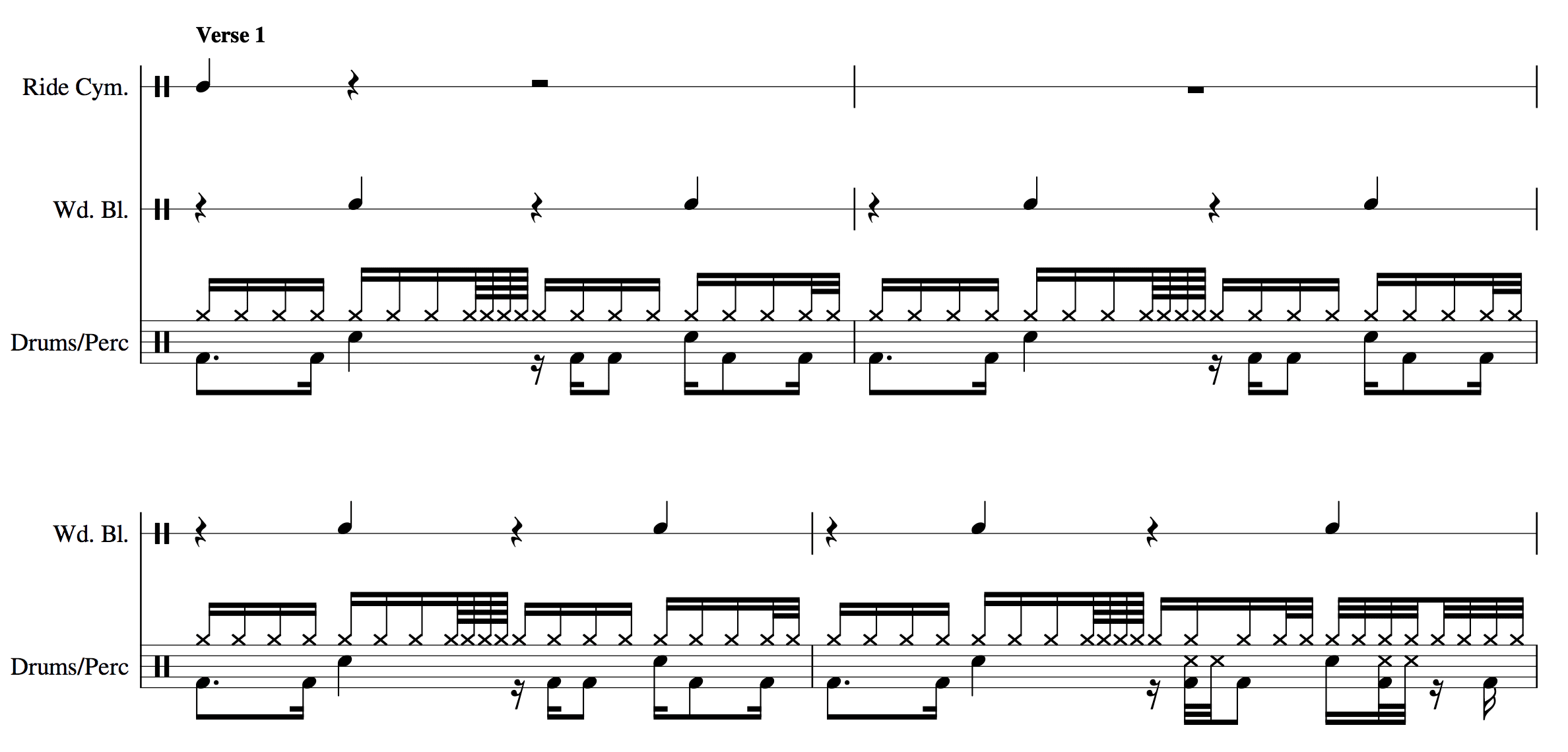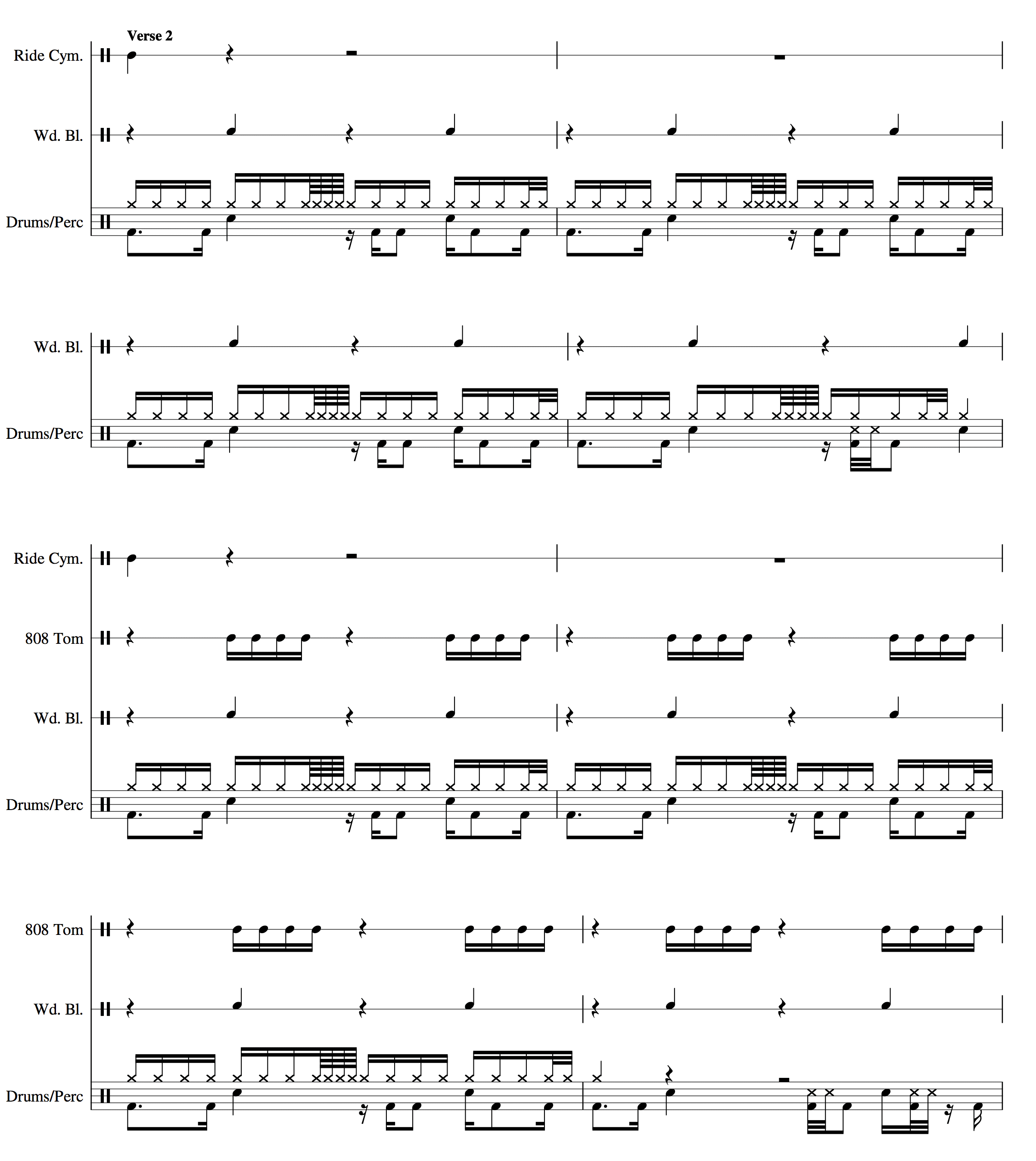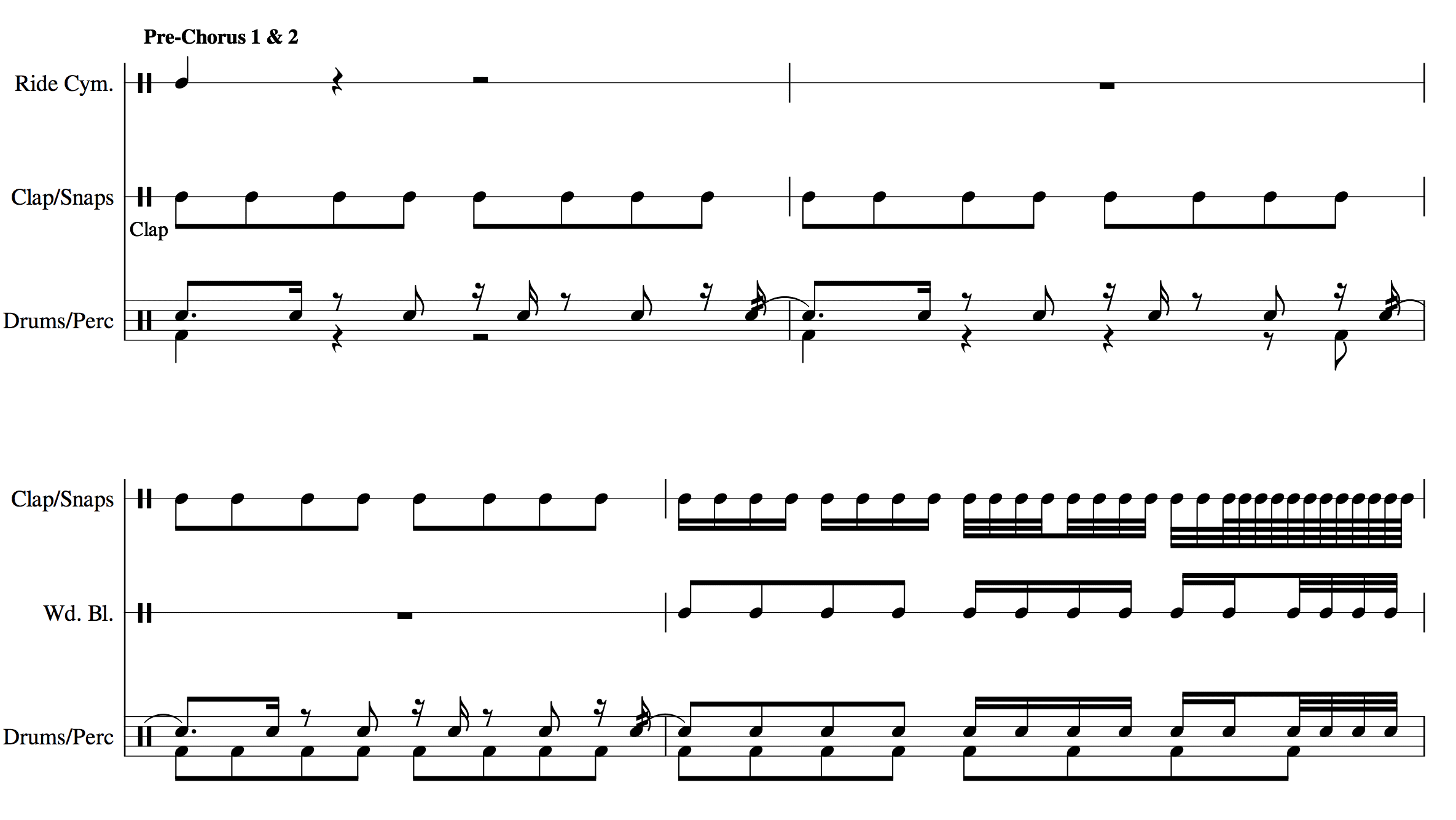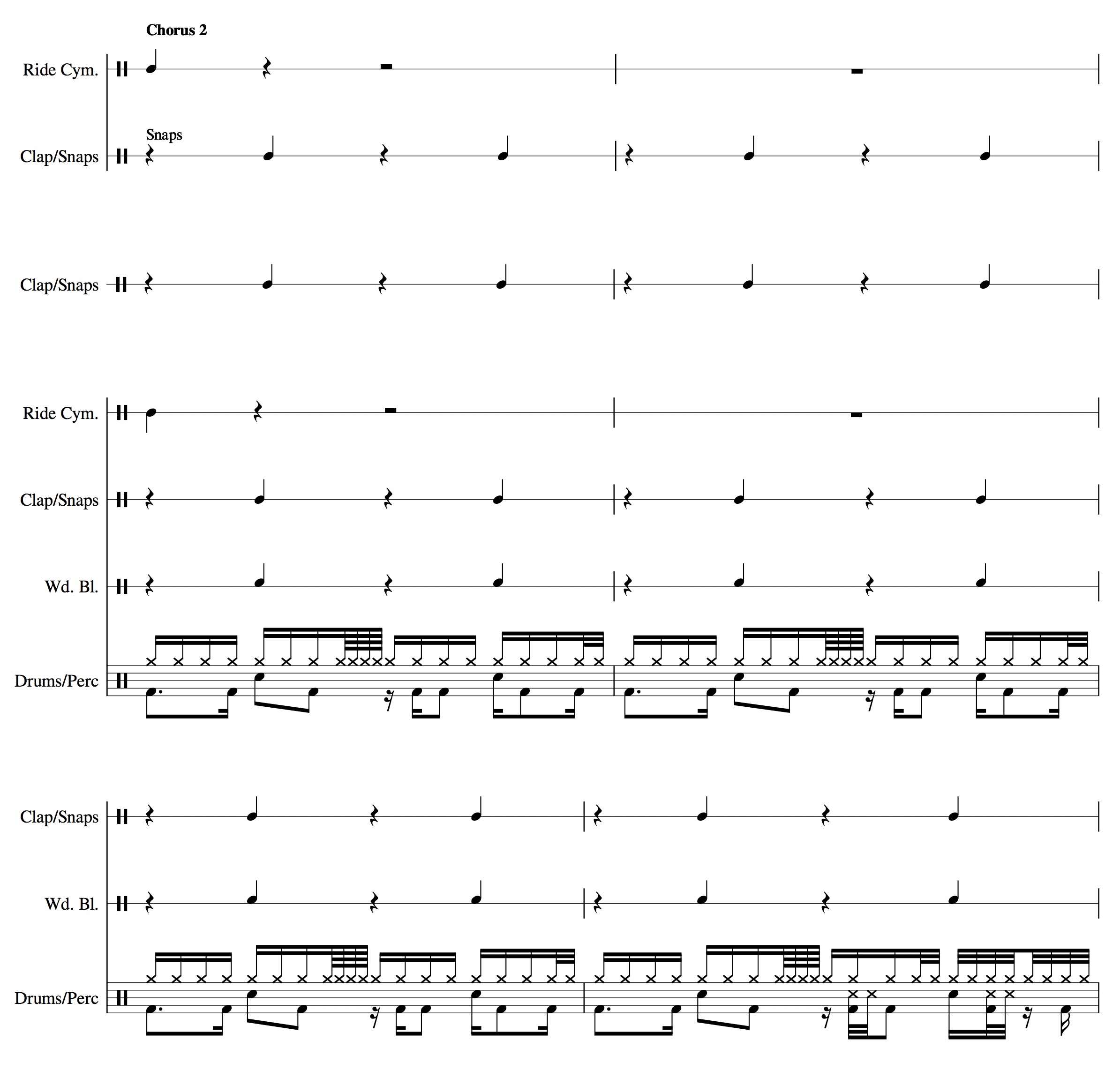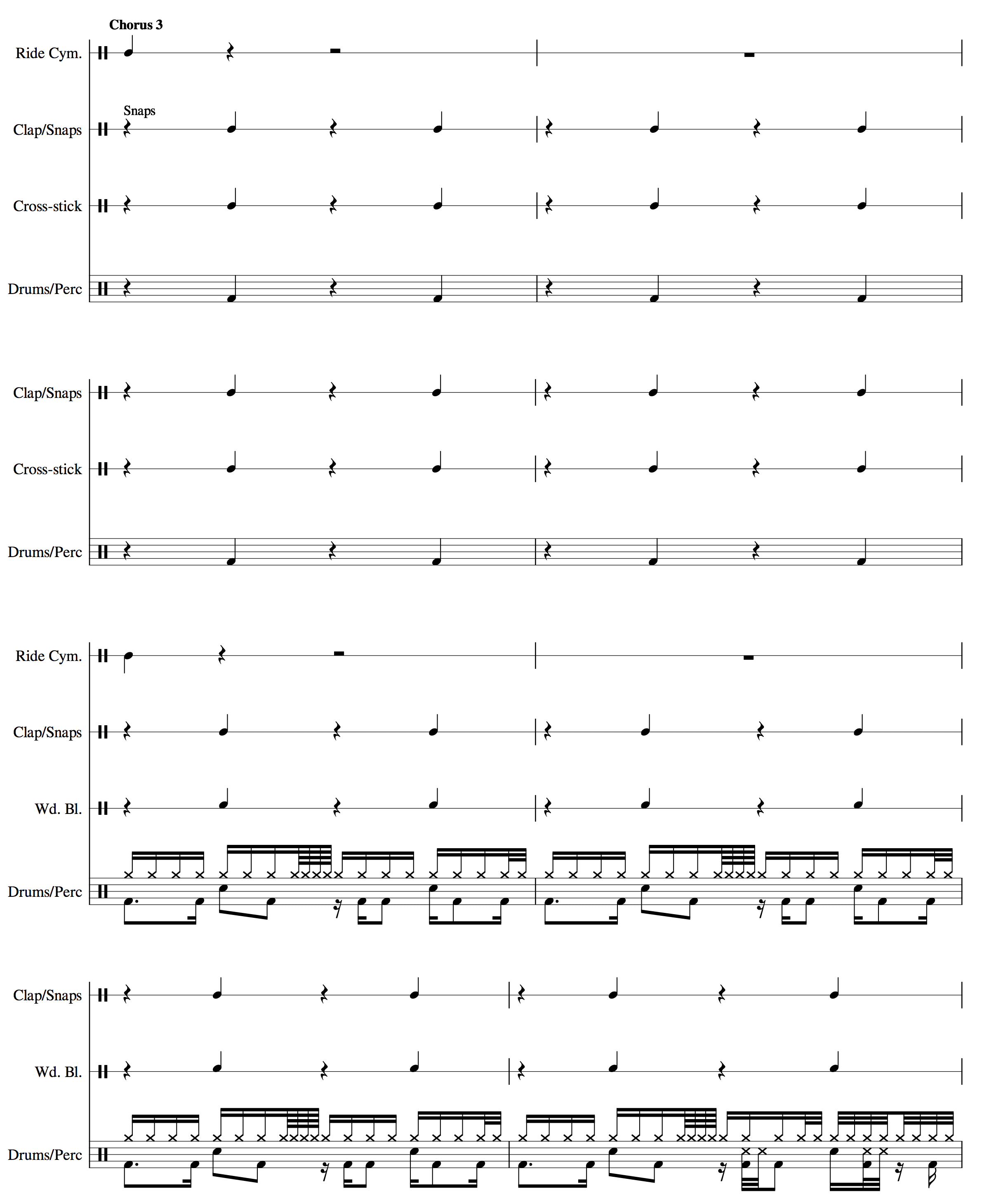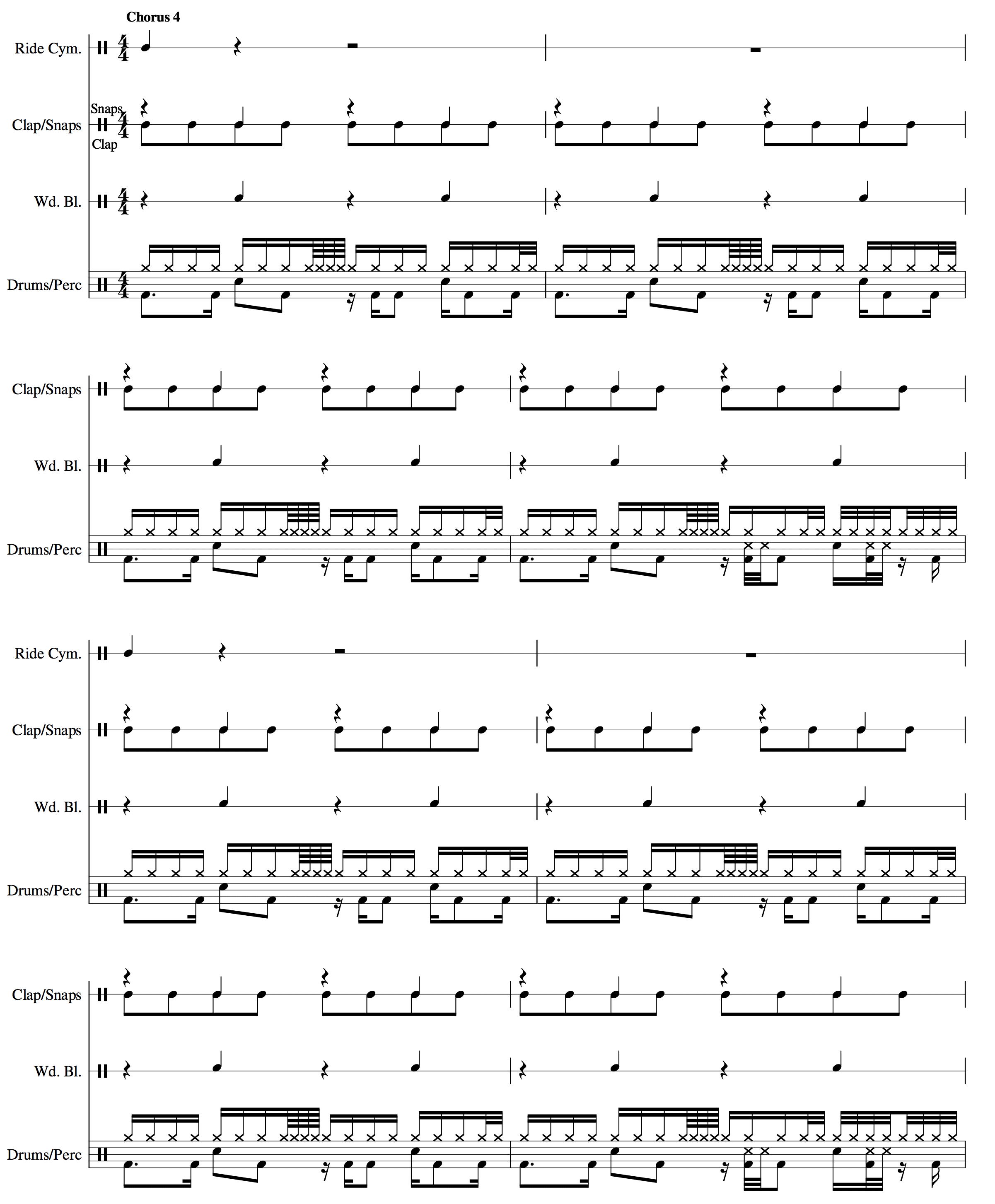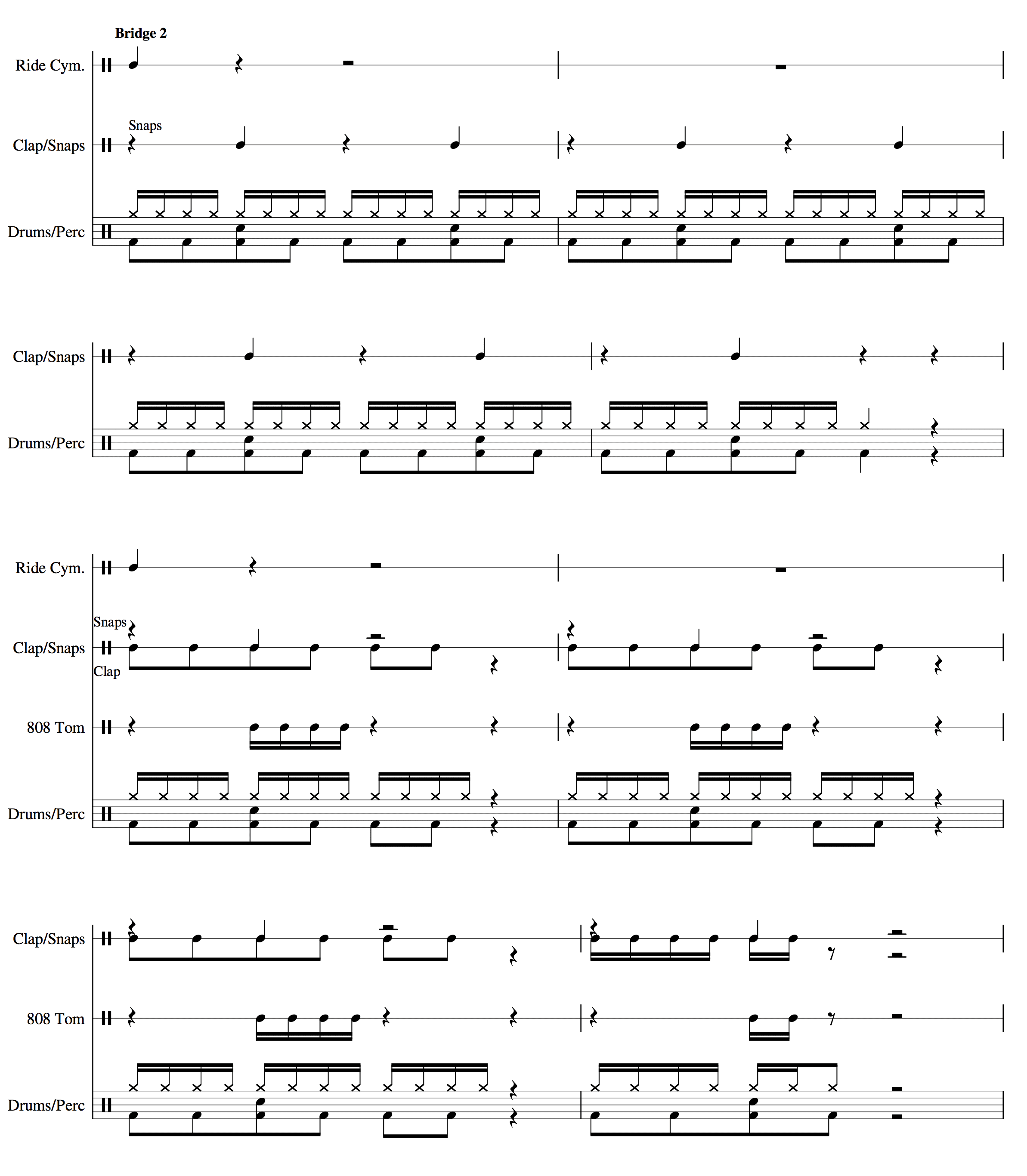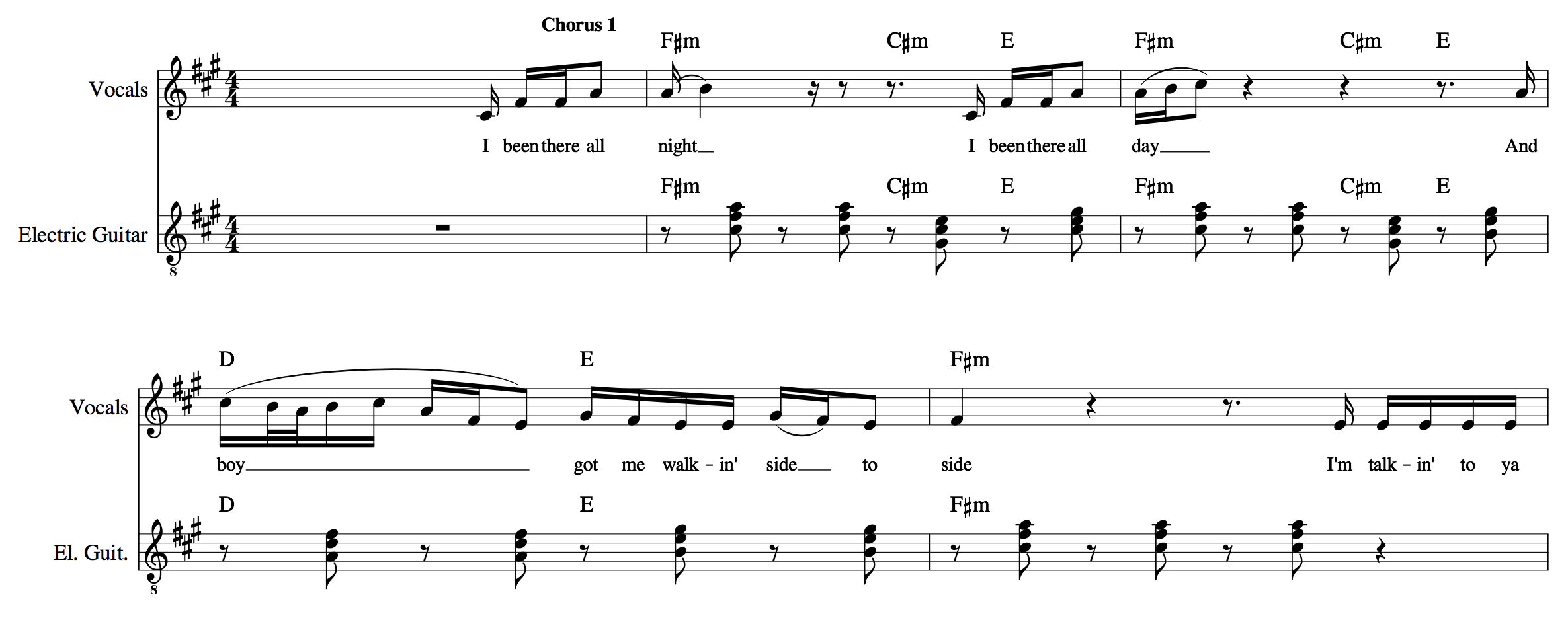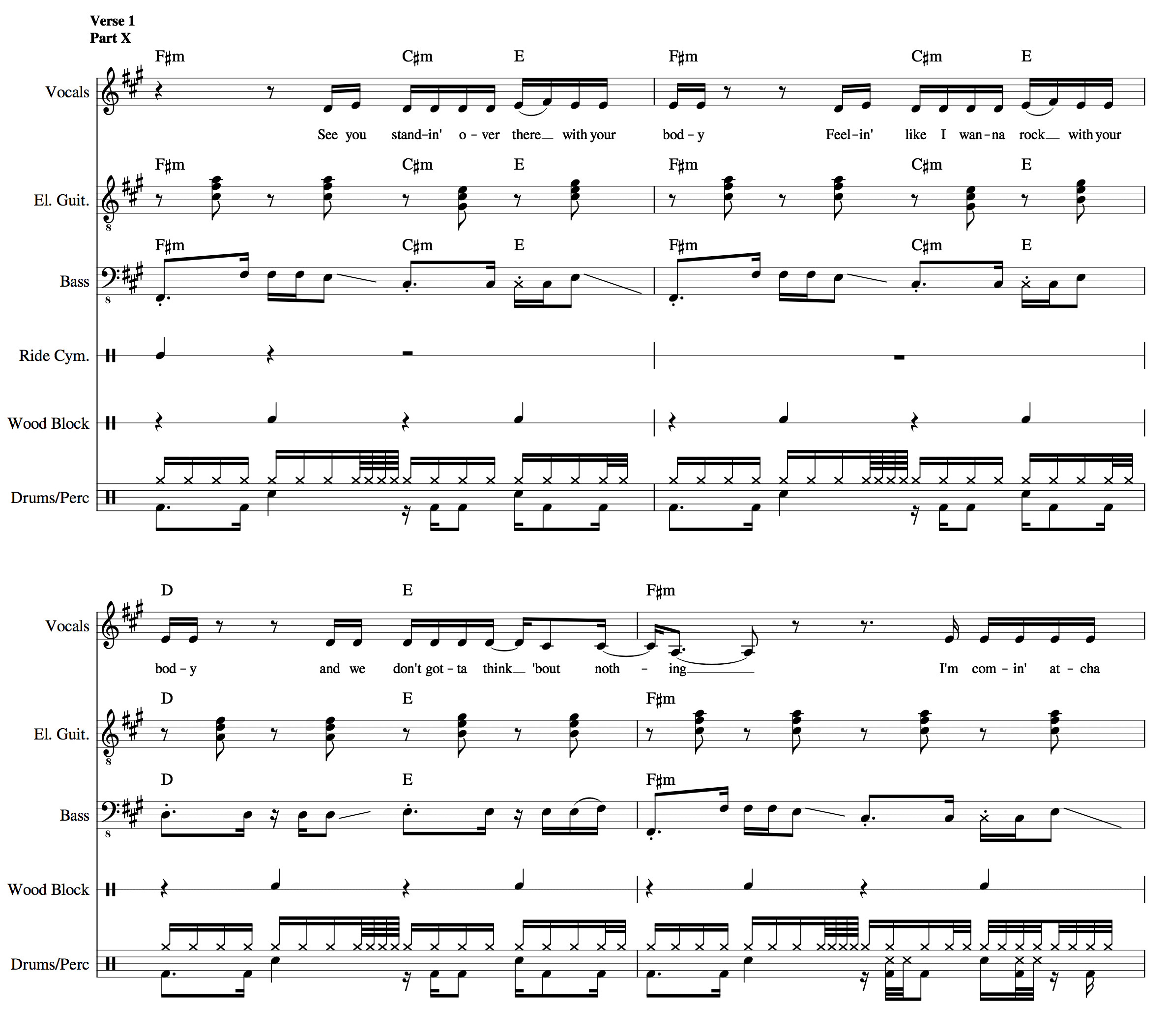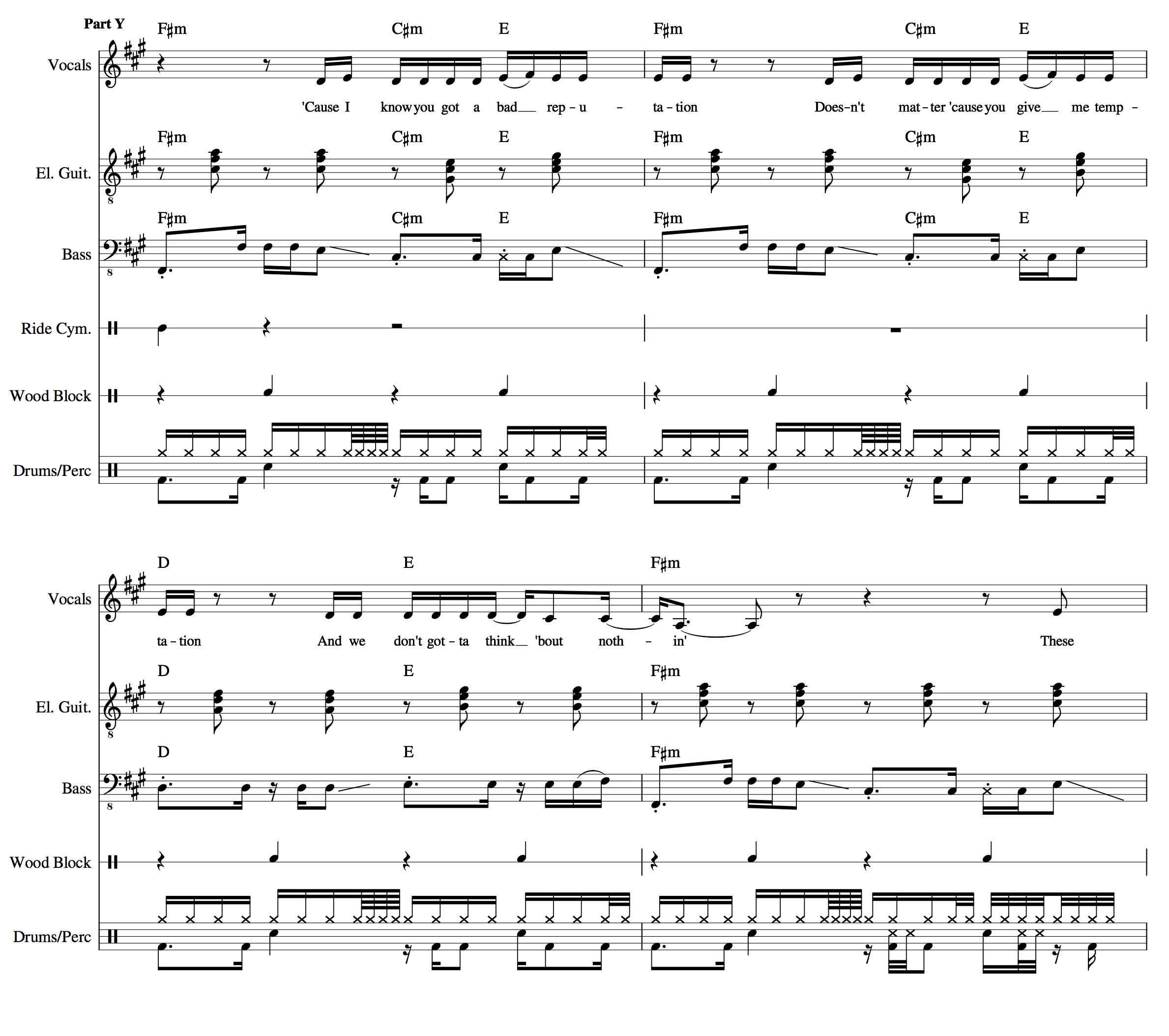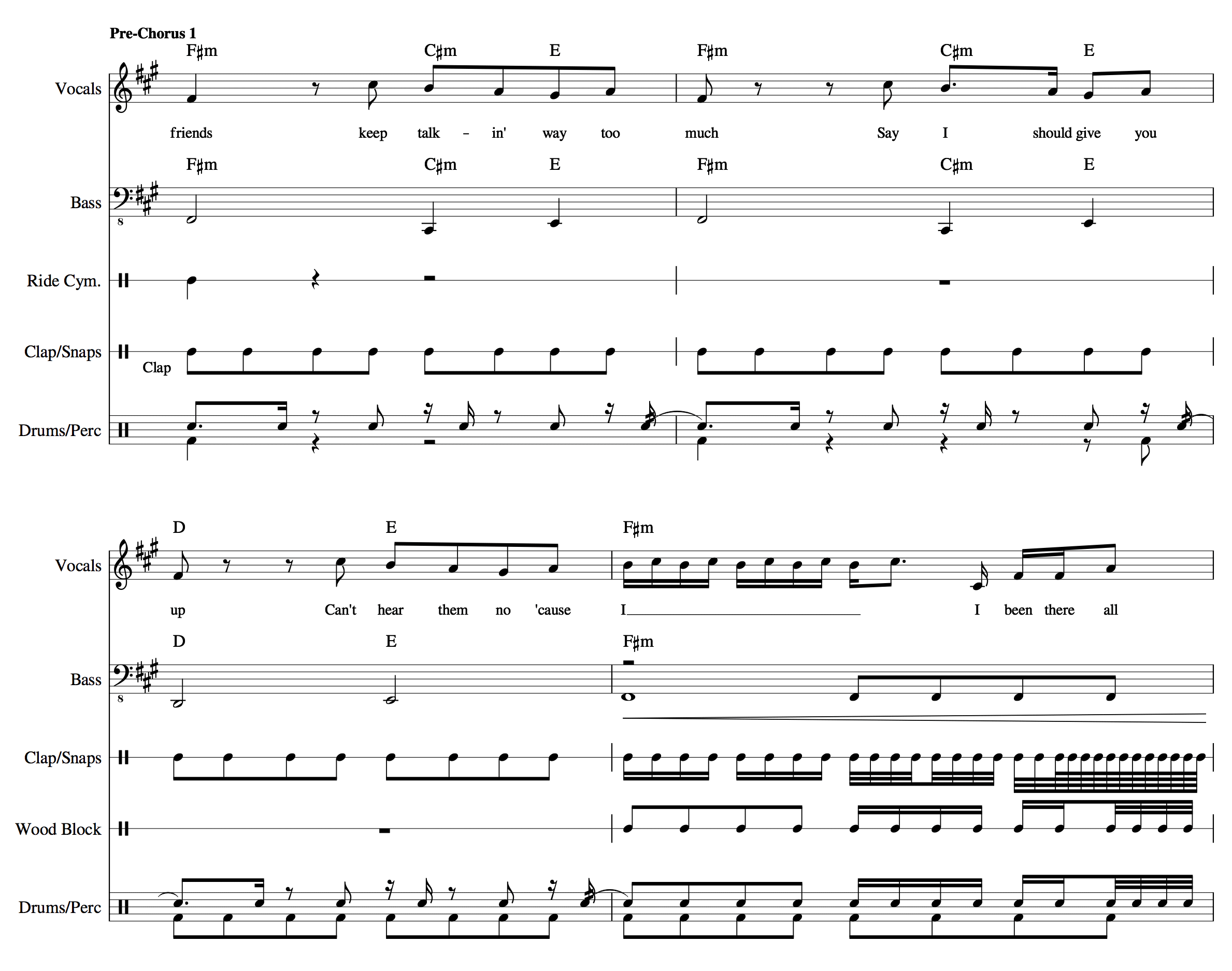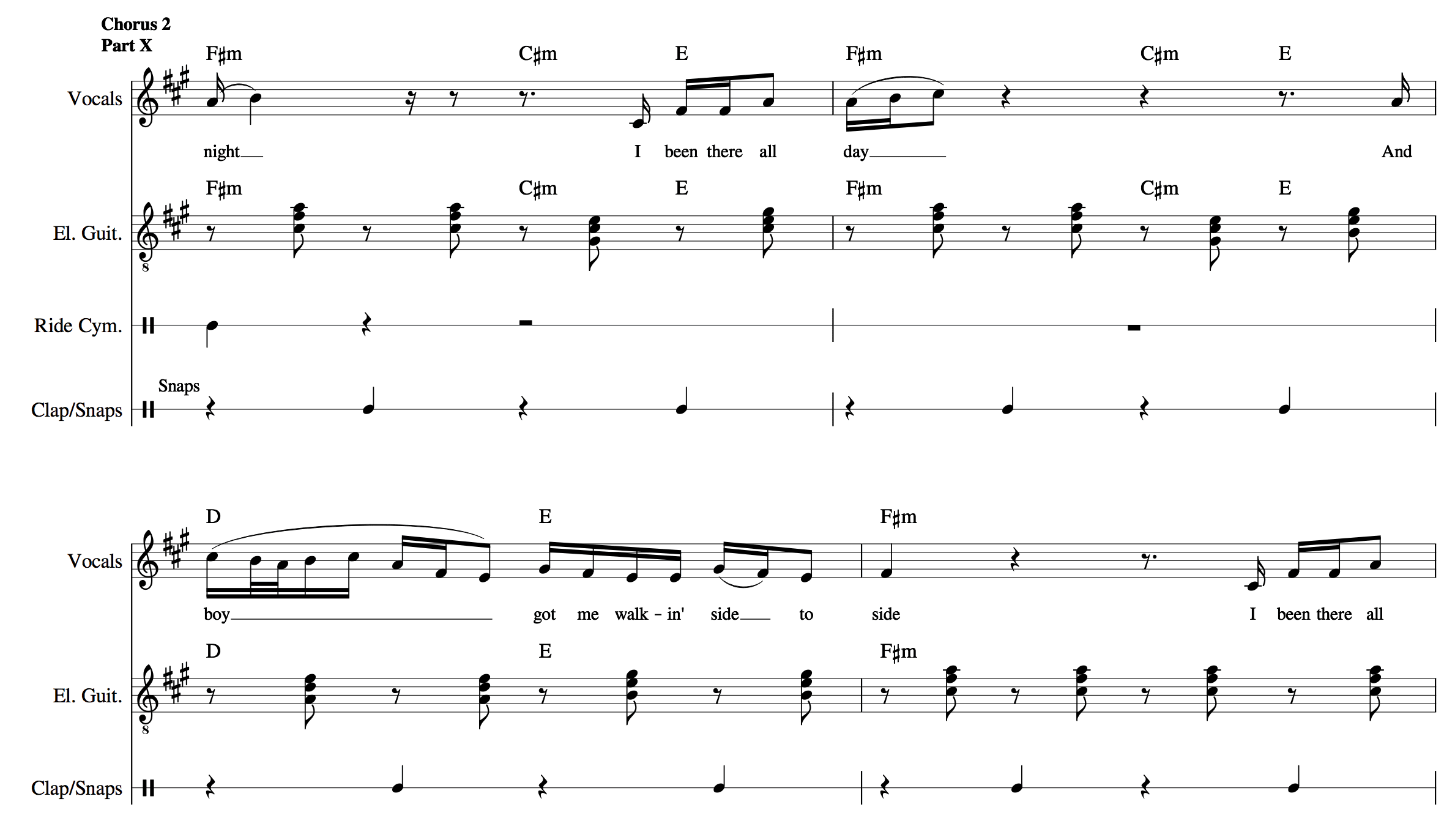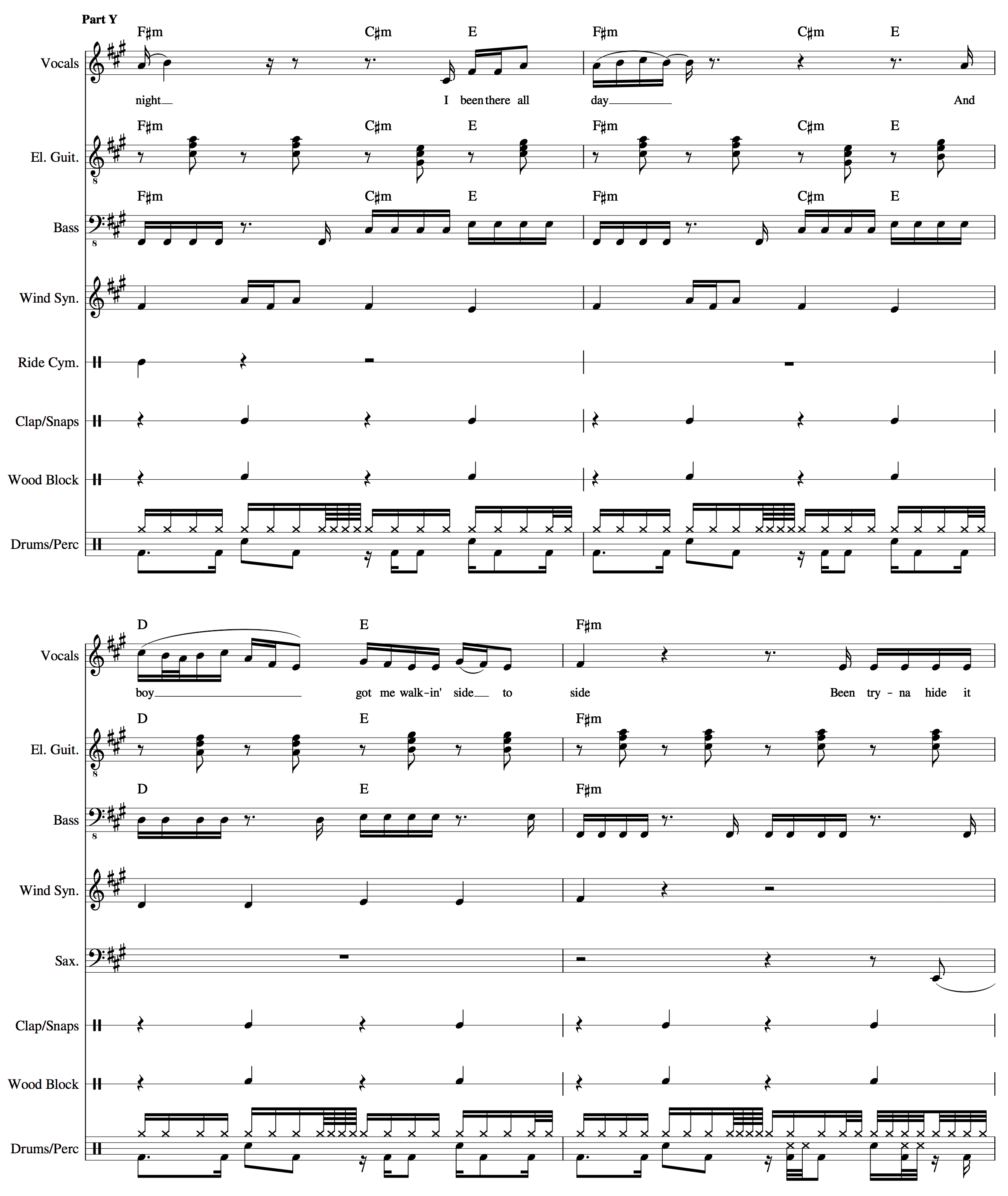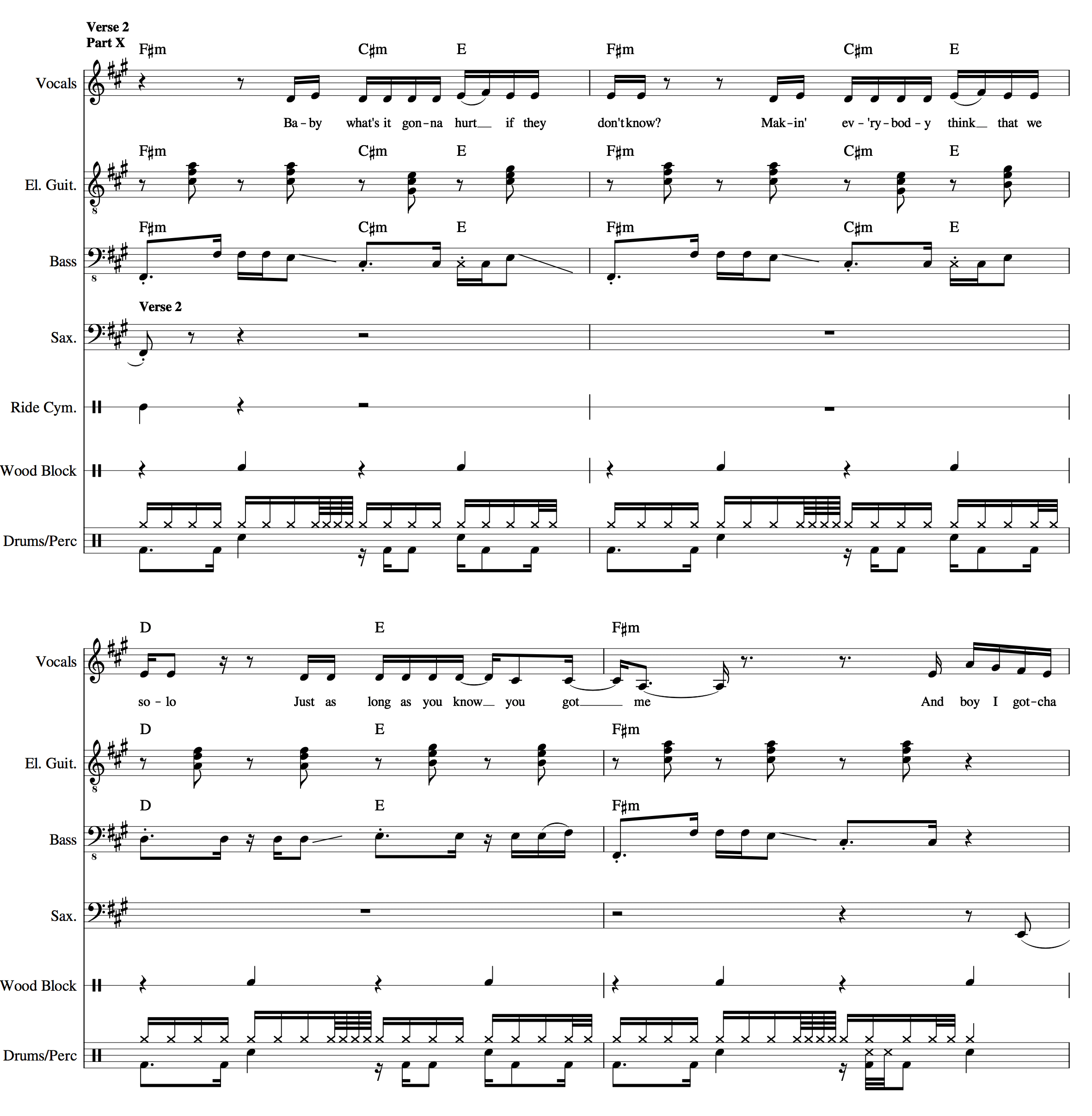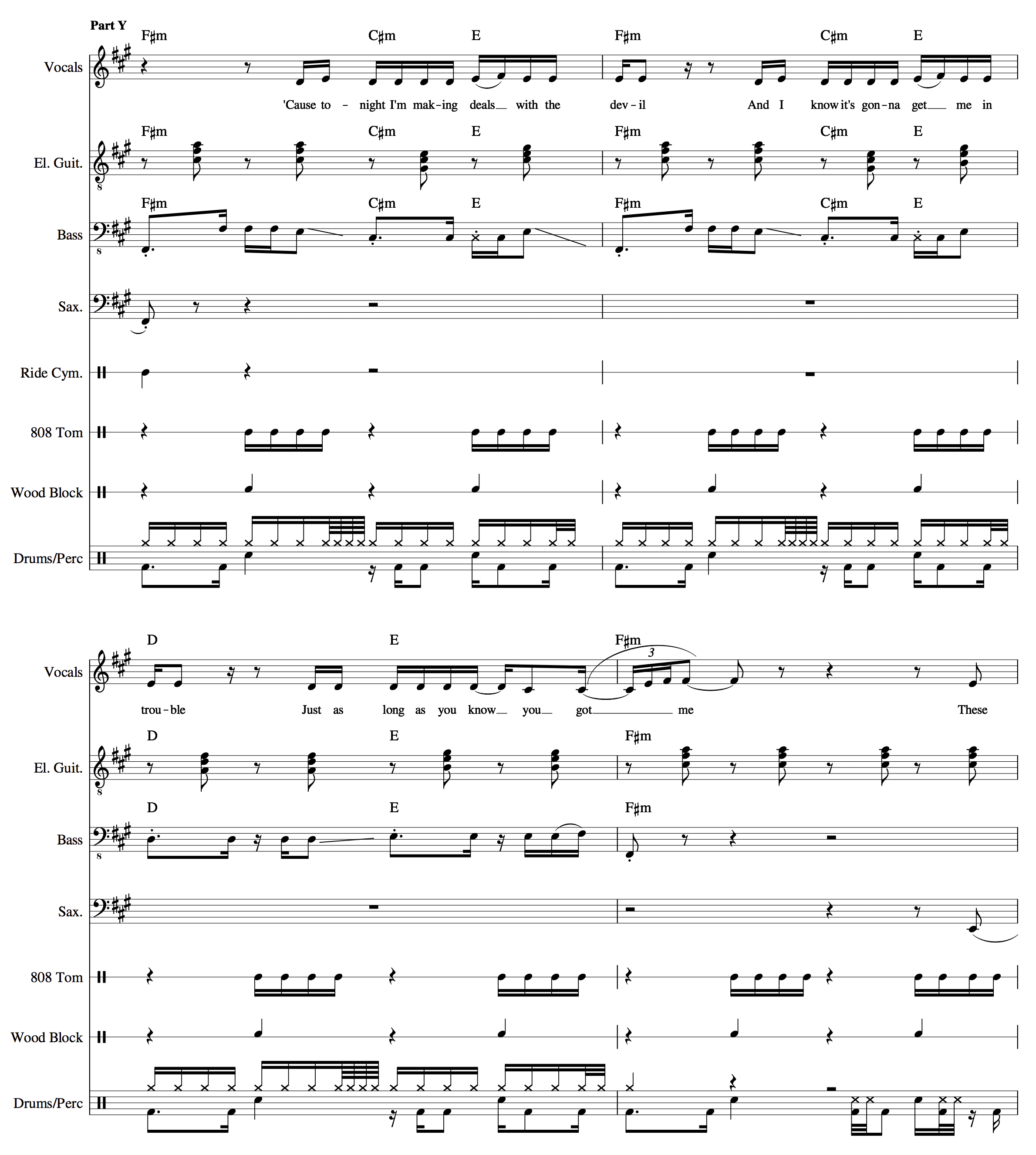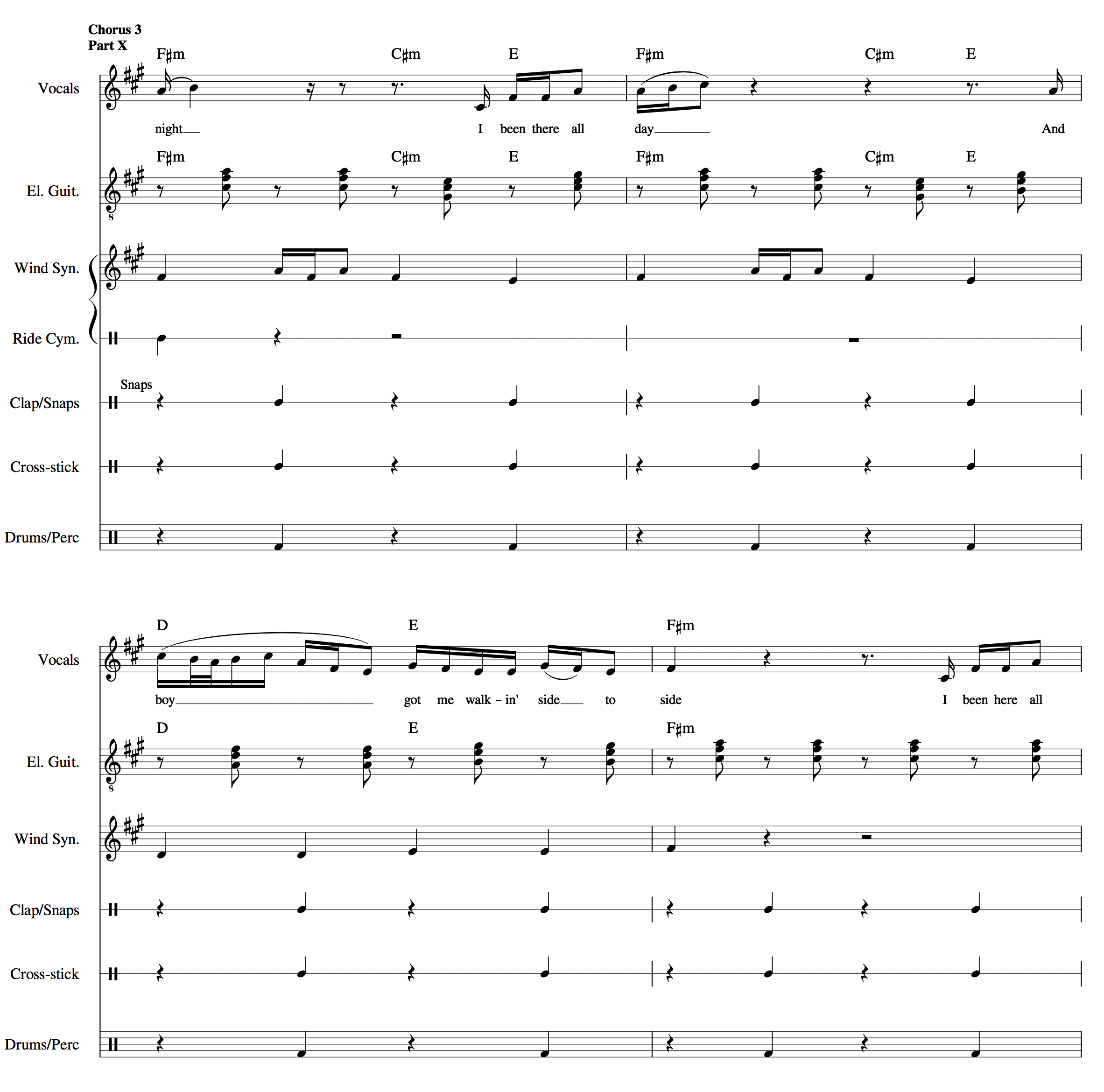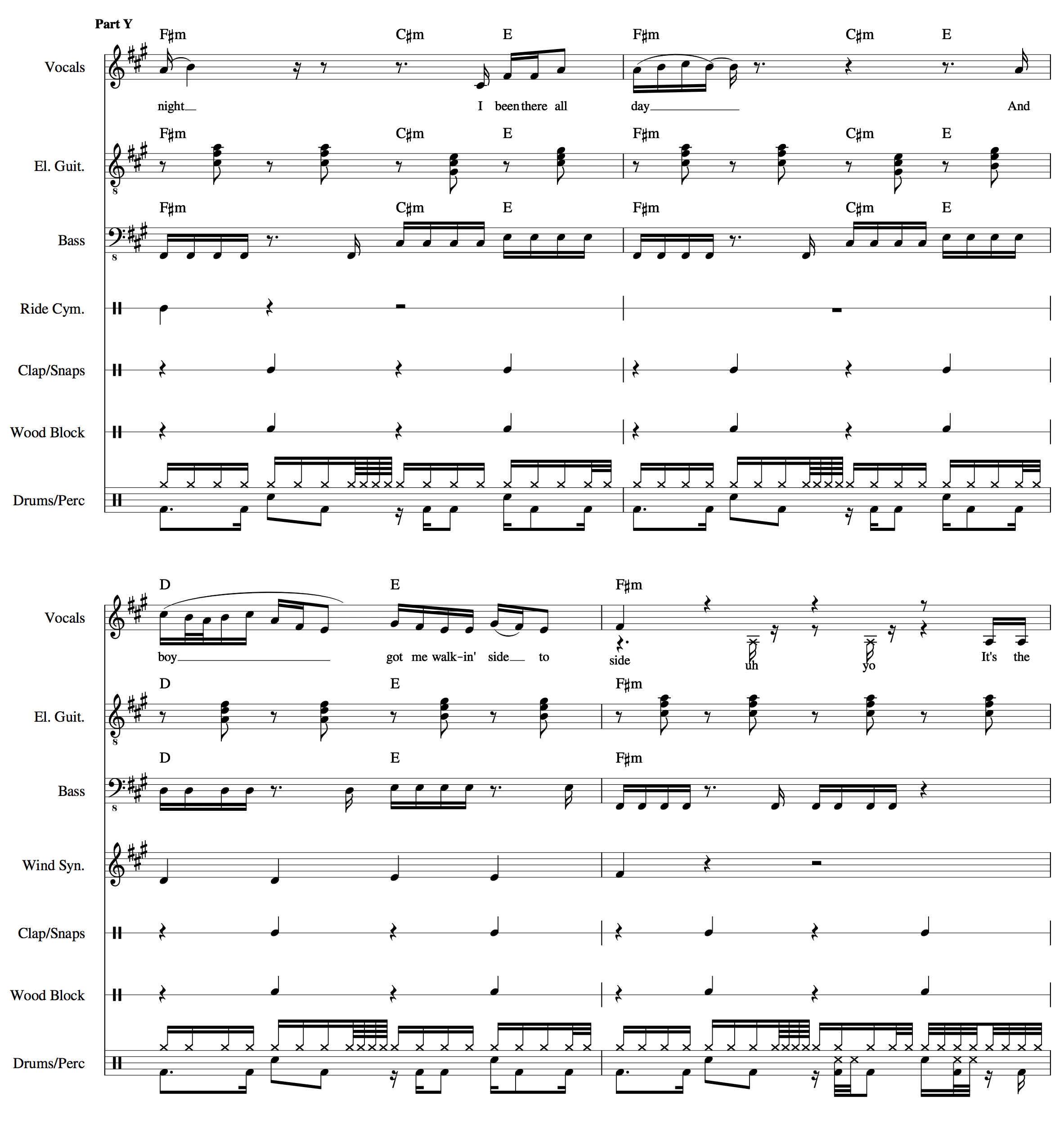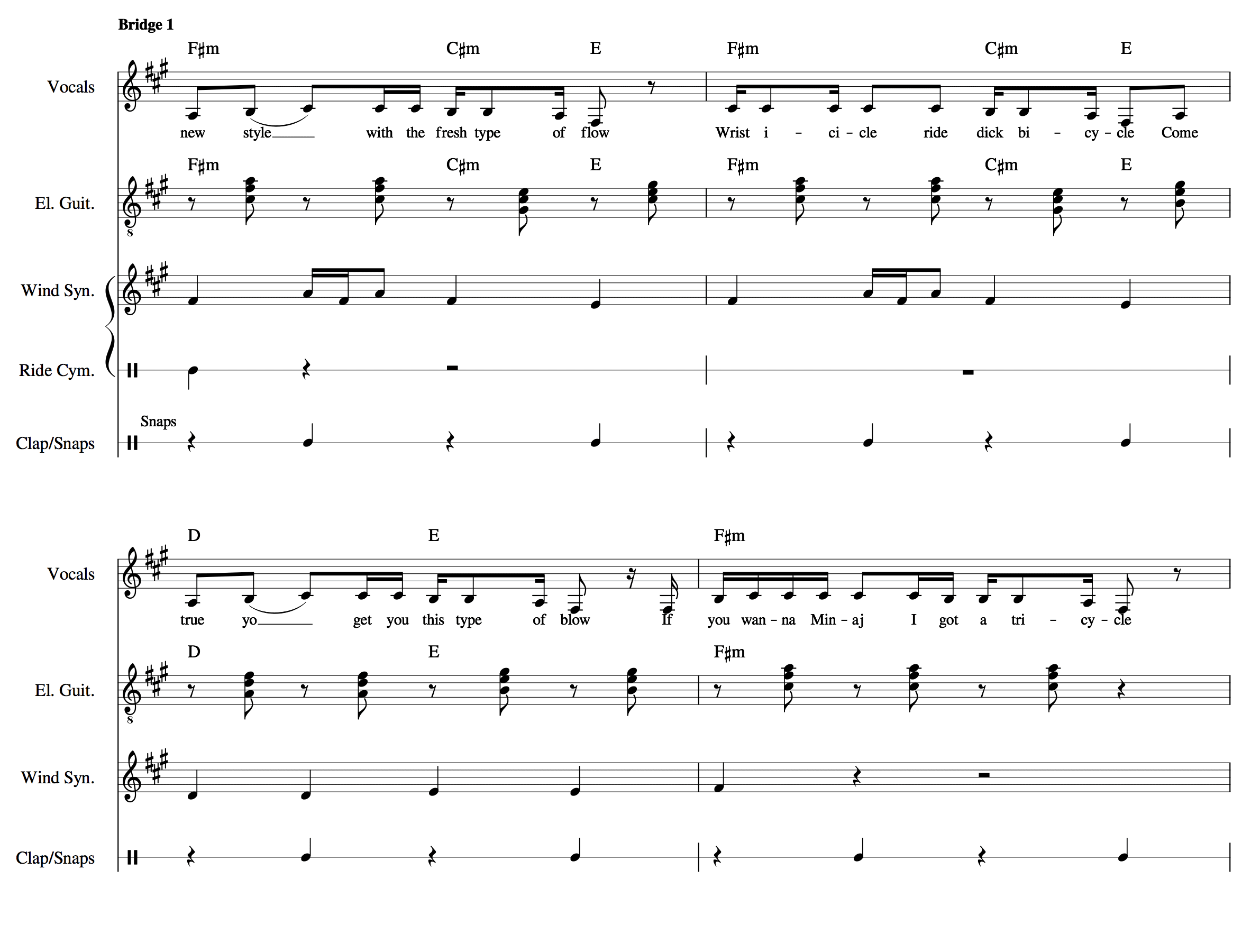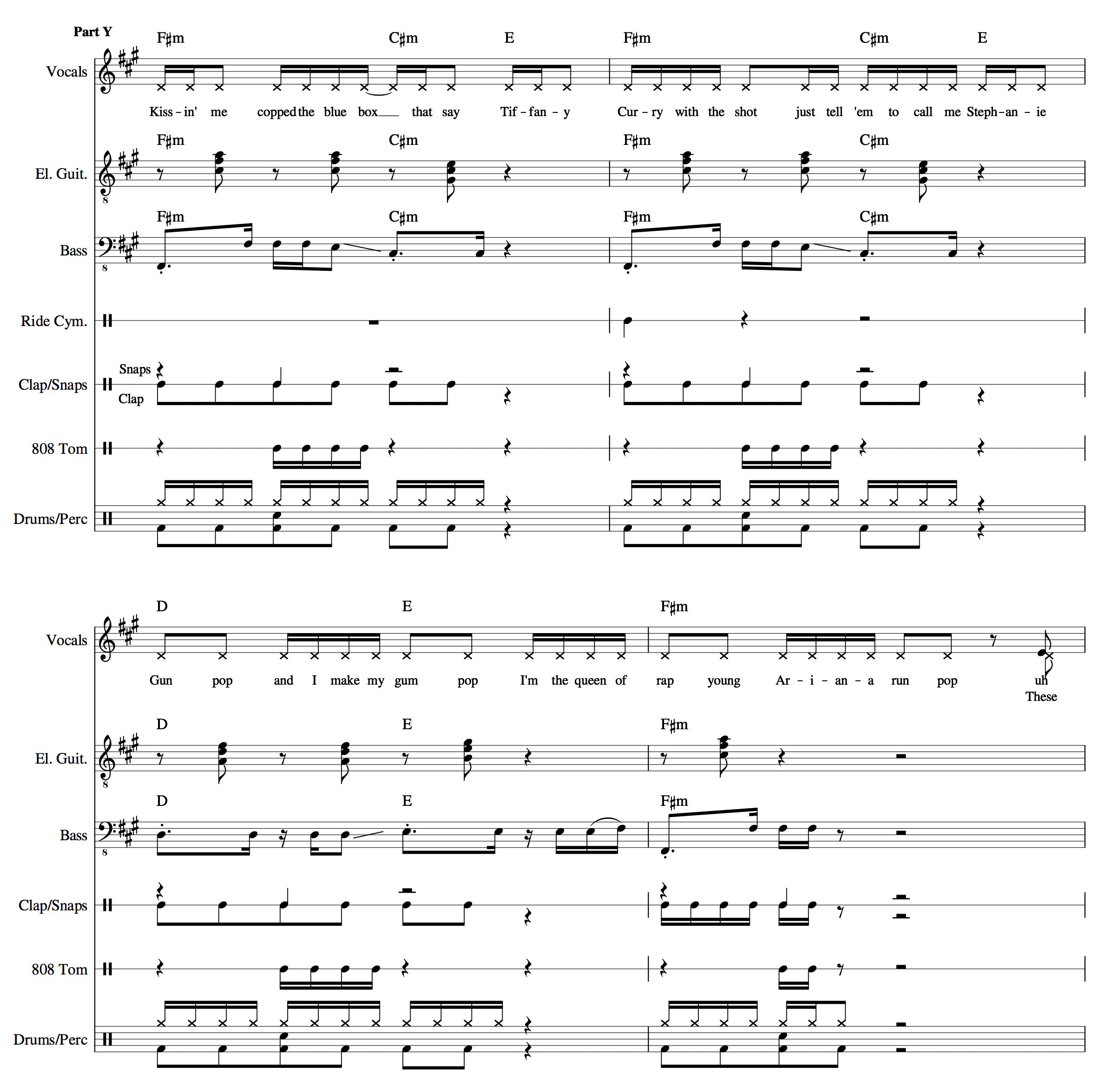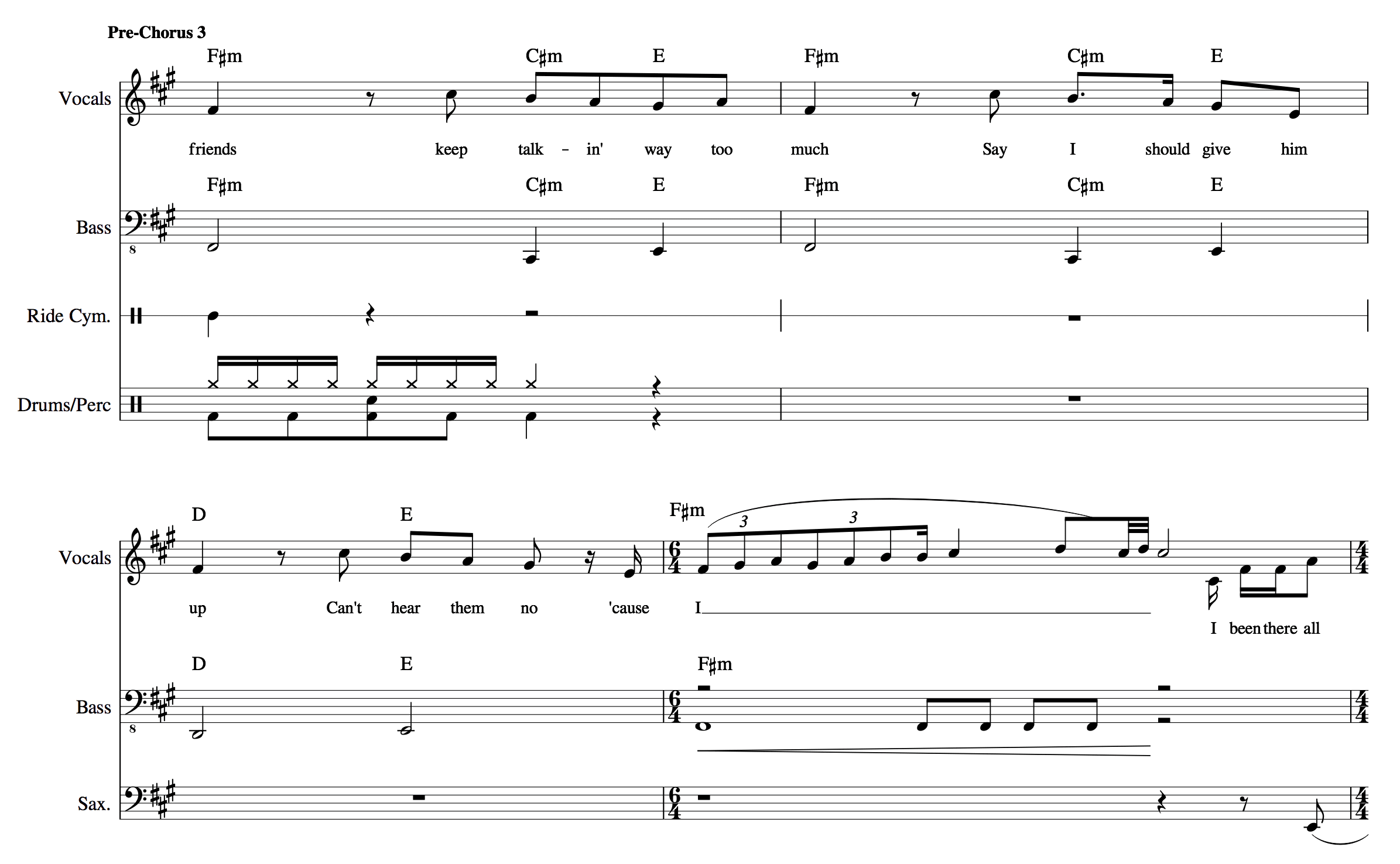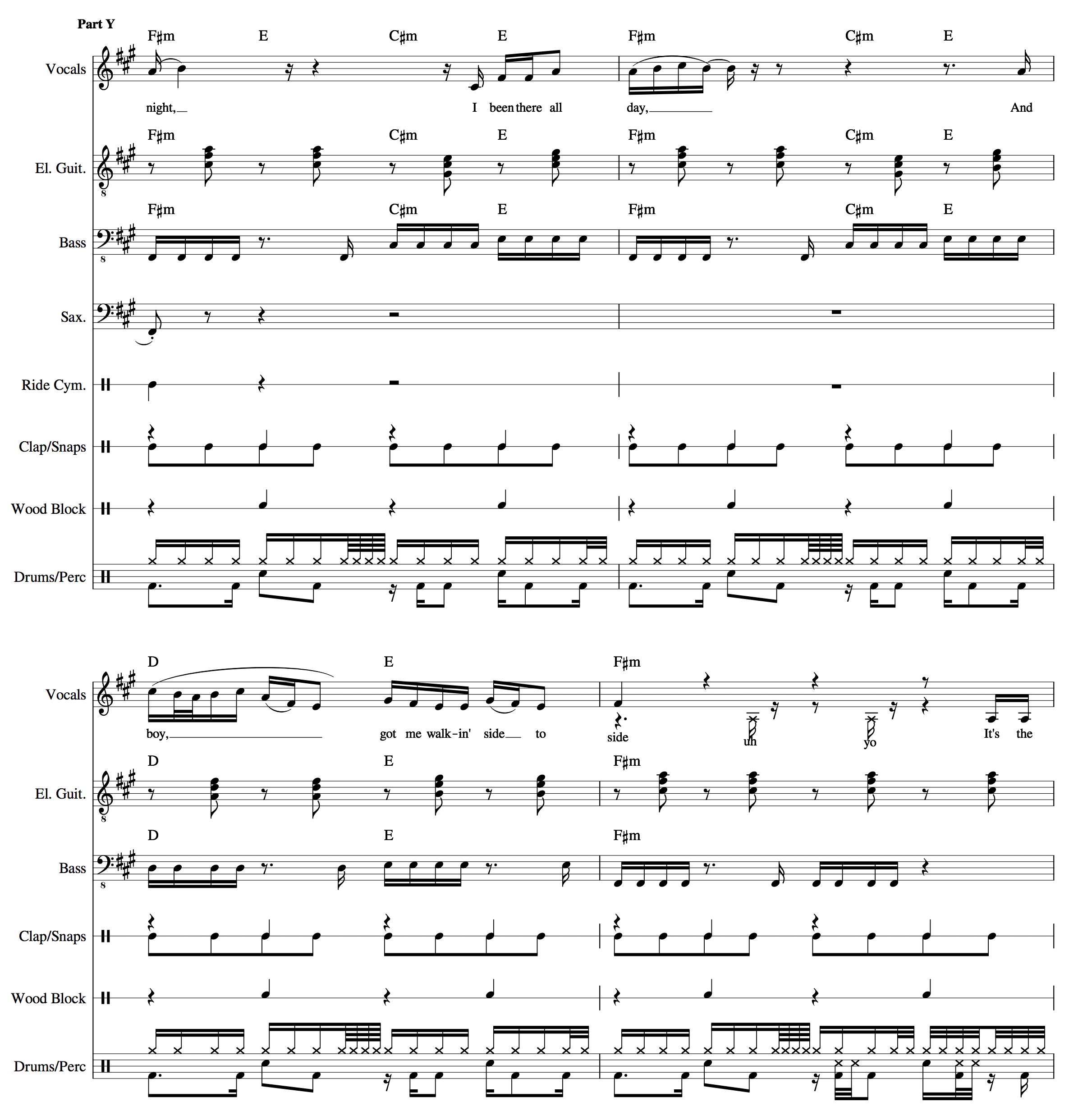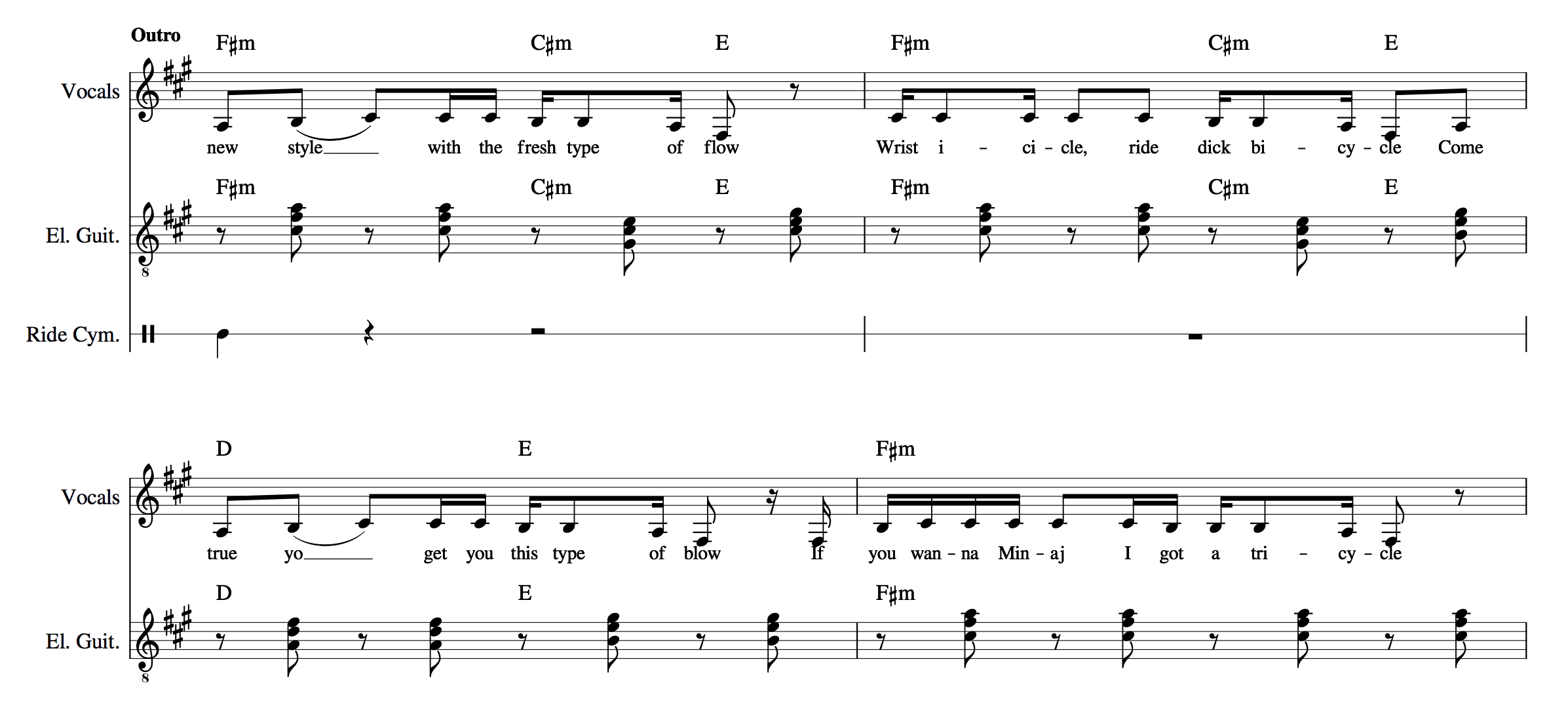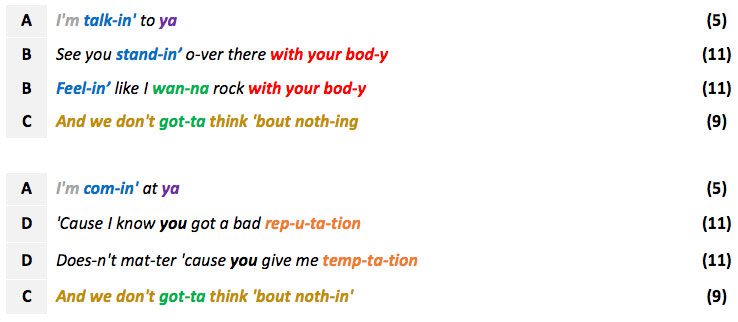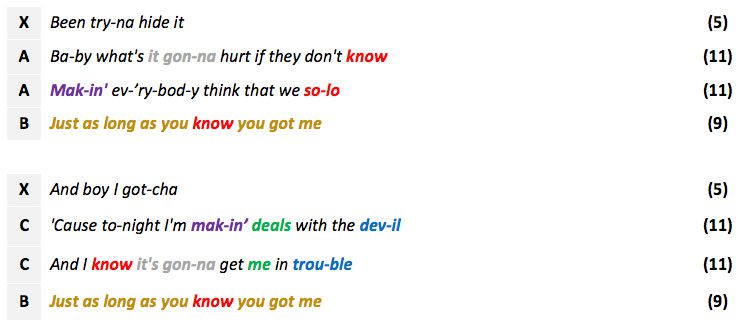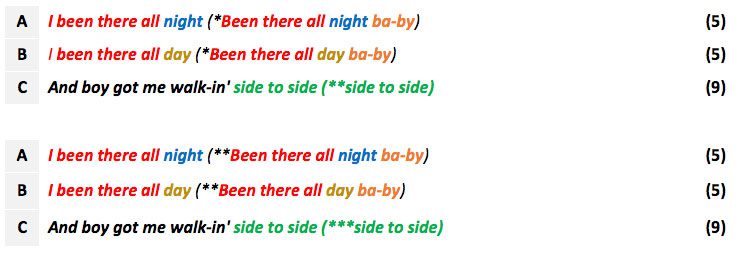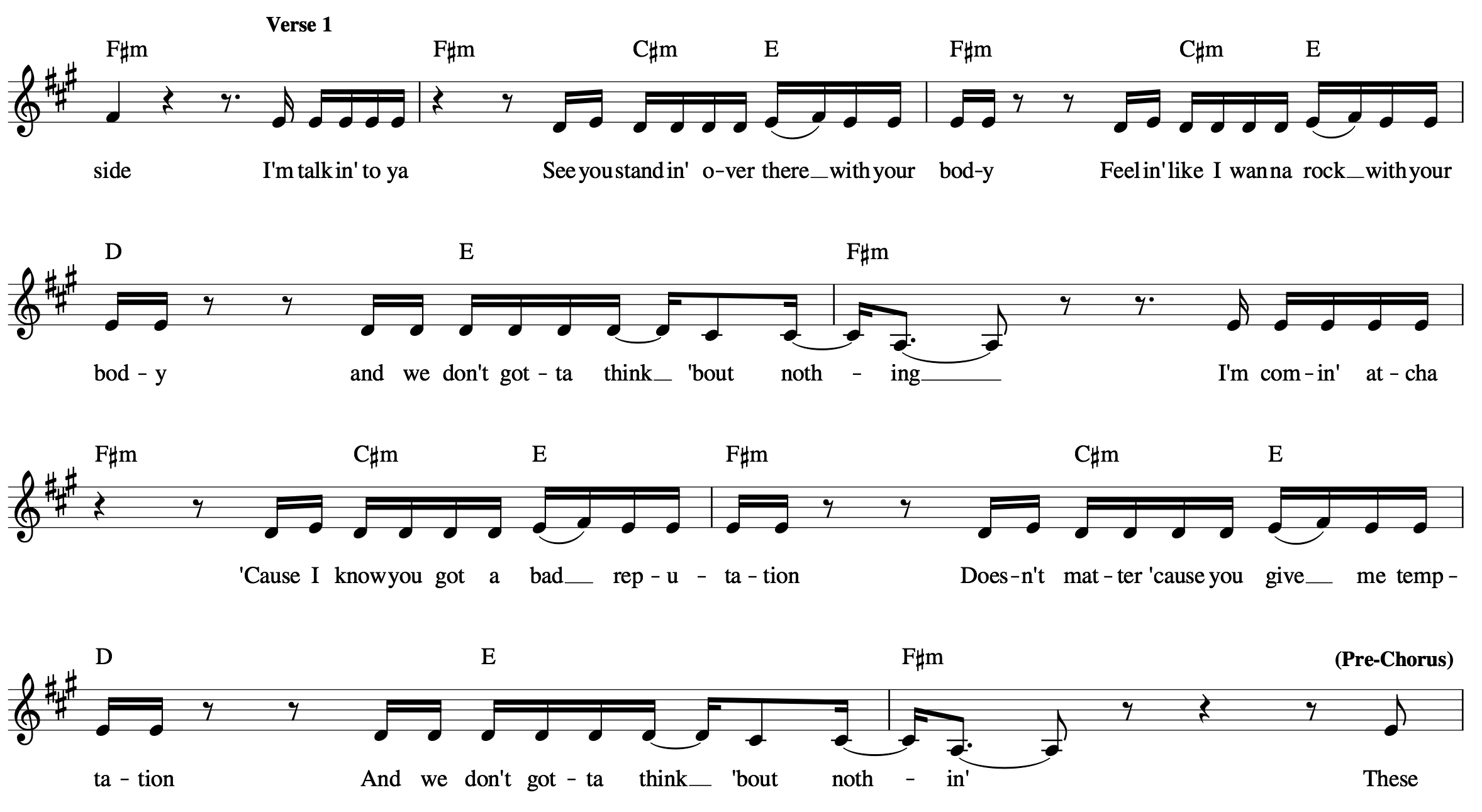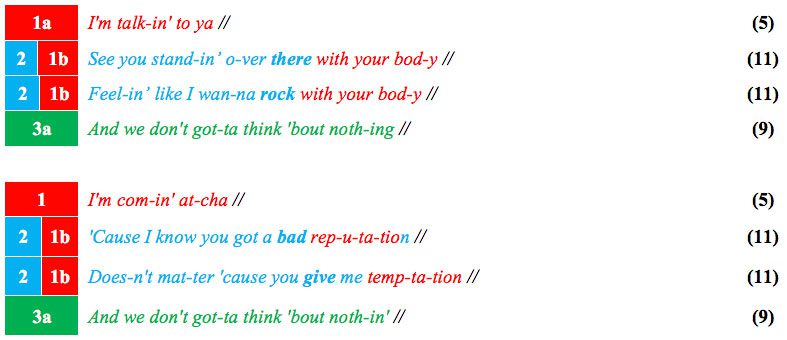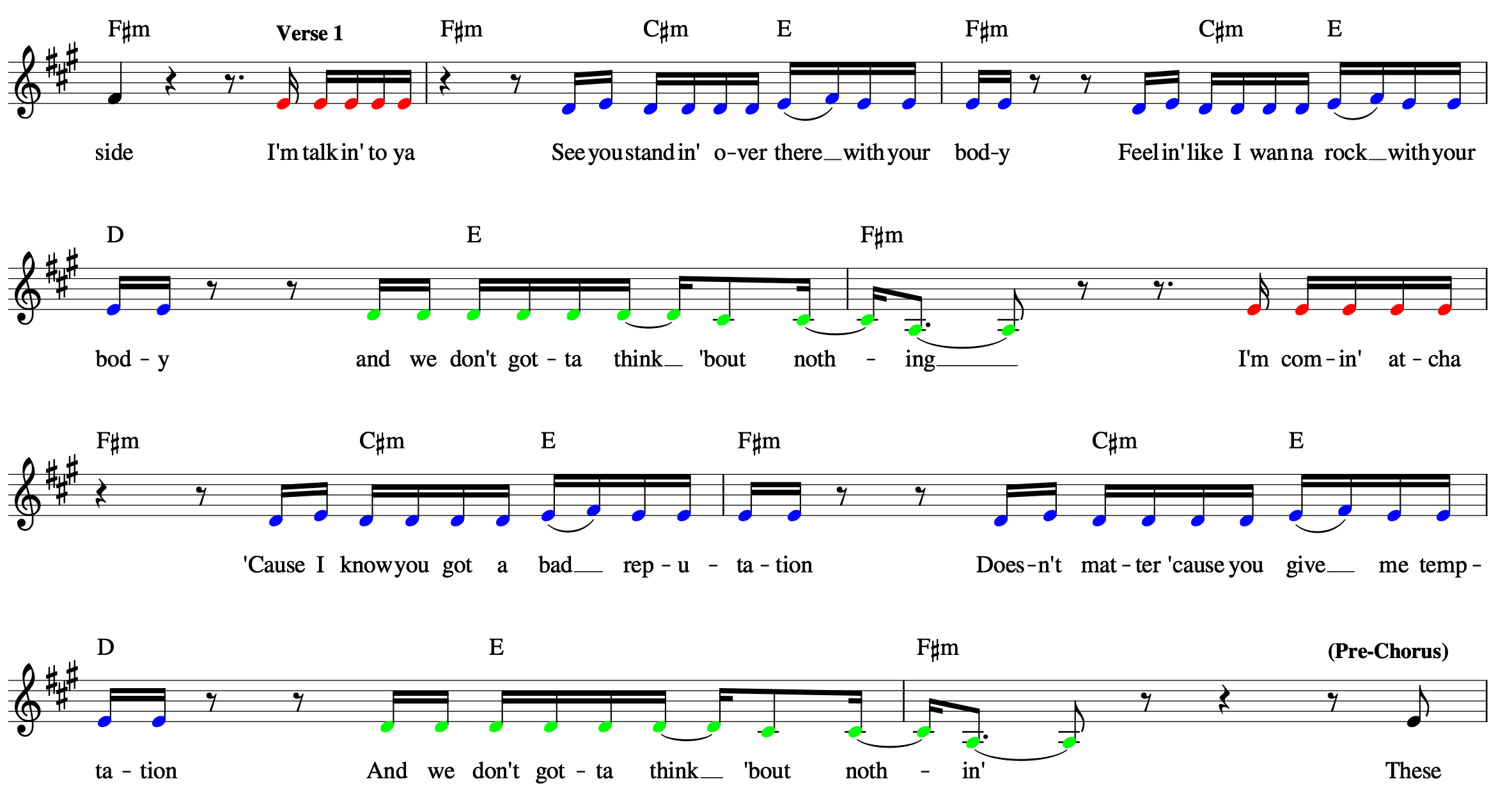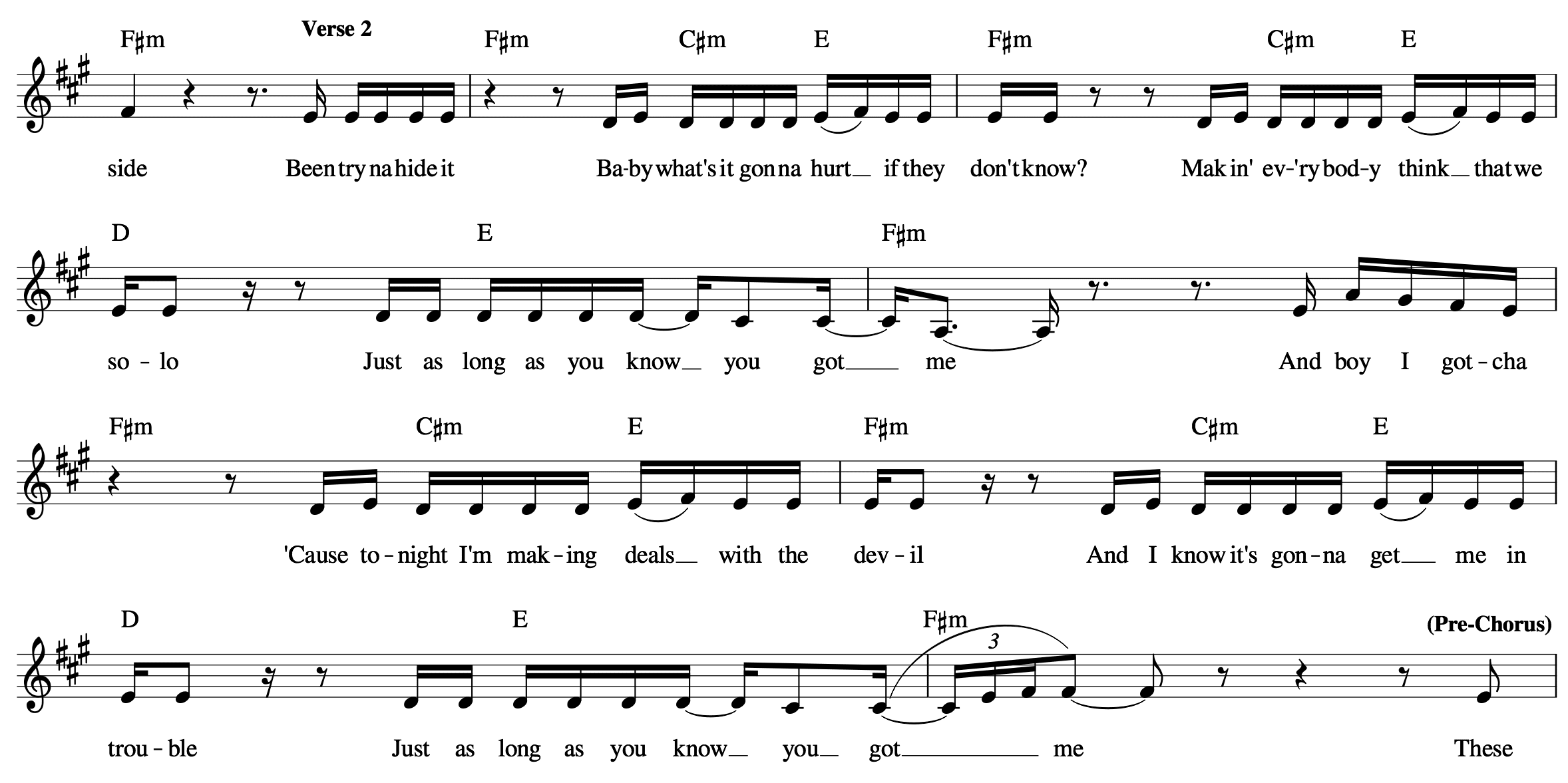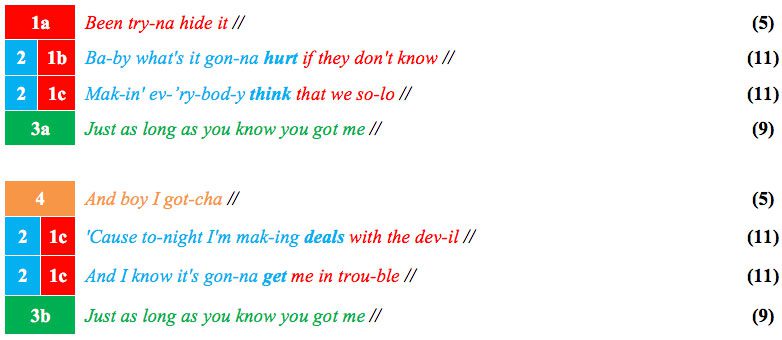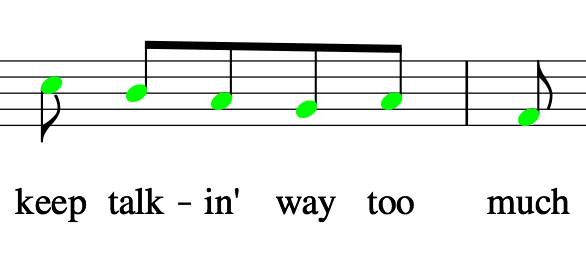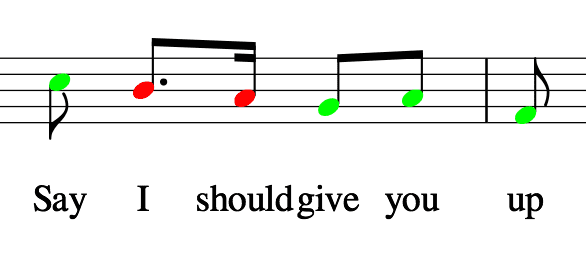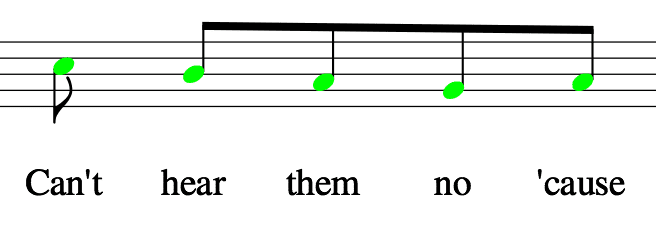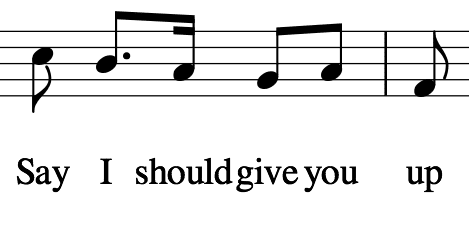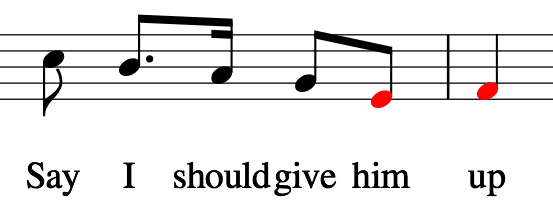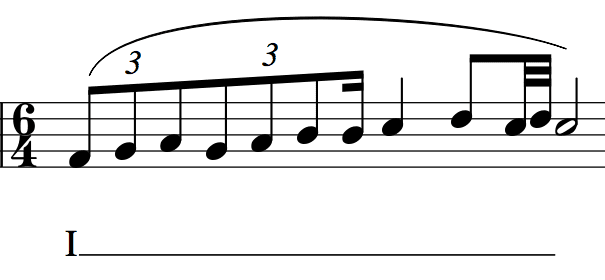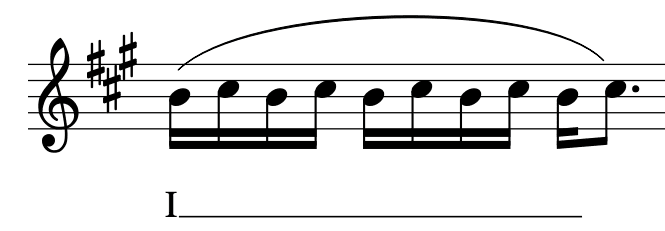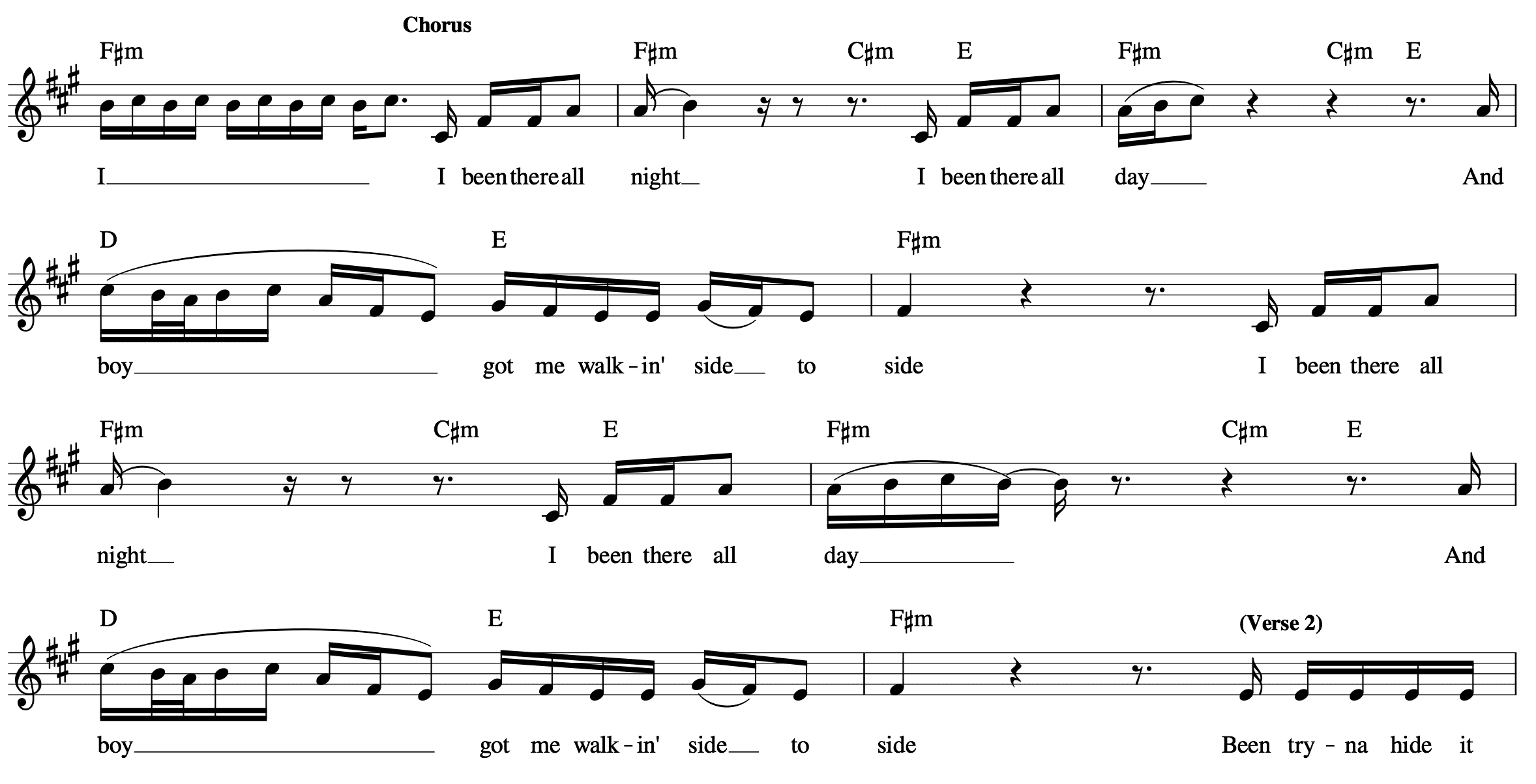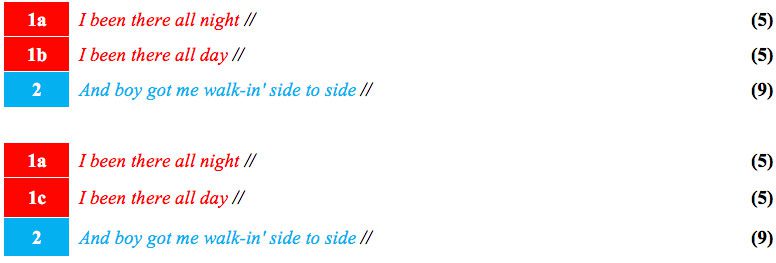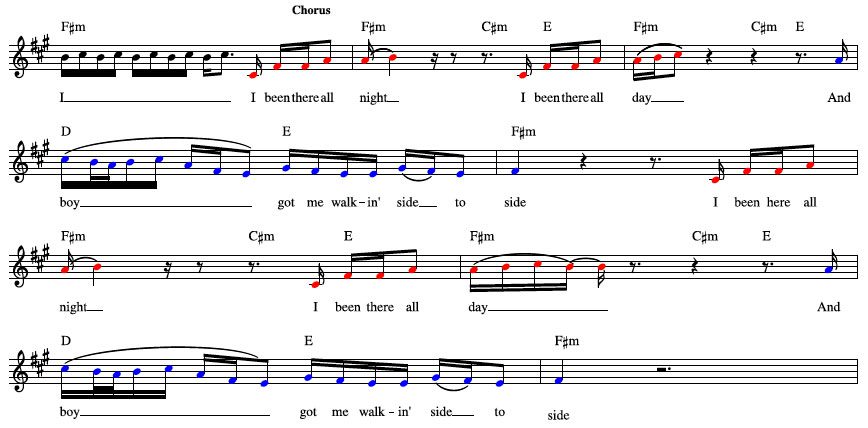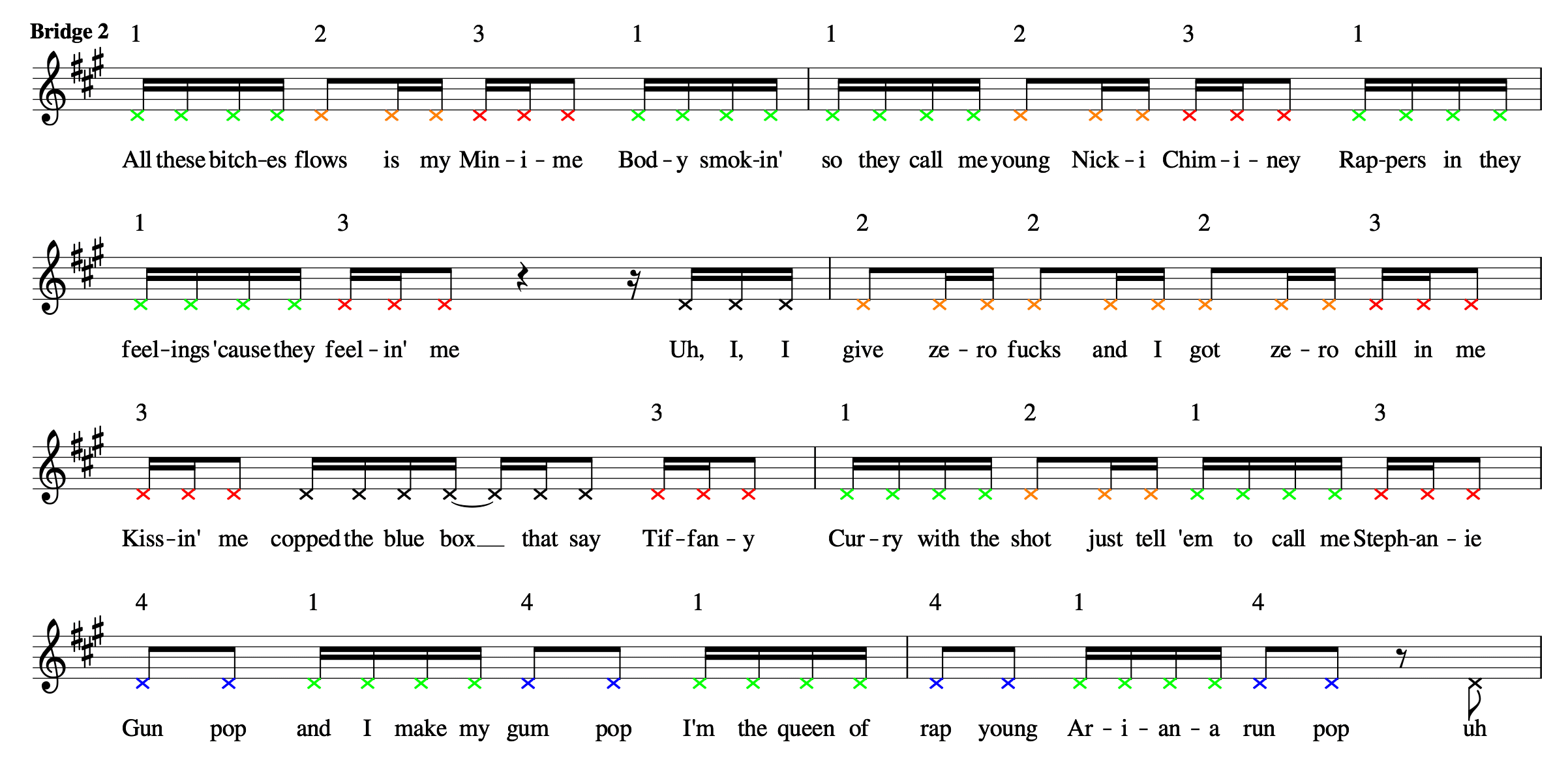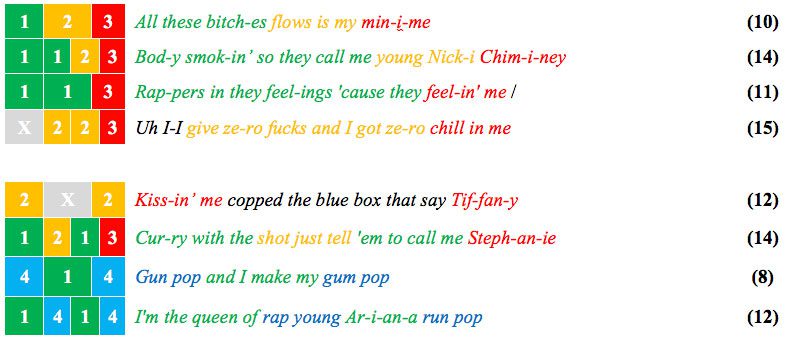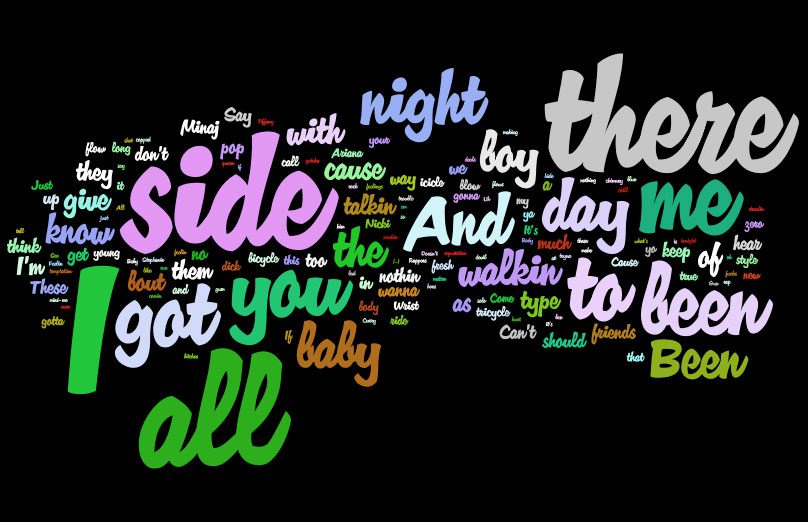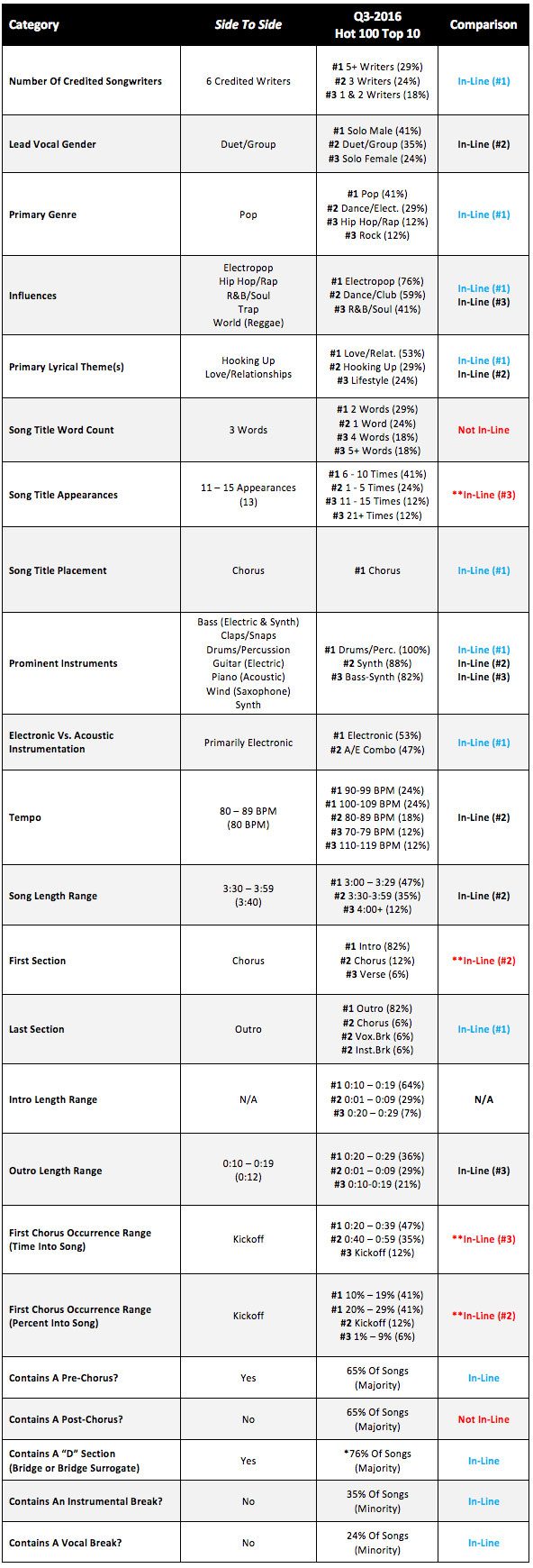To read this report, please log in.
Log inReleased in August 2016, Side To Side was the third single released from Ariana Grande’s third studio album, Dangerous Woman. Co-written by an all-star team of hitmakers, one of whom is Max Martin, Side To Side possesses an array of standout features that contributed to its success. To name a few, the song features a clever dual narrative, possesses an engaging blend of traditional Reggae and contemporary influences, and contains two bridges that provide an infectious twist by the song’s featured artist, Nicki Minaj.
Since its release, Side To Side has charted in the Top 10 on over 20 charts throughout the world.
Side To Side Deconstructed takes a deep dive into the songwriting and production techniques that helped make the song a global hit.
Overview, Highlights & Takeaways >>
Momentum/Tension/Intensity (MTI)/Energy/Waveform >>
At a Glance
Artist/Group: Ariana Grande featuring Nicki Minaj
Song: Side To Side
Songwriters: Alexander Kronlund, Ariana Grande, Ilya, Max Martin, Nicki Minaj, Savan Kotecha
Producer: Max Martin, IlYA
Record Label: Republic
Primary Genre: Pop
Influences: Electropop, Hip Hop/Rap, R&B/Soul, Trap, World (Reggae)
Length: 3:40
Full Form: B-A-PC-B-A-PC-B-C-C-PC-B-O
Key: F#m
Tempo: 80 BPM
First Chorus: Kickoff
Intro Length: N/A
Electronic vs. Acoustic: Primarily Electronic
Prominent instruments: Bass (Electric & Synth), Drums/Percussion, Guitar (Electric), Synth, Wind (Saxophone)
Primary Lyrical Theme(s): Love/Relationships, Hooking Up, Boasting
Title Appearances: Side To Side appears 13 times in the song
Lyrical P.O.V: 1st , 2nd, 3rd
Section Abbreviation Key
I=Intro
A=Verse
PC=Pre-Chorus
B=Chorus
C=Bridge
IB=Instrumental Break
VB=Vocal Break
T=Turnaround
O=Outro
As is typically the case with Top 10-charting hits (with the primary exception being some EDM-influenced songs), the chorus functions as Side To Side’s primary sectional payoff. Key aspects that make the section so infectious, engaging and memorable include:
Summation of the Narrative: It provides the summation of the lyrical content housed in the verse and pre-chorus sections, and culminates with the clever song title hook/payoff, “and boy got me walkin’ Side To Side.”
Similar But Different: Each iteration of the song’s four chorus sections possess a combination of similar and contrasting characteristics. As a result, the crux of the section gets firmly ingrained in the listener’s head, while the differences keep it fresh and engaging throughout the song.
Overview:
- Chorus 1: One stanza, sparse arrangement. It essentially functions as a chorus-based intro as it both introduces the listener to the song’s primary sectional payoff and plugs both artists featured in the song (i.e. Grande and Minaj). This version of the chorus is unique in the scope of the song.
- Chorus 2: Two stanzas, sparse first stanza/part X and full arrangement second stanza/part Y, additional background vocals, core accompaniment and lead vocal melody are the same as chorus 1.
- Chorus 3: Two stanzas, sparse first stanza/part X and full arrangement second stanza/part Y, more background vocals than chorus 2, core accompaniment and lead vocal melody are the same as chorus 2.
- Chorus 4: Two stanzas, both stanzas feature the full arrangement, more background vocals than chorus 3, core accompaniment and lead vocal melody are the same as chorus 3.
Effective Vocal Melody Structure: The lead vocal in each stanza of the chorus features an engaging combination of two similar melodic phrases (lines 1 and 2) followed by an infectiously prolonged melisma and the straightforward statement of the song title to conclude (line 3).
The K.I.S.S. (keep it simple and singable) melodic repetition of lines 1 and 2 helps to reinforce the melody in the listener’s head, while the “boy” melisma on line 3 provides an infectious dose of color and enables Grande to show off her vocal chops. The simplified statement of “side to side” at the end ensures that the song title connects and resonates with the listener.
Engaging Call & Response Interplay: Choruses 2, 3 and 4 all feature some degree of vocal and/or vocal/instrumental call & response interplay. This both takes the impact of each of these sections to a heightened level as well as in reinforcing key lyrical content.
Examples:
Vocal Call & Response
Chorus 2, 3, 4: “And boy got me walkin’ side to side (side to side)”
Chorus 3, 4: “I been there all night (Been there all night baby)”
Chorus 3, 4: “I been there all day (Been there all day baby)”
Vocal/Instrumental Call & Response
Chorus 3, 4: The interaction between Grande’s vocals and the subtle woodwind-esque synth hook provide an infectious call and response characteristic:
“I been there all night”
(synth hook)
“I been there all day”
(synth hook)
“And boy got me walkin’ side to side (side to side)”
A=Intro, PC=Pre-Chorus, B=Chorus, C=Bridge, O=Outro
Form: B / A – PC – B / A – PC – B / C1 – C2 / PC – B – O
Side To Side kicks off with an abbreviated first chorus and is directly followed by a 2x repeat of a verse – pre-chorus – chorus sectional progression. Following the second chorus, two differentiated back-to-back bridge sections ensue (both featuring vocals by the song’s featured artist – Nicki Minaj), followed a pre-chorus – chorus – outro sectional progression which brings the song to its conclusion.
In addition to the A – PC – B sectional progression, there are a couple of other sectional progression commonalities that heighten familiarity within the scope of the song, thus making it more memorable:
PC – B: Occurs three times within the song – toward the beginning, near the middle, and toward the end.
B / A – PC – B / A – PC – B / C1 – C2 / PC – B – O
PC – B – C/O: With the exception of C-2, the second-half of the song technically consists of a pre-chorus – chorus – bridge 1 progression. Note that the outro (O) features the core vocals from bridge 1 (C-1) plus additional vocals from the preceding chorus.
B / A – PC – B / A – PC – B / C1 – C2 / PC – B – O
Section Length: With the exception of the third pre-chorus, all of the full sections in Side To Side land at either 12 seconds / 4 bars (pre-chorus 1, 2, chorus 1, bridge 1, outro) or 24 seconds / 8 bars in length (verses, chorus 2, 3, 4, bridge 2). Pre-chorus 3 is 2 beats / 1 second longer than the other pre-choruses.
Engagement Accentuation: The aforementioned ~24 second / 8 bar sections are broken into two shorter ~12 second / 4 bar stanzas, each of which possesses a differentiated characteristic compared to the other. As a result, new elements enter the mix frequently throughout the song, which accentuate the overall engagement factor (i.e. the listener never gets bored with cookie-cutter repetition).
Sectional Time Allocation: The majority of time within Side To Side is allocated to the chorus, which comprises 39% of its total composition. The verse follows at 22%, and the pre-chorus and bridge account for 17%, each. The outro comprises the least amount of time in the song, accounting for 6%. Furthermore, 77% of the song features Ariana Grande at the helm, and 23% features Nicki Minaj.
First Chorus Appearance: Side To Side immediately kicks off with an abbreviated (one-stanza) chorus.
The outro is a reversion back to the solo Reggae guitar accompaniment from the first chorus, which essentially brings the song full-circle. It is the only section in the entire song that features concurrent vocals from both the primary artist (Ariana Grande) and featured artist (Nicki Minaj). Grande sings the background vocal lyrics from the chorus (“been there all night…”) while Minaj sings the lyrics from bridge 1. As a result, both narratives cleverly intertwine, providing both artists with one last opportunity to shine as the song comes to a conclusion.
Pre-chorus 3 is markedly different than pre-choruses 1 and 2. It possesses a much more subdued and sparse arrangement, which heightens the overall engagement value of the song due to the pronounced “like section” and cross-section” contrast imparted. However, the core vocal melody remains the same which keeps the memorability factor at a high.
Additionally, it features a changed up “I” vocal melisma at the end which is prolonged for two additional beats. This takes the tension and anticipation of the section to a climax as the song heads into the powerful fourth (and last) chorus section.
Side To Side progresses through four MTI/Energy level “waves.” Each wave begins with a relatively low energy level and progresses to an energy level peak. Each wave concludes with an energy level peak except for the last (wave 4), where the energy level is brought back down in the outro.
- Wave 1: Chorus 1 – Chorus 2
- Wave 2: Verse 2 – Chorus 3
- Wave 3: Bridge 1 – Bridge 2
- Wave 4: Pre-Chorus 3 – Outro
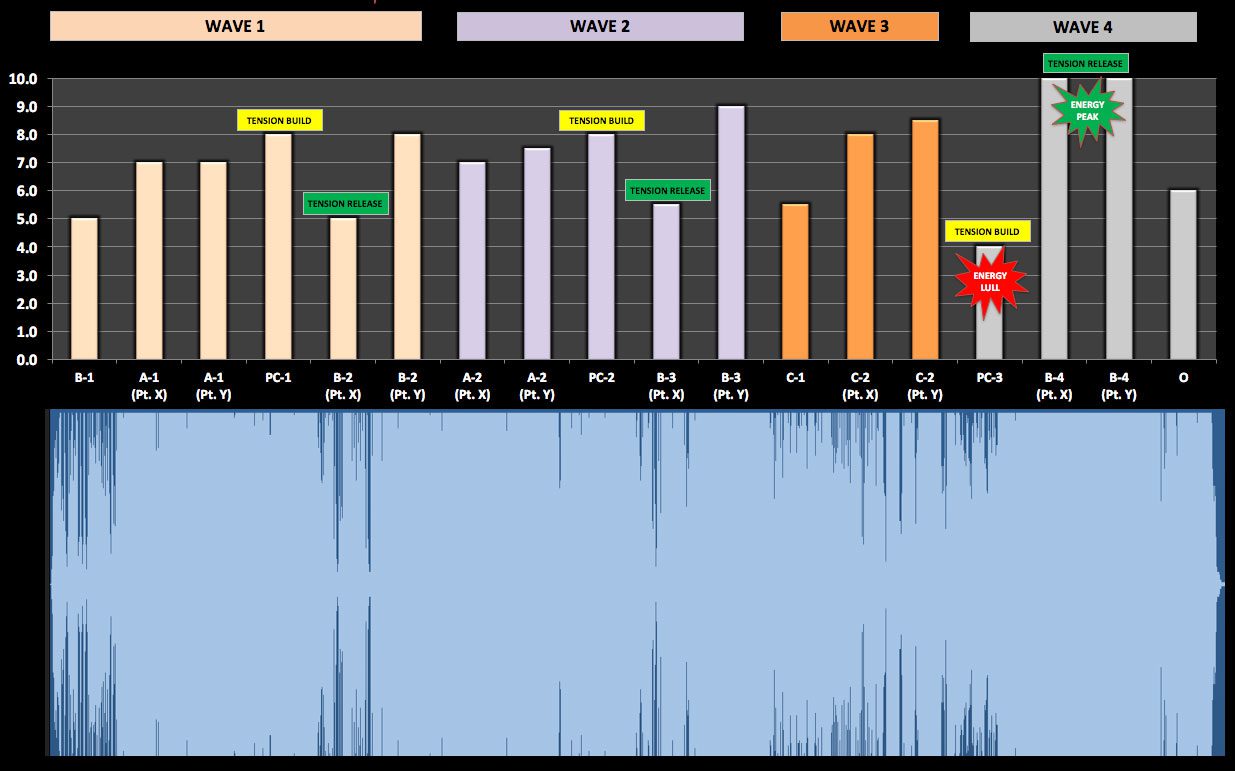


Each low-energy section in the song save for the first chorus is bookended by a high-energy section, which provides the song as a whole with a very engaging dynamic flow. This transpires both within MTI/Energy level waves and across waves as well:
- Occurrence 1: The low-energy/breakdown chorus 2 part X is bookended by the high-energy/full accompaniment pre-chorus 1 and chorus 2 part Y.
- Occurrence 2: The low-energy/breakdown chorus 3 part X is bookended by the high-energy/full accompaniment pre-chorus 2 and chorus 3 part Y.
- Occurrence 3: The low-energy/breakdown bridge 1 is bookended by the high-energy/full accompaniment chorus 3 part Y and bridge 2.
- Occurrence 4: The low-energy/breakdown pre-chorus 3 is bookended by the high-energy/full accompaniment bridge 2 part Y and chorus 4 part X.
Pre-chorus 3 features the lowest overall energy level in the entire song. This is warranted considering that it is both preceded and followed by the longest periods of sustained intensity in the scope of the song (i.e. all of bridge 2 and all of chorus 4, which has full accompaniment the entire time, not a breakdown first stanza/part X). It provides the listener with a dynamic breather, and functions to set up the high-intensity chorus that follows for maximum impact due to its dynamically contrasting characteristic.
Side To Side is a Pop song that features five main influences – Electropop, Hip Hop/Rap, R&B/Soul, Trap and World (Reggae). These influences are present in the characteristics of the vocals, backing music, or both, in varying levels of prominence throughout the song.
Key
Small x: Minimal influence
Medium X: Pronounced influence
Big X: Major influence
-: No influence
/: Divides the first half of the section from the second
Side To Side is composed of three primary lyrical themes – hooking up, love/relationships, and boasting. It features two independent narratives – one conveyed by the song’s primary artist, Ariana Grande, and one conveyed by the song’s featured artist, Nicki Minaj:
- Grande’s narrative, which defines the verse, pre-chorus and chorus sections, features love/relationship and hooking up lyrical themes. It’s about a woman who is in a physical relationship with a “hot bad boy,” whom she continues to see despite her friends’ objections – ultimately because the sex is so good (which is cleverly communicated by the song title payoff/summation, “Side To Side”).
- Minaj’s narrative, which defines bridge 1 and bridge 2, features a combination sexual innuendo and boasting about her flows, looks, and stature of herself and Grande in the mainstream.
Both narratives cleverly intertwine in the outro, providing Grande and Minaj with an opportunity to shine together as the song comes to a conclusion.
The song is communicated in the past and present tense from a first, second and third person P.O.V.
Side To Side is a clever, attention-grabbing title that takes on a whole new meaning when viewed in context with the full narrative. It appears 13 times throughout the song, in both the chorus and outro sections.
Side to Side features a plethora of different vocal characteristics that take its impact to a heightened level. They include rapped, sung, spoken, shouted, single-voiced, multi-voiced group, large choir-like mixed gender group, and more in a variety of combinations throughout.
Key
S: Sung
R: Rapped
SP: Spoken
SH: Shout
-/-: First Stanza/Second Stanza
The vocal melody in Side To Side spans F#3 to D5. It features an engaging combination of K.I.S.S.- principled runs (Keep It Simple and Singable), infectious melismas that showcase Grande’s vocal chops, and a combination of sung and rapped deliveries. Ample repetition ensures that each section’s melody gets firmly ingrained in the listener’s head, while just enough contrast is imparted to keep things fresh and engaging.
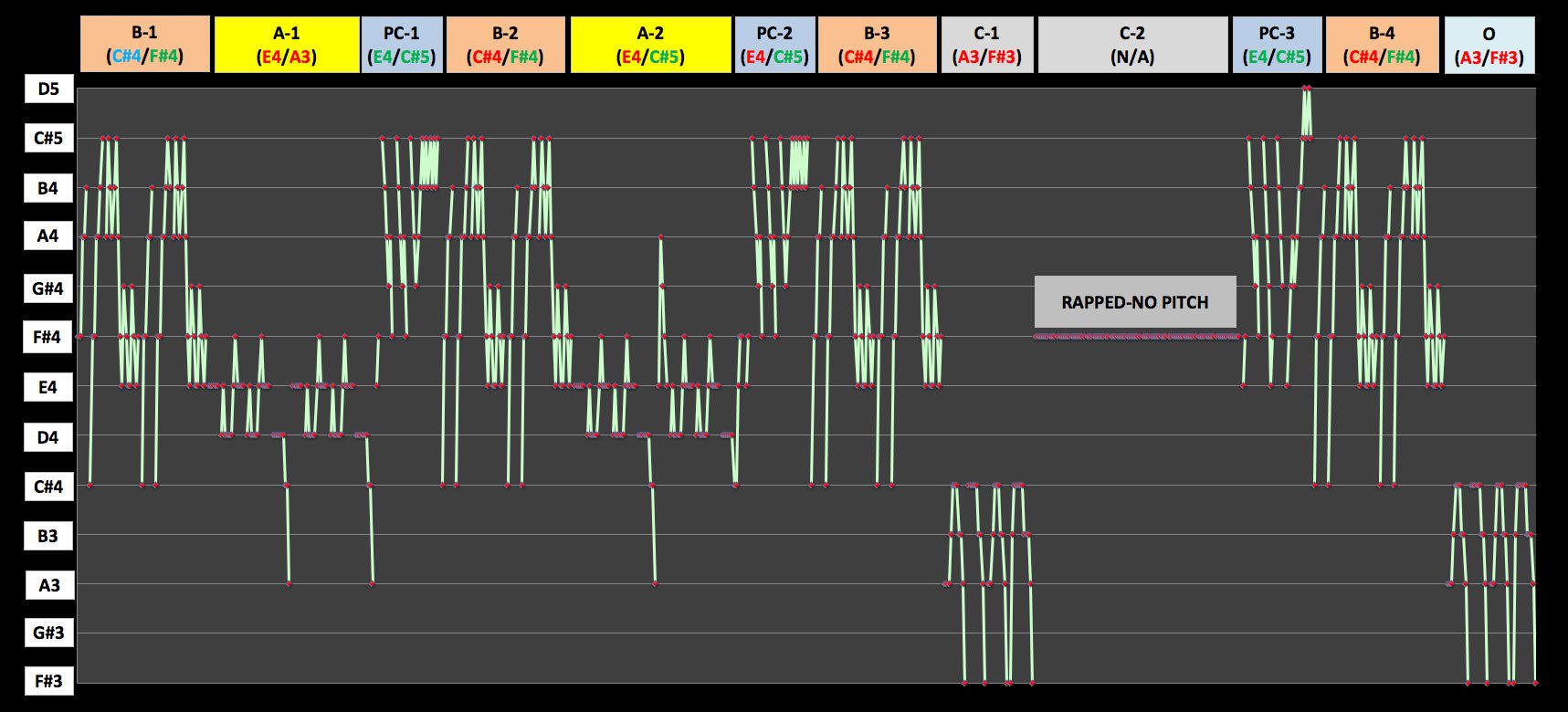


Pre-Chorus (e.g. Pre-Chorus 1)





Chorus




Bridge 1



What follows is a breakdown of the melodic structure for each section in the song. Each letter in its respective section represents a line or phrase that possesses the same or close to the same melody.
Key
A = Melodic part 1
B = Melodic part 2
C = Melodic part 3
D = Melodic part 4
(/): Divides each line in the section
Note: The part letters in each section pertain only to the section at hand (e.g. part A in the verse is not related to part A in the pre-chorus).
Each section in the song is composed of three melodic parts save for pre-chorus 2, which is composed of four, and bridge 2, which is rapped and composed of four primary rhythms.
- Verse 1 (Both Stanzas): A / B–A / B–A / C
- Verse 2 (Stanza 1): A / B–A / B–A / C
- Verse 2 (Stanza 2): D / B–A / B–A / C
- Pre-Chorus 1 & 2: A–B / B / B–C
- Pre-Chorus 3: A–B / B / B–D
- Chorus (Both Stanzas): A / A / B
- Bridge 1: A–B / C–B / A–B / C–B
- Bridge 2: Reference the Vocal Melody Section of the report for the structural details of Minaj’s rapped bridge section.
Side To Side features a combination of in-line, cross-line, and cross-stanza rhyme schemes, as well as repetitive lyrics. Together, they do a great job of bolstering the song’s memorability factor and engagement value.
Sectional Rhyme Structure (Stanza 1 / Stanza 2)
- Verse 1: ABBC / ADDC
- Verse 2: XAAB / XCCB
- Pre-Chorus: AAX
- Chorus: ABC / ABC
- Bridge 1: AAAA
- Bridge 2: AAAA / AABB
Side To Side features five primary instrument types in the mix that shape its sound and vibe – bass, drums/percussion, guitar, synths and wind (saxophone).
Bass: A few bass types are featured in Side To Side – electric bass, overdriven synth bass, and rounded synth bass.
Drums/Percussion: An assortment of electronic and acoustic drum and percussion elements are featured throughout the song. They include:
- Claps (Electronic)
- Cross-stick (Acoustic)
- Cymbal (Electronic)
- Kick (Electronic)
- Hi Hat (Electronic)
- Snaps (Acoustic)
- Snare (Electronic)
- Tom (Electronic)
- Woodblock (Acoustic)
Electric Guitar: Reggae-influenced electric guitar is one of the defining instruments of Side To Side. The layered sound is comprised of wah-wah-effected strums panned l/r in the mix, while chord stabs are featured primarily straight up the middle.
Synths: An assortment of synths are featured throughout Side To Side. They include a rounded synth pad, staccato synth stabs, a woodwind-esque lead, and a host of synth-based effects.
Wind: A saxophone is utilized throughout Side To Side in the capacity of a cross-stanza and cross-section transitional element, as well a part of the accompaniment in the entire second pre-chorus.
Side To Side features an effective blend of traditional Reggae elements (electric guitar, electric bass, snare drum/timbale drum fills) and contemporary accompaniment elements (synths and 808-style drums, percussion, and sub bass), that provides it with an authentic Reggae vibe while coming across as current and relevant in today’s mainstream music scene (in addition to the vocals and lyrical content).
Note the sectional progressions in the chart below, which detail the clever cross-sectional shifts from primarily traditional Reggae to primarily contemporary.
Key
- Primarily Traditional: Traditional Reggae guitar and/or bass is the primary influence in the section.
- Primarily Contemporary: Contemporary instruments/patterns are the primary influence in the section, and there is little or no trace of traditional Reggae (e.g. Trap elements such as sub bass and rapid-fire hi hats, contemporary Electropop synths, etc.)
- Traditional/Contemporary: The section contains a combination traditional Reggae and contemporary instrumental influences.
Side To Side employs a single chord progression that is employed in every section of the song.
The progression begins with two cycles around F#m – C#m – E, then moves to D major, E major and finishes on F#m. The harmonic rhythm remains the same for the first two bars of the chord progression, and is augmented in the third bar where D major and E major each get two full beats. This rhythmic augmentation helps the progression to feel broader and bigger as it comes to a close.
Reference the Harmonic Progressions section of the report for additional details.
Side To Side contains 12 sections in its framework:
- Two verse sections
- Three pre-chorus sections
- Four chorus sections (the first is a differentiated half-chorus)
- Two bridge sections (each differ from one another)
- One outro
What Side To Side DOESN’T contain is an intro, vocal break, instrumental break, turnaround or post chorus.
The aforementioned sections are arranged into the following form:
B / A – PC – B / A – PC – B / C1 – C2 / PC – B – O
Side To Side kicks off with an abbreviated first chorus and is directly followed by a 2x repeat of a verse – pre-chorus – chorus sectional progression. Following the second chorus, two differentiated back-to-back bridge sections ensue (both featuring vocals by the song’s featured artist – Nicki Minaj), followed a pre-chorus – chorus – outro sectional progression which brings the song to its conclusion.
In addition to the A – PC – B sectional progression, there are a couple of other sectional progression commonalities that heighten familiarity within the scope of the song, thus making it more memorable:
PC – B: Occurs three times within the song – toward the beginning, near the middle, and toward the end.
B / A – PC – B / A – PC – B / C1 – C2 / PC – B – O
PC – B – C/O: With the exception of C-2, the second-half of the song technically consists of a pre-chorus – chorus – bridge 1 progression. Note that the outro (O) features the core vocals from bridge 1 (C-1) plus additional vocals from the preceding chorus.
B / A – PC – B / A – PC – B / C1 – C2 / PC – B – O
With the exception of the third pre-chorus, all of the full sections in Side To Side land at either 12 seconds / 4 bars or 24 seconds / 8 bars in length.
12 seconds / 4 bars:
- Chorus 1
- Pre-Chorus 1, 2
- *Pre-Chorus 3: 13 seconds/4 bars (the section contains two additional beats)
- Bridge 1
- Outro
24 seconds / 8 bars:
- Verse 1, 2
- Chorus 2, 3, 4
- Bridge 2
The aforementioned 24 second / 8 bar sections are broken into two shorter 12 second / 4 bar stanzas, each of which possesses a differentiated characteristic compared to the other. As a result, new elements enter the mix frequently throughout the song, which accentuate the overall engagement factor (i.e. the listener never gets bored with cookie-cutter repetition).
The majority of time within Side To Side is allocated to the chorus, which comprises 39% of its total composition. The verse follows at 22%, and the pre-chorus and bridge account for 17%, each. The outro comprises the least amount of time in the song, accounting for 6%.
Furthermore, 77% of the song features Ariana Grande at the helm, and 23% features Nicki Minaj.
This section of the report focuses on the MTI/Energy (momentum, tension, intensity) and sonic levels in each section of the song.
Side To Side progresses through four MTI/Energy level “waves.” Each wave begins with a relatively low energy level and progresses to an energy level peak. Each wave concludes with an energy level peak except for the last (wave 4), where the energy level is brought back down in the outro.
- Wave 1: Chorus 1 – Chorus 2
- Wave 2: Verse 2 – Chorus 3
- Wave 3: Bridge 1 – Bridge 2
- Wave 4: Pre-Chorus 3 – Outro
Each low-energy section in the song save for the first chorus is bookended by a high-energy level section, which provides the song as a whole with a very engaging dynamic flow. This transpires both within MTI/Energy level waves and across waves as well.
- Occurrence 1: The low-energy/breakdown chorus 2 part X is bookended by the high-energy/full accompaniment pre-chorus 1 and chorus 2 part Y.
- Occurrence 2: The low-energy/breakdown chorus 3 part X is bookended by the high-energy/full accompaniment pre-chorus 2 and chorus 3 part Y.
- Occurrence 3: The low-energy/breakdown bridge 1 is bookended by the high-energy/full accompaniment chorus 3 part Y and bridge 2.
- Occurrence 4: The low-energy/breakdown pre-chorus 3 is bookended by the high-energy/full accompaniment bridge 2 part Y and chorus 4 part X.
Key
(/): Separates the first half of the section from the second
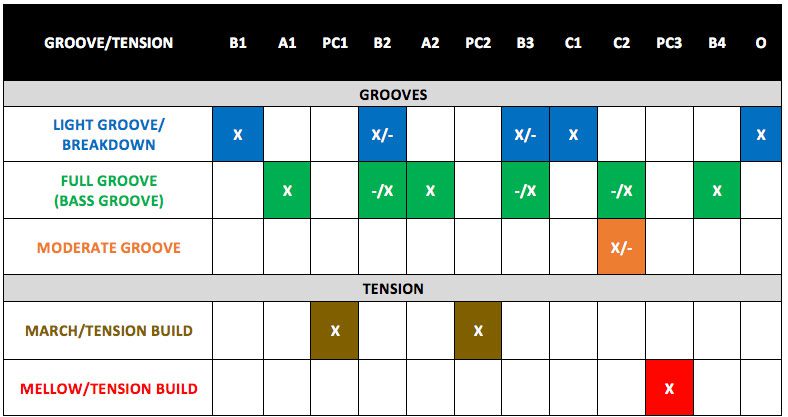


Side To Side begins with a relatively low MTI/Energy level in the first chorus. It features a sparse arrangement, consisting solely of the laid-back/grooving traditional Reggae-influenced electric guitar and vocals from Grande and Minaj.
The MTI/Energy level is kicked up a couple of notches the first verse due to the addition of electric bass, sub-bass, drum and percussion elements into the mix. Together, they and their associated patterns provide the section with a higher degree of momentum and intensity compared to the preceding chorus.
Despite the thinned out arrangement compared to the preceding verse (i.e. fewer elements are featured in the mix), the MTI/Energy level of the pre-chorus is a notch above that of the preceding verse. This is due in part to the march-styled drums, dark round bass, militant male background vocals, and the shift in Grande’s lead vocal compared to the preceding verse, all of which provide a heightened degree of tension, momentum and underlying intensity. The level reaches an apex at the end of the section particularly due to Grande’s high-pitch “I-I-I…” melisma and the speeding up of the snare and claps as the song heads into the ensuing chorus.
Following the MTI/Energy level peak at the end of the pre-chorus, the level drops off significantly in the first half of the chorus (part X) due to its sparse/breakdown characteristic. Essentially, it is a reversion back to the laid-back traditional Reggae groove characteristics of chorus 1 plus snaps and a low-level synth that doubles the guitar. The level is thrust back up again in the second half of the section (part Y) due to the fuller accompaniment – in particular the addition of drums/percussion and overdriven bass.
Following part Y of the chorus, the MTI/Energy level drops off a notch in part X of the second verse as the song reverts back to the core accompaniment characteristics that define the first verse. However, the level increases slightly in the second half of the section (part Y) due to the addition of the background vocals. They provide part Y with a subtly more intense vibe compared to part X.
The MTI/Energy level in the second pre-chorus is a tad above that of the preceding verse, as it essentially possesses the same characteristics as pre-chorus 1. However, the addition of the low-level sax, which plays a succession of staccato dotted eighth notes, provides a subtle increase in momentum and intensity compared to pre-chorus 1.
Following the MTI/Energy level peak at the end of the pre-chorus, the level drops off once again as the song heads back into breakdown/sparse mode in the first half (part X) of the third chorus. The level is then thrust back up in the second half (part Y) once the full accompaniment kicks back in. Note that the overall level is a notch higher than the second chorus primarily due to the additional “been there all night/day baby” background vocals featured in the mix.
Following the MTI/Energy level peak in chorus 3 (which is the highest energy level in the song thus far), the level drops off significantly in bridge 1 as the song heads back into breakdown/sparse mode, consisting of Minaj’s sung vocal, traditional Reggae electric guitar, synths and snaps.
The MTI/Energy level is thrust back up in the first half of bridge 2 (part X) primarily due to the addition of the driving drums, synth siren, and Minaj’s rapped delivery, all of which provide the section with a heightened degree of momentum and intensity compared to the preceding section.
The level is further kicked up in the second half of the section (part Y) due to the addition of the bass, kick drum and claps. All three elements provide the section with a heightened degree of driving power. However, note that part Y also possesses a couple of brief lulls due to the stop/start flow of the accompaniment. Reference the Music Section-By-Section analysis below for details.
Following the intense, driving bridge 2 section, the MTI/Energy level is brought down to its lowest point in the song in pre-chorus 3 due to its differentiated, serene breakdown characteristic relative to the other pre-chorus sections, consisting primarily of a synth pad, synth bass, and Grande’s vocals.
Toward the end of the section, the synth pad and newly introduced synth blip crescendo in conjunction with Grande’s ascending “I” vocal melisma, which provides a higher degree of tension, anticipation and intensity as the song heads into the final chorus.
Note that the very low MTI/Energy level in pre-chorus 3 is very much warranted considering that it is both preceded and followed by the longest periods of sustained intensity in the scope of the song (i.e. all of bridge 2 and all of chorus 4 – there is no breakdown chorus part X this time around). It provides the listener with a dynamic breather, and functions to set up the high-intensity chorus that follows for maximum impact due to its dynamically contrasting characteristic.
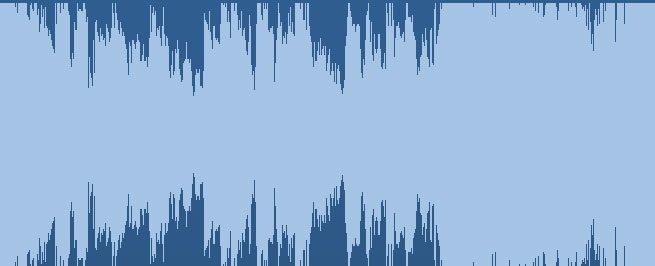

As mentioned above, chorus 4 differs from all of the other chorus sections in the song due to the fact that it doesn’t begin in breakdown/sparse mode. Instead, it begins with the full accompaniment that defines the other chorus part Y sections, thus providing stringent cross-section dynamic contrast relative to the low-energy breakdown pre-chorus 3 section that precedes it.
Additionally, the inclusion of the synth blip from the preceding pre-chorus, the synth siren from bridge 2, and the additional vocals take the intensity and excitement factor of the song to its apex.
Following the MTI/Energy grand peak in chorus 4, the level drops off once again in the outro as the song heads back into breakdown/sparse mode, consisting of the core accompaniment from the intro, the bridge 1 lead vocal (Minaj) and the chorus background vocal (Grande).
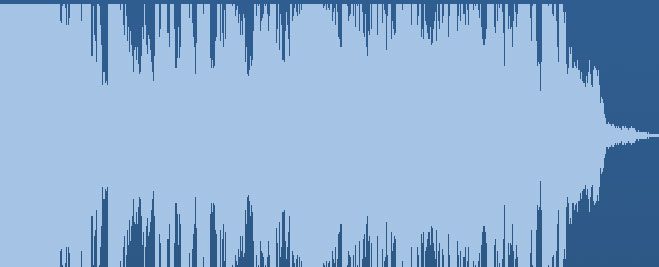

Many of today’s hits feature a fusion of different genres, sub-genres and influences that helps to achieve the following:
- Provide the song with a unique nature that enables it to stand out from its mainstream contemporaries via interesting and at times unconventional pairings.
- Increase the fan base and sales potential of the artist and song by traversing multiple genres.
Side To Side is a Pop song that features five main influences – Electropop, Hip Hop/Rap, R&B/Soul, Trap and World (Reggae). These influences are present in the characteristics of the vocals, backing music, or both, in varying levels of prominence throughout the song.
Key
Small x: Minimal influence
Medium X: Pronounced influence
Big X: Major influence
-: No influence
/: Divides the first half of the section from the second
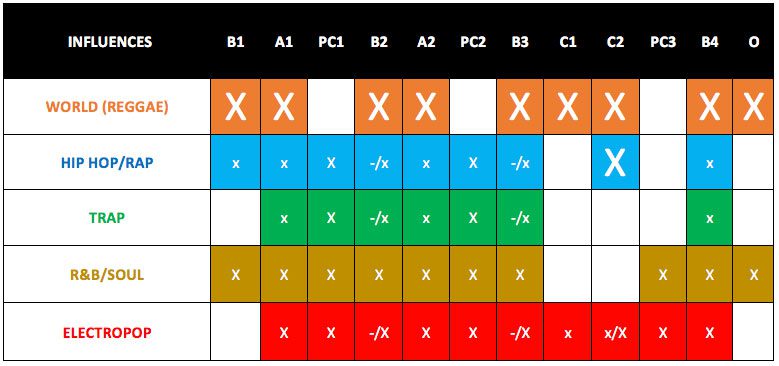


Reggae is the primary influence that is in effect throughout the majority of the song, with the only exceptions being the pre-choruses. It is put into effect first and foremost by the electric guitar and electric bass, both of which possess traditional Reggae characteristics. While Grande’s vocals are rooted primarily in Pop and R&B, Minaj’s lead vocal in bridge 1 and the outro possesses a Reggae vibe due to her Trinidadian heritage, which comes across in her sung delivery.
Hip Hop/Rap plays a moderate to major role in the scope of the song due to characteristics of the accompaniment and vocals in the following sections:
- Chorus 1: Moderate role due to the artist plug vocals, which are indicative of the Hip Hop/Rap genre.
- Verse 1 & 2: Moderate role due to the characteristics of the beat and 808-sounding drums/perc.
- Pre-Chorus 1 & 2: Moderate/major role due to the increased prominence of the drums/perc.
- Chorus 2, 3 & 4: Plays a moderate role in the second part/stanza of choruses 2 and 3 due to the characteristics of the drums/perc and beat. The influence is in effect throughout the entirety of the fourth chorus.
- Bridge 2: The second bridge features the most pronounced Hip Hop/Rap influence in the scope of the song. This is due primarily to Minaj’s rapped lead vocals, as well as the electronic claps that enter midway in the section.
Additionally, all of the Hip Hop/Rap-influenced sections save for chorus 1 feature a Trap influence due to the characteristics of the drums/beat (rapid-fire hats, 808) and electronic claps.
Every section of the song except for bridges 1 and 2 (which exclusively feature Nicki Minaj’s Trinidadian-influenced sung vocals and rapped delivery, respectively) possess a moderate R&B influence. This is primarily due to the soulful and melismatic characteristics of Ariana Grande’s lead vocal.
The majority of sections in Side To Side feature some degree of an Electropop influence. This is put into effect by the various synths featured in the mix (reference the Music and instruments Section of the report for details).
Side To Side features five primary instrument types in the mix that shape its sound and vibe – bass, drums/percussion, guitar, synths and wind (saxophone).
Reggae-influenced electric guitar is one of the defining instruments of Side To Side. The layered sound is comprised of wah-wah-effected strums panned l/r in the mix, while chord stabs are featured primarily straight up the middle. The entire sound is processed with ample reverb throughout and is low-pass filtered in the verses. Electric guitar appears in every section of the song save for the pre-choruses.
A retro-sounding electric bass playing a Reggae-influenced part is used in the following sections:
- Verse 1 & 2
- Chorus 2 & 3 (Part Y)
- Chorus 4 (Full Section)
- Bridge 2 (Part Y)
The retro element is put into effect by the warm, mid-heavy tone, and the Reggae influence is apparent in the use of repeated notes and syncopation.
An overdriven synth bass doubles the electric bass to provide extra bite and grit, and enable the bass line to further cut through the mix in the following sections:
- Chorus 2 & 3 (Part Y)
- Chorus 4 (Full Section)
- Bridge 2 (Part Y)
A deep synth bass is used in the pre-choruses. It is low-pass filtered, creating a rounded dark tone with the filter gradually opening up in the second half of the section exposing a brighter, slightly overdriven tone.
A low saxophone is used at the transition point of the following sections, playing E2-F#2:
- Chorus 2 to Verse 2
- Verse 2 between parts X & Y
- Verse 2 to Pre-Chorus 2
- Pre-Chorus 2 to Chorus 3
- Chorus 3 between part X & Y
- Pre-Chorus 3 to Chorus 4
In the second pre-chorus the saxophone is in effect throughout the entire section. It is low-pass filtered, playing a syncopated monotone pattern on F#2. The filter opens as the section progresses.
A plethora of synths appear throughout Side To Side:
A rounded, soft synth pad is utilized in the pre-choruses. It is featured subtly in the mix during the second half of pre-choruses 1 and 2, and more prominently throughout the entirety of pre-chorus 3.
Digital sounding staccato synth stabs double the electric guitar to provide additional color and texture in the following sections:
- Chorus 2, 3 & 4
- Bridge 1
- Outro
An airy synth lead possessing a woodwind-esque timbre modulated to dip on the downbeats and swell on the upbeats (sidechain compression style) delivers a subtle instrumental hook in the following sections:
- Chorus 2 (Part Y)
- Chorus 3 (Full Section)
- Bridge 1
A police/fire-siren sounding synth appears in the entirety of bridge 2 and chorus 4. It pans back and forth left to right roughly every 4 beats.
The blip sounding lead synth enters toward the end of the third pre-chorus where it is low-pass filtered, opening up toward the end of the section. It is featured un-filtered and more prominent in the mix in chorus 4. It primarily plays a staccato pattern with long notes featured at the end of each run in chorus 4.
Utilized only in part Y of bridge 2, this pulsing synth noise pulse has the effect of a shaker playing an upbeat sixteenth note part.
A punchy, slightly overdriven kick playing a Hip-Hop style pattern is utilized in the following sections:
- Verse 1 & 2
- Chorus 2 & 3 (Part Y)
- Chorus 4 (Full Section)
It plays a straight eighth note pattern in part Y of bridge 2.
A slightly thinner, non-overdriven kick is used in:
- Pre-Chorus 1 & 2
A delay-effected, Reggae-influenced kick is used in the first half (part X) of chorus 3, playing only on beats 2 and 4 of each measure.
A deep 808 sub bass kick tuned to match the chord progression is used in conjunction with the main kicks in the following sections:
- Verse 1 & 2
- Pre-Chorus 1 & 2
- Chorus 2 & 3 (Part Y)
- Chorus 4 (Full Section)
- Bridge 1 (single hit)
- Pre-Chorus 3 (single hit)
A layered, punchy electronic snare is used for backbeats, and a thin 808 snare is used to punctuate transitions between sections and stanzas in the following sections:
- Verse 1 & 2
- Chorus 2 & 3 (Part Y)
- Chorus 4 (Full Section)
- Bridge 1 & 2
A slightly thinner snare is used for the march-like patterns in pre-choruses 1 & 2.
Electric hi-hats playing a Trap-inspired sixteenth/thirty-second/sixty-fourth note pattern are utilized in the following sections:
- Verse 1 & 2
- Chorus 2, 3 & 4
A more straightforward sixteenth note pattern is utilized in bridges 1 and 2.
A woodblock sounds on beats 2 and 4 in the following sections:
- Verse 1 & 2
- Chorus 2 & 3 (Part Y)
- Chorus 4 (Full Section)
It is accompanied by a snare drum in every appearance.
Cross-stick is utilized in chorus 3 part X, where it plays on beats 2 and 4 of every measure. While it is very subtle in the mix, it helps to accentuate the traditional Reggae vibe along with the kick and snaps.
An electronic, 808-style clap playing steady 8ths is utilized in the following sections:
Pre-chorus 1 & 2
- Bridge 2 (Part Y)
- Chorus 4 (Full Section)
Toward the end of the pre-chorus sections, sixteenth, thirty-second, and sixty-fourth notes are utilized, providing a heightened degree of momentum and excitement leading into the ensuing chorus.
Acoustic snaps are utilized on beats 2 and 4 of each measure in the following sections:
- Chorus 2, 3 & 4
- Bridge 1 & 2
Each snap on beat 2 is a bit higher in pitch than the snap on beat 4, resulting in a clock-like “tick, tock” effect.
An electronic ride cymbal is used to mark the beginning of each section or stanza, sounding on beat 1 every four bars beginning in the first verse.
A cymbal swell is implemented at the end of bridge 2, helping to smooth out the transition into pre-chorus 3.
A distinctly Reggae-influenced drum fill (snare drum/timbales), effected with classic “Dub” Reggae delay is utilized at the transitions into the following stanzas/sections:
- Chorus 2 & (Part X)
- Chorus 4 (Part X and Y)
- Bridge 1
- Bridge 2 (Part Y)
A mid-range, 808-sounding electronic tom is used in:
- Pre-chorus 1 & 2
- Verse 2
- Bridge 2 (Part Y)
In the pre-choruses it is layered in with the snare for the last bar, adding weight to the transition build. In verse 2 and part Y of bridge 2 it plays sixteenth notes on “2-e-&-a” and “4-e-&-a” (detailed in the notation below).
A host of cross-stanza and cross-section transitional effects are utilized throughout the song. Reference the Section By Section analysis below for details.
The table below provides an at-a-glance view of the sections that feature primarily traditional Reggae, primarily contemporary, or a combination of traditional Reggae and contemporary instrumental influences in the mix.
- Primarily Traditional: Traditional Reggae guitar and/or bass is the primary influence in the section.
- Primarily Contemporary: Contemporary instruments/patterns are the primary influence in the section, and there is little or no trace of traditional Reggae (e.g. Trap elements such as sub bass and rapid-fire hi hats, contemporary Electropop synths, etc.)
- Traditional/Contemporary: The section contains a combination traditional Reggae and contemporary instrumental influences.
Key
X: Accompaniment type is in effect
/: Divides the first half of the section from the second
-: Accompaniment type is not in effect
- Electric Guitar: (Wah-effected, Reggae style – Level: Mid) Primary placement in the mix: 12:00.
- Transitional FX 1: (End of section – Level: Low) Primary placement in the mix: 12:00.
- Transitional FX 5: (End of section – Level: Low) Primary placement in the mix: 12:00.
The first chorus, which is abbreviated compared to the others in the song (i.e. one part/stanza vs. two), features a very sparse arrangement. The sole instrument in the mix is wah-wah effected electric guitar, which along with its associated pattern immediately puts the song’s grooving traditional Reggae vibe into full effect. It enters on the first beat of the the song, following Grande’s “I been there all” solo vocal pickup.
Additionally, note that the sparseness of the arrangement enables Minaj’s plugs and Grande’s chorus vocals to shine front and center in the mix, thus connecting with the listener on a more pronounced level.
Transition Point (Chorus 1 into Verse 1): At the end of the chorus, the guitar is pulled from the mix while a “dive bombing” synth effect in conjunction with Grande’s “I’m talkin’ to ya” vocal pickup transitions the listener into the verse that follows. The incorporation of this Electropop synth effect provides an effective modernistic counter to the more traditional Reggae-influenced electric guitar, thus signaling the blended influences that embody the song as a whole.
- *Electric Guitar: (Wah-effected, Reggae style, low-pass filtered – Level: Low) Primary placement in the mix: 12:00.
- **Bass: (Electric Bass – Level: Mid) Primary placement in the mix: 11:00.
- **Kick: (Punchy, overdriven electronic kick – Level: Mid) Primary placement in the mix: 12:00.
- **808 Bass: (Deep sub bass in conjunction with Kick – Level: Low) Primary placement in the mix: 12:00.
- **Snare: (Thick backbeat snare, 808 snare fills – Level: Mid) Primary placement in the mix: 12:00.
- **Hi Hat: (Mainly 16th notes with 32nd and 64th note flourishes – Level: Mid) Primary placement in the mix: 11:00.
- **Woodblock: (Hits on beats 2 & 4 of each bar – Level: Mid) Primary placement in the mix: 12:00.
- **Ride Cymbal: (Single hit at onset of each stanza – Level: Mid) Primary placement in the mix: 12:00.
Everything in Part X with the following addition:
- **Transitional FX 2: (End of section – Level: Low) Primary placement in the mix: 12:00.
*Indicates a new or significantly changed up instrument in the mix compared to the preceding section
**Indicates the first appearance of an instrument in the mix
In contrast to the preceding chorus, the first verse features a much fuller accompaniment, consisting of guitar, bass, drums and percussion. Together, these elements kick the momentum and intensity of the song in into a higher gear, and provide an engaging blend of traditional Reggae and contemporary influences.
Electric Guitar (carryover from preceding chorus)
The electric guitar and associated pattern from the chorus remains in effect, albeit processed with a low-pass filter effect that relegates it more toward the back of the mix. Note that the low-pass filter effect provides the guitar with a contemporary quality that counters its otherwise traditional Reggae characteristics.
Bass
There are two bass instruments featured in the first verse – electric bass and synth bass. The electric bass and its associated pattern provide the section with a traditional Reggae vibe along with the electric guitar (reference the sheet music below for details). The addition of the deep 808 sub bass provides the section with additional bottom end as well as a contemporary counter to the aforementioned more traditional Reggae elements.
Drums/Percussion
Five drum/percussion elements are featured in the first verse – kick, snare, hi hats, ride and woodblock. All possess a distinct electronic timbre except for the woodblock, which is more acoustic sounding and plays in tandem with the snare on beats 2 and 4. Along with the sub bass, the kick, snare and hi hats provide the section with an underlying Hip Hop and Trap influence.
Transition Point (Verse 1 into Pre-Chorus 1): At the end of the verse a dive bombing synth effect that finishes with a granulated, distorted characteristic sounds in conjunction with a snare fill to usher in the pre-chorus that follows.
- **Bass: (Round synth bass – Level: Mid) Primary placement in the mix: 11:00.
- **Synth Pad: (Gradually crescendos during second half – Level: Low) Primary placement in the mix: 12:00.
- *Kick: (Punchy, thinner and sparser than verse, builds up speed to transition point – Level: Mid) Primary placement in the mix: 12:00.
- *808 Bass: (Deep sub bass hits at onset of each bar – Level: Low) Primary placement in the mix: 12:00.
- *Snare: (March style snare, thinner than verse, builds up speed to transition point – Level: Mid) Primary placement in the mix: 12:00.
- **Claps: (Steady eighth note claps, build up speed to transition point – Level: Mid) Primary placement in the mix: 12:00.
- Ride Cymbal: (Single hit at onset of section – Level: Mid) Primary placement in the mix: 12:00.
- **Drum Fill: (Reggae style acoustic drum fill, delay-effected – Level: Low) Primary placement in the mix: 12:00.
- **808 Tom: (Layered in with snare for the second half – Level: Low) Primary placement in the mix: 12:00.
- **Transitional FX 3: (End of section – Level: Low) Primary placement in the mix: 12:00.
*Indicates a new or significantly changed up instrument in the mix compared to the preceding section
**Indicates the first appearance of an instrument in the mix
The accompaniment in the pre-chorus is dramatically different than that of the preceding verse and chorus sections:
- It’s thinned out compared to the preceding verse (i.e. it contains fewer elements in the mix)
- It features instruments that make their first appearance thus far in the song, as well as notable omissions from the preceding sections.
- It completely drops all traces of the traditional Reggae influences that define the preceding sections in favor of purely contemporary influences and a march-styled vibe.
While the vast majority of instruments in the pre-chorus is new or significantly changed up from the preceding verse, it’s the omission of the electric guitar and electric bass that provide the most notable vibe shift. Their omission does away with the entire traditional Reggae foundation that was first established at the beginning of the song.
In place of the traditional Reggae electric guitar and bass, contemporary elements including synths and electronic drums/percussion dominate the mix:
Bass & Synth Pad
The round synth bass is processed with a low-pass filter at the onset, which gradually opens as the section progresses. It provides the section with an underlying dark, tense vibe, shifting from a warm to gritty timber as the filter opens. A synth pad that doubles the bass in the second half of the section provides increased color and texture as it crescendos.
Drums/Percussion
Besides the omission of the Reggae-influenced electric guitar and bass, the elements that provide the most pronounced vibe shift are the electronic snare and claps. The interaction between the steady eighth note claps and thin snare hits / rolls provide the section with an engaging syncopated march-type vibe, which heightens the tension along with the aforementioned round synth bass and shift in Grande’s vocal delivery (reference the Vocal Melody Section of the report for details). A steady eighth note kick doubles the claps in the second half of the section, providing subtly increased power (its punchy and thin as opposed to powerful and deep).
Transition Point (Pre-Chorus 1 into Chorus 2): In the last measure of the pre-chorus, the opening of the round bass synth filter, speeding up claps and snare, and Grande’s “I-I-I…” melisma bring the tension, anticipation and intensity to a climax as the song heads into the ensuing chorus.
- *Electric Guitar: (Wah-effected, Reggae style – Level: Mid) Primary placement in the mix: 12:00.
- **Synth Stabs: (Staccato, digital sounding – Level: Low) Primary placement in the mix: 12:00.
- *808 Bass: (Deep sub bass hit at onset of section – Level: Low) Primary placement in the mix: 12:00.
- *Snaps: (Acoustic snaps on beats 2 & 4 – Level: Low) Primary placement in the mix: 12:00.
- Ride Cymbal: (Single hit every 4 bars – Level: Mid) Primary placement in the mix: 12:00.
- **Transitional FX 4: (Onset of section – Level: Low) Primary placement in the mix: 12:00.
- Transitional FX 5: (End of part X – Level: Low) Primary placement in the mix: 12:00.
Part Y (1:01 – 1:13)
Everything in Part X with the following additions:
- **Bass: (Electric Bass + Overdriven Synth Bass – Level: Mid) Primary placement in the mix: 11:00.
- **Synth Wind (Legato synth melody – Level: Mid) Primary placement in the mix: 12:00.
- *Kick: (Punchy, overdriven electronic kick – Level: Mid) Primary placement in the mix: 12:00.
- *808 Bass: (Deep sub bass in conjunction with Kick – Level: Low) Primary placement in the mix: 12:00.
- *Snare: (Thick backbeat snare, 808 snare fills – Level: Mid) Primary placement in the mix: 12:00.
- *Hi Hat: (Mainly 16th notes with 32nd and 64th note flourishes – Level: Mid) Primary placement in the mix: 11:00.
- *Woodblock: (Hits on beats 2 & 4 of each bar of each bar – Level: Mid) Primary placement in the mix: 12:00.
- **Transitional FX 2: (End of section – Level: Low) Primary placement in the mix: 12:00.
*Indicates a new or significantly changed up instrument in the mix compared to the preceding section
**Indicates the first appearance of an instrument in the mix
In contrast to the first chorus, the second chorus consists of two 4-bar parts/stanzas, both of which contain similar and contrasting characteristics relative to one another.
Following the aforementioned build at the end of the pre-chorus, the chorus brings the energy back down in the first half of the section by shifting further into breakdown/sparse mode. It features the electric guitar from the first chorus, plus two additional instruments – snaps and synth stabs. Note the following:
- The electric guitar reestablishes the traditional Reggae influence and groove, which was absent in the preceding section.
- The synth stabs, which double the guitar, provide additional subtle color and texture.
- The snaps, which sound on beats 2 and 4, provide a cool, laid-back rhythmic vibe in addition to color and texture.
The addition of the synth stabs and snaps provide engaging “like section” contrast, preventing part X from being a cookie-cutter version of the first chorus, and thus heightening the engagement value of the song in the process.
Synth doubling and snaps aside, part X of the second chorus does away with the purely contemporary influences of the preceding section in favor of the traditional Reggae flavor. This is the opposite of what transpired in the preceding section (i.e. the song shifted from traditional Reggae to purely contemporary).
Transition Point: Part X into Part Y: At the end of part X, a “dive bombing” synth effect signals the transition point into the second half of the section, part Y.
In contrast to the sparse characteristics of part X, part Y features a much fuller arrangement. With the electric guitar, synth stabs and snaps remaining in effect providing cross-part continuity, the following new elements are added:
Bass
The bass featured in part Y of the second chorus is less syncopated but more intense and driving than the bass featured in the first verse. This is due in part to the shift in the bass pattern (primarily based on a succession of sixteenth notes), and the overdriven timbre of the synth bass that is paired with the electric bass.
Drums/Percussion
The drums and percussion featured in the chorus are very similar to that of the first verse.
Synths
Making their first appearance in the song, synths featuring a woodwind-type timbre play a swelling legato melody throughout the course of part Y. They provide the full section with a heightened degree of color and contrast without overshadowing the core accompaniment characteristics. Additionally, its repetitive characteristics along with strategic placement in the section helps it to function in the manner of a subtle instrumental hook:
The interaction between Grande’s vocals and the aforementioned synth hook provide part Y of the chorus with an infectious, albeit subtle, call and response characteristic:
Line 4: I been there all night
(synth hook)
Line 5: I been there all day
(synth hook)
Line 6: And boy got me walkin’ side to side (side to side)
Transition Point (Chorus 2 into Verse 2): At the end of the chorus a two-note sax part coupled with a short airy synth effect that is followed by a delay-laden synth blip (a la scoring some points in an old-school video game) signals the transition point into the second verse.
- *Electric Guitar: (Wah-effected, Reggae style, low-pass filtered – Level: Low) Primary placement in the mix: 12:00.
- *Bass: (Electric Bass – Level: Mid) Primary placement in the mix: 11:00.
- **Saxophone: (Two note transition at beginning of section, end of part X and end of part Y – Level: Mid) Primary placement in the mix: 12:00.
- Kick: (Punchy, overdriven electronic kick – Level: Mid) Primary placement in the mix: 12:00.
- 808 Bass: (Deep sub bass in conjunction with Kick – Level: Low) Primary placement in the mix: 12:00.
- Snare: (Thick backbeat snare, 808 snare fills – Level: Mid) Primary placement in the mix: 12:00.
- Hi Hat: (Mainly 16th notes with 32nd and 64th note flourishes – Level: Mid) Primary placement in the mix: 11:00.
- Woodblock: (Hits on beats 2 & 4 of each bar – Level: Mid) Primary placement in the mix: 12:00.
- Ride Cymbal: (Single hit at onset of each section – Level: Mid) Primary placement in the mix: 12:00.
- Transitional FX 4: (Onset of section – Level: Low) Primary placement in the mix: 12:00.
Everything in Part X with the following additions:
- **808 Tom: (Plays on “2-e-&-a” and “4-e-&-a” – Level: Mid) Primary placement in the mix: 12:00.
- Transitional FX 2: (End of section – Level: Low) Primary placement in the mix: 12:00.
*Indicates a new or significantly changed up instrument in the mix compared to the preceding section
**Indicates the first appearance of an instrument in the mix
The second verse features the same accompaniment characteristics as the first verse with one addition – a two-note sax part that signals the transition point into the second half of the section, part Y. Note that this is the same sax utilized to transition from the preceding chorus into part X. Additionally, just prior to the sax entrance, the hi hat and bass are pulled on beat four and is reinstated on the following beat one. This provides a slightly jarring shift in the scope of the section, and emphasizes the pickup lyrics to part Y, “and boy I got ya.”
Transition Point (Verse 2 into Pre-Chorus 2): The two-note sax part at the end of the verse signals the transition point into pre-chorus 2.
- *Bass: (Round synth bass – Level: Mid) Primary placement in the mix: 11:00.
- *Saxophone: (Two note transition at beginning of section, then plays a low-pass filtered syncopated pattern – Level: Mid-low) Primary placement in the mix: 12:00.
- *Synth Pad: (Gradually crescendos during second half – Level: Low) Primary placement in the mix: 12:00.
- *Kick: (Punchy, thinner and sparser than verse, builds up speed to transition point – Level: Mid) Primary placement in the mix: 12:00.
- *808 Bass: (Deep sub bass hits at onset of each bar – Level: Low) Primary placement in the mix: 12:00.
- *Snare: (March style snare, thinner than verse, builds up speed to transition point – Level: Mid) Primary placement in the mix: 12:00.
- *Claps: (Steady eighth note claps, build up speed to transition point – Level: Mid) Primary placement in the mix: 12:00.
- Ride Cymbal: (Single hit at onset of section – Level: Mid) Primary placement in the mix: 12:00.
- *Drum Fill: (Reggae style acoustic drum fill, delay-effected – Level: Low) Primary placement in the mix: 12:00.
- *808 Tom: (Layered in with snare for the second half – Level: Low) Primary placement in the mix: 12:00.
- *Transitional FX 3: (End of section – Level: Low) Primary placement in the mix: 12:00.
*Indicates a new or significantly changed up instrument in the mix compared to the preceding section
Similar to the aforementioned verse sections, pre-chorus 2 features the same core accompaniment characteristics as pre-chorus 1 with one exception – a low-pass filtered sax playing a syncopated pattern is featured throughout the section. It provides additional subtle color, texture, and momentum as well as “like section” contrast.
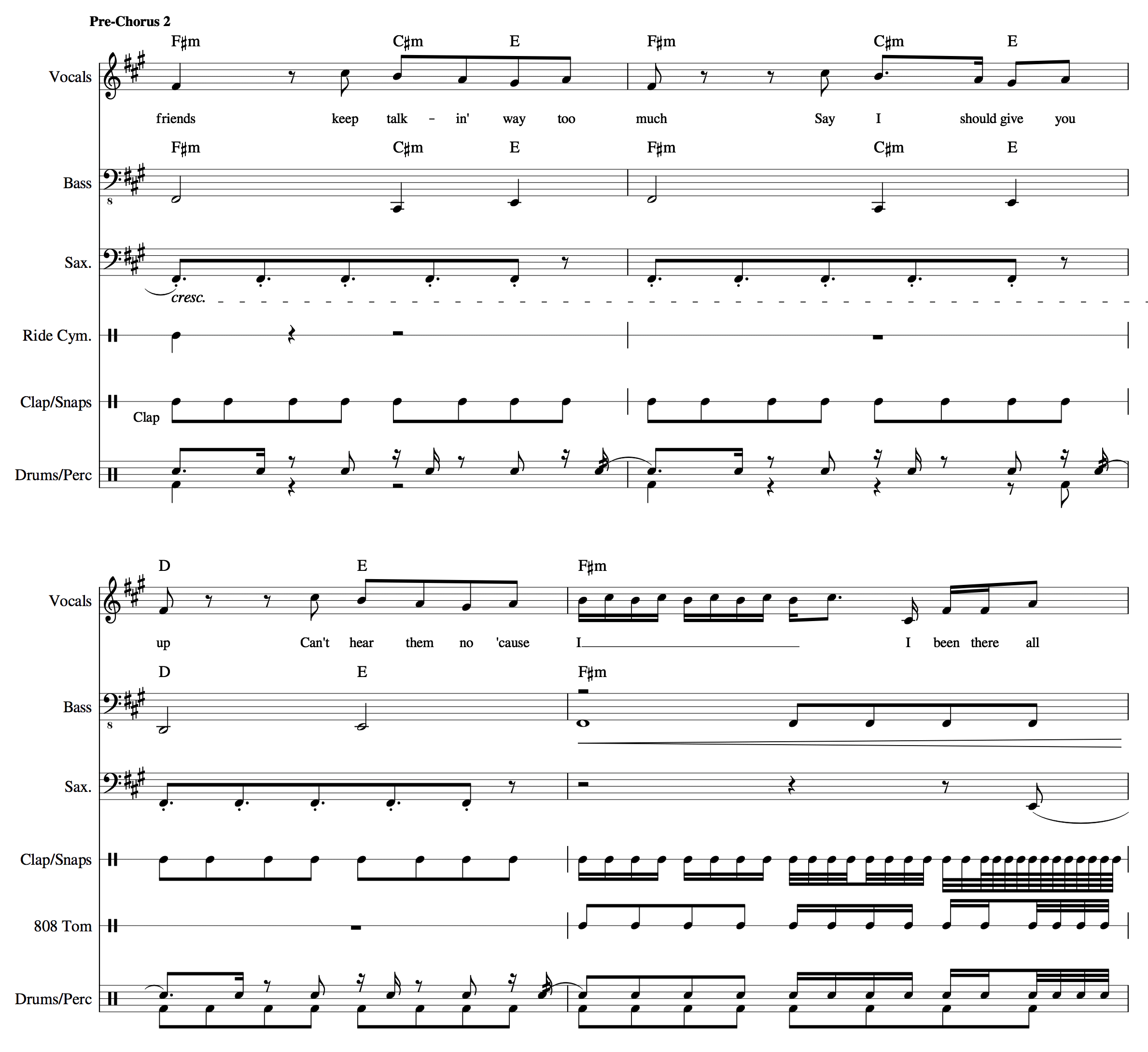

Transition Point (Pre-Chorus 2 into Chorus 3): Same as the transition from pre-chorus 1 into chorus 2 except for the addition of the electronic/acoustic hybrid sounding, delay effected, Reggae-influenced snare/timbale fill. Although its layered in with all of the other elements in the mix, it does provide a hint of traditional Reggae as the song moves from the purely contemporary accompaniment in the pre-chorus back into traditional Reggae-influenced chorus.
- *Electric Guitar: (Wah-effected, Reggae style – Level: Mid) Primary placement in the mix: 12:00.
- Saxophone: (Two note transition at onset of section end of part X – Level: Mid) Primary placement in the mix: 12:00.
- *Synth Stabs: (Staccato, digital sounding – Level: Low) Primary placement in the mix: 12:00.
- *Synth: Wind (Legato synth melody – Level: Mid) Primary placement in the mix: 12:00.
- *Kick: (Delay-effected, Reggae-influenced kick – Level: Mid-low) Primary placement in the mix: 12:00.
- *808 Bass: (Deep sub bass hit at onset of section – Level: Low) Primary placement in the mix: 12:00.
- *Snaps: (Acoustic snaps on beats 2 & 4 – Level: Low) Primary placement in the mix: 12:00.
- **Cross-stick: (Hits on beats 2 & 4 of each bar of part X – Level: Mid) Primary placement in the mix: 12:00.
- Ride Cymbal: (Single at onset of each stanza – Level: Mid) Primary placement in the mix: 12:00.
- Transitional FX 4: (Onset of section – Level: Low) Primary placement in the mix: 12:00.
- Transitional FX 5: (End of part X – Level: Low) Primary placement in the mix: 12:00.
Everything in Part X (minus cross-stick) with the following additions:
- *Bass: (Electric Bass + Overdriven Synth Bass – Level: Mid) Primary placement in the mix: 11:00.
- *Kick: (Punchy, overdriven electronic kick – Level: Mid) Primary placement in the mix: 12:00.
- *808 Bass: (Deep sub bass in conjunction with kick – Level: Low) Primary placement in the mix: 12:00.
- *Snare: (Thick backbeat snare, 808 snare fills – Level: Mid) Primary placement in the mix: 12:00.
- *Hi Hat: (Mainly 16th notes with 32nd and 64th note flourishes – Level: Mid) Primary placement in the mix: 11:00.
- *Woodblock: (Hits on beats 2 & 4 of each bar – Level: Mid) Primary placement in the mix: 12:00.
- *Drum Fill: (Reggae style acoustic drum fill, delay-effected – Level: Mid) Primary placement in the mix: 12:00.
- *Transitional FX 2: (End of section – Level: Low) Primary placement in the mix: 12:00.
*Indicates a new or significantly changed up instrument/vocal in the mix compared to the preceding section
Chorus 3 features the same core accompaniment characteristics as chorus 2 plus the following changeups:
- The woodwind synth hook is put into effect right from the get-go, and is featured throughout the entirety of part X. In chorus 2 it was only in effect in part Y.
- Conversely, the woodwind synth hook is omitted from the first half of part Y, and reinstituted during the last two bars of the stanza doubling the “ah” background vocals.
- The kick drum sounds on beats 2 and 4 within part X in addition to playing a fuller part Y. In chorus 2 it was only in effect in part Y. As a result, it provides the section with subtle additional power right from the get-go.
Transition Point (Chorus 3 Bridge 1): Essentially the same Reggae-influenced, delay effected snare/timbale fill that is featured at the transition point into chorus 3 is utilized to transition chorus 3 into bridge 1. Additionally, a short airy synth effect that is followed by a delay-laden synth blip (a la scoring some points in an old-school video game) is utilized as well. This is the same transitional effect that was utilized heading into the second verse.
- Electric Guitar: (Wah-effected, Reggae style – Level: Mid) Primary placement in the mix: 12:00.
- Synth Stabs: (Staccato, digital sounding – Level: Low) Primary placement in the mix: 12:00.
- Synth: Wind (Legato synth melody – Level: Mid) Primary placement in the mix: 12:00.
- *808 Bass: (Deep sub bass hit at onset of section – Level: Low) Primary placement in the mix: 12:00.
- Snaps: (Acoustic snaps on beats 2 & 4 – Level: Low) Primary placement in the mix: 12:00.
- Ride Cymbal: (Single hit at onset of section – Level: Mid) Primary placement in the mix: 12:00.
- Transitional FX 4: (Onset of section – Level: Low) Primary placement in the mix: 12:00.
- Transitional FX 5: (End of section – Level: Low) Primary placement in the mix: 12:00.
*Indicates a new or significantly changed up instrument in the mix compared to the preceding section
While bridge 1 provides a major vocal departure in the scope of the song due to the shift in vocal duties over to Nicki Minaj, the accompaniment is almost identical to chorus 3 part X, save for the omission of the kick drum. As a result, it puts the song back into breakdown/sparse mode following the full accompaniment in chorus 3 part Y. The breakdown here is important for two key reasons:
- It enables Nicki Minaj’s first appearance in the song to come across in a more pronounced, unadulterated manner.
- It essentially “resets” the song as it enters into the back-to-back departure sections. As a result, it provides increased separation from the preceding sections, enabling this part of the song to further stand out and connect.
Additionally, the woodwind synth hook from choruses 2 and 3 remains in effect throughout the section. This provides cross-section familiarity as well it as reinforces the hook in the listener’s head.
Transition Point (Bridge 1 to Bridge 2): The full accompaniment is pulled briefly at the tail end of bridge 1 save for a dive-bombing transitional synth effect, Minaj’s “whoop-whoop-whoop” vocal, and synth blip splash and cymbal hit at the transition point.
- *Electric Guitar: (Wah-effected, Reggae style – Level: Mid) Primary placement in the mix: 12:00.
- **Synth Siren: (Siren sounding synth – Level: Low) Primary placement in the mix: Pans back and forth from 9:00 – 3:00 roughly every bar.
- *Kick: (Punchy, electronic kick, straight 8th pattern – Level: Mid) Primary placement in the mix: 12:00.
- 808 Bass: (Deep sub bass hit at onset of section – Level: Low) Primary placement in the mix: 12:00.
- *Snare: (Thick backbeat snare, 808 snare fills – Level: Mid) Primary placement in the mix: 12:00.
- *Hi Hat: (Mainly 16th notes – Level: Mid) Primary placement in the mix: 11:00.
- Snaps: (Acoustic snaps on beats 2 & 4 – Level: Low) Primary placement in the mix: 12:00.
- Ride Cymbal: (Single hit at onset of each stanza – Level: Mid) Primary placement in the mix: 12:00.
- Transitional FX 4: (Onset of section – Level: Low) Primary placement in the mix: 12:00.
- Transitional FX 5: (Halfway through part X and end of part Y – Level: Low) Primary placement in the mix: 12:00.
- **Transitional Hit: (Onset of section – Level: Low) Primary placement in the mix: 12:00.
Everything in Part X with the following addition:
- *Bass: (Electric Bass + Overdriven Synth Bass – Level: Mid) Primary placement in the mix: 11:00.
- *Kick: (Punchy, overdriven electronic kick, four-on-the-floor – Level: Mid) Primary placement in the mix: 12:00.
- *Claps: (Steady eighth note claps – Level: Mid) Primary placement in the mix: 12:00.
- *808 Tom: (Plays on “2-e-&-a” and “4-e-&-a” – Level: Mid) Primary placement in the mix: 12:00.
- **Cymbal Swell: (End of section – Level: Mid) Primary placement in the mix: 12:00.
- **Synth Noise Pulse FX: (Sounds like a shaker playing upbeat 16th notes – Level: Mid) Primary placement in the mix: 12:00.
- Transitional FX 6: (Enters halfway through part Y – Level: Low) Primary placement in the mix: 12:00.
*Indicates a new or significantly changed up instrument in the mix compared to the preceding section
Bridge 2 consists of two 4-bar parts/stanzas, both of which possess similar and different characteristics relative to one another just as in other sections of the song.
The first half of the section, part X, features fuller accompaniment than bridge 1, with the primary difference being the addition of drums/percussion and synth into the mix. Note the following:
Drums/Percussion
The drum pattern featured in bridge 2 is different than all of the other sections in the song. It’s primarily non-syncopated, consisting of sixteenth note hi hats, a steady eighth note kick, and electronic snare and snaps that sound on beats 2 and 4. Together, they provide a steady-driving beat for Nicki Minaj’s rapped delivery to shine.
Synth
For the first time in the song, a siren sounding synth is featured and remains in effect throughout the entirety of part X. Although relatively low in the mix, it provides the section with unique color and texture and provides the section with a greater sense of underlying urgency and intensity as well.
Additionally, a “dive bombing” synth effect is featured at the mid-point in part X, providing a brief splash of color.
With the accompaniment from part X remaining in effect, the following additional elements are added in part Y:
Bass
The most pronounced addition to the section is the bass. Playing the bass line featured in the verse sections, its electric / overdriven synth hybrid quality enables it to stand out in the mix and provide the section with a heightened degree of power.
Drums/Percussion
808 toms and electronic claps are added into the mix in part Y, and the kick now possesses a more prominent overdriven characteristic. Together, the claps and kick in particular heighten the driving power of the section.
In contrast to the other sections in the song, the full accompaniment drops out for the duration of a quarter rest while Minaj raps the following lyrics:
- “chill in me” (preceded by an acoustic Reggae-influenced acoustic drum fill)
- “steph-an-ie”
Notice that the accompaniment pull enables these lyrics to stand out front and center in the mix, and reinforces the rhyme at a heightened level as a result.
Transition Point (Bridge 2 to Pre-Chorus 3): Toward the end of the bridge a swelling “jet aircraft engine” synth effect enters the mix, which increases the intensity right before being abruptly pulled along with the full accompaniment while Nicki Minaj raps “Ariana run pop.” A brief reverse synth swell effect then enters the mix, essentially sucking the listener into the third pre-chorus.
- *Bass: (Round synth bass – Level: Mid) Primary placement in the mix: 11:00.
- Synth Pad: (Gradually crescendos during entire section – Level: Mid) Primary placement in the mix: 12:00.
- **Synth blip Lead: (Low-pass filtered staccato, playful lead synth, enters at end of section – Level: Low) Primary placement in the mix: 12:00.
- *808 Bass: (Deep sub bass hits at onset of each bar – Level: Low) Primary placement in the mix: 12:00.
- Ride Cymbal: (Single hit at onset of section – Level: Mid) Primary placement in the mix: 12:00.
- *Drum Fill: (Reggae style acoustic drum fill, delay-effected – Level: Low) Primary placement in the mix: 12:00.
- **Transitional FX 6: (Enters during second half – Level: Low) Primary placement in the mix: 12:00.
*Indicates a new or significantly changed up instrument in the mix compared to the preceding section
The accompaniment that defines the third pre-chorus is significantly different than pre-choruses 1 and 2. The most notable changeup is the omission of the march-style drums (and drums, period). As a result, the synth pad and round bass provide the section with a serene characteristic that provides stringent accompaniment and energy level contrast against the higher energy level bridge that precedes it. The synth blip, which makes its first appearance in the song toward the end of the section, provides subtle additional color and texture to the otherwise sparse arrangement.
Toward the end of the section the synth pad and synth blip crescendo, providing a higher degree of tension, anticipation and intensity in conjunction with Grande’s ascending “I” vocal melisma as the song heads into the final chorus.
Transition Point (Pre-Chorus 3 into Chorus 4): The Reggae-influenced snare/timbale fill enters the mix toward the end of the pre-chorus, followed by the two-note sax part.
- *Electric Guitar: (Wah-effected, Reggae style – Level: Mid) Primary placement in the mix: 12:00.
- *Bass: (Electric Bass + Overdriven Synth Bass – Level: Mid) Primary placement in the mix: 11:00.
- *Saxophone: (Two note transition at beginning of section end of part X – Level: Mid) Primary placement in the mix: 12:00.
- *Synth Stabs: (Staccato, digital sounding – Level: Low) Primary placement in the mix: 12:00.
- *Synth Siren: (Siren sounding synth – Level: Low) Primary placement in the mix: Pans back and forth from 9:00 – 3:00 roughly every bar.
- *Synth Blip Lead: (Staccato, playful lead synth – Level: Mid) Primary placement in the mix: 12:00.
- *Kick: (Punchy, overdriven electronic kick – Level: Mid) Primary placement in the mix: 12:00.
- *808 Bass: (Deep sub bass in conjunction with Kick – Level: Low) Primary placement in the mix: 12:00.
- *Snare: (Thick backbeat snare, 808 snare fills – Level: Mid) Primary placement in the mix: 12:00.
- *Hi Hat: (Mainly 16th notes with 32nd and 64th note flourishes – Level: Mid) Primary placement in the mix: 11:00.
- *Woodblock: (Hits on beats 2 & 4 of each bar – Level: Mid) Primary placement in the mix: 12:00.
- *Claps: (Steady eighth note claps – Level: Mid) Primary placement in the mix: 12:00.
- *Snaps: (Acoustic snaps on beats 2 & 4 – Level: Low) Primary placement in the mix: 12:00.
- Ride Cymbal: (Single hit at onset of each stanza – Level: Mid) Primary placement in the mix: 12:00.
- *Transitional FX 1: (End of section – Level: Low) Primary placement in the mix: 12:00.
- *Transitional FX 4: (Onset of each stanza – Level: Low) Primary placement in the mix: 12:00.
- *Transitional Hit: (Onset of each stanza – Level: Low) Primary placement in the mix: 12:00.
*Indicates a new or significantly changed up instrument/vocal in the mix compared to the preceding section
The fourth and last chorus in the song features core similarities and differences with the third chorus, as well as other sections in the song.
The most notable shift occurs right at the onset. Instead of part X possessing a breakdown/sparse characteristic, it features the full driving accompaniment of the part Y’s in choruses 2, 3, and 4. This is well warranted considering that the preceding pre-chorus 3 section possesses one of the sparsest arrangements in the song coupled with the lowest energy level. The section also features the synth blip from the preceding pre-chorus in a prominent manner, as well as the synth siren from bridge 2. Together they provide part X with a heightened degree of excitement and intensity compared to the other chorus sections. The accompaniment remains essentially the same in the second half of the section, part Y, that follows.
The notable omission from the full section is the woodwind synth, which is featured both in choruses 2 and 3 and the background vocal “been there all night/day baby” provides the call and response aspect in the section. As is the case in part Y of the third chorus, if both the woodwind synth and background vocal were in effect at the same time, the arrangement could be too jumbled.
Transition Point (Chorus 4 into the Outro): A low-level airy synth effect enters the mix at the tail end of the chorus followed by a synth blip splash at the transition point.
- Electric Guitar: (Wah-effected, Reggae style – Level: Mid) Primary placement in the mix: 12:00.
- Synth Stabs: (Staccato, digital sounding – Level: Low) Primary placement in the mix: 12:00.
- *808 Bass: (Deep sub bass hit at onset of section – Level: Low) Primary placement in the mix: 12:00.
- Ride Cymbal: (Single hit at onset of section – Level: Mid) Primary placement in the mix: 12:00.
- Transitional FX 4: (Onset of section– Level: Low) Primary placement in the mix: 12:00.
- Transitional Hit: (Onset of section– Level: Low) Primary placement in the mix: 12:00.
The outro is a reversion back to the solo Reggae guitar chorus 1 accompaniment plus the staccato synth stab double, which provides additional subtle color and texture. Essentially, this brings the song full circle, providing a purely traditional Reggae accompaniment under Minaj’s bridge 1 vocal and Grande’s background chorus vocal.
Side To Side employs a single chord progression that is featured in every section of the song.
In F# minor, this chord progression, F#m – C#m – E – F#m – C#m – E – D – E – F#m can be displayed as i – v – VII – i – v – VII – VI – VII – i. It begins with two cycles around F#m – C#m – E, then moves to D major, which features two pitches (F# and A) in common with F# minor, followed by E major and finishes on F#m.
The harmonic rhythm remains the same for the first two bars of the chord progression, and is augmented in the third bar where D major and E major each get two full beats. This rhythmic augmentation helps the progression to feel broader and bigger as it comes to a close. The final bar features only the tonic F# minor chord, allowing the progression to breathe and reset before beginning again.
This chord progression, which is in effect throughout the entire song, provides the common thread across all sections. It is put into effect mainly by the guitar in every section except for the pre-choruses, where the synth bass and synth pad execute the chord progression.
The first verse is comprised of two parts/stanzas (parts X and Y), both of which feature a similar rhyme scheme – ABBC / ADDC.
The primary connection occurs in the middle of both stanzas – lines 2 and 3, and 6 and 7.
- Stanza 1, lines 2 and 3: Connected by the “with your bod-y” commonality at the end.
- Stanza 2, lines 6 and 7: Connected by the “ta-tion” commonality at the end in the lyrics “rep-u-ta-tion” and “temp-ta-tion.”
Stanza 1, lines 1, 2 and 3: Connected by the following two-syllable lyrics that occur near the beginning of each:
- Line 1: “talk-in’”
- Line 2: “stand-in’”
- Line 3: “Feel-in’”
Stanza 1, lines 3 and 4: Connected by the two syllable “-an-na” / “-o-tta” commonality near the middle of each:
- Line 3: “wan-na”
- Line 4: “got-ta”
Stanza 2, lines 6 and 7: Further connected by the lyric “you” that occurs near the middle of each in addition to the aforementioned primary rhyme.
The first line in both stanzas are very similar to one another:
- Line 1: “I’m talk-in’ to ya”
- Line 3: “I’m com-in’ at ya”
The last line in both stanzas are identical:
- Lines 4 and 8: “And we don’t got-ta think ’bout noth-in’”
Like the first verse, the second verse consists of two parts/stanzas. It features an XAAB / XCCB rhyme scheme, which is both similar to and different from the verse 1 scheme:
Key Similarities
- The two middle lines of each stanza feature the primary rhymers at the end.
- The last line in both stanzas is identical.
Key Difference
- The first line in each stanza isn’t connected to any of the other lines in the section.
As mentioned above, the primary connection in each stanza occurs in the two middle lines – 2 and 3, and 6 and 7.
- Stanza 1, lines 2 and 3: Connected by the “know” / so-lo” rhyme at the end, respectively.
- Stanza 2, lines 6 and 7: Connected by the “de-vil” / “trou-ble” rhyme at the end respectively. Note that the connection is reinforced by the manner in which Grande sings these lyrics.
- Stanza 2, lines 6 and 7: Feature the “ee” sounding commonality in the lyrics “deals” and “me” at nearly the same point on both lines (around two-thirds of the way through).
- Stanzas 1 and 2, lines 4, 7, 8: These lines further reinforce the “ow” sounding connection at different points in the lyric “know,” which was first established as a primary rhyme at the end of lines 2 and 3 in the lyrics “know” and “so-lo,” respectively.
- Stanzas 1 and 2, lines 3 and 6: Connected by the “mak-in’” commonality, although at different points on each line.
- Stanzas 1 and 2, lines 2 and 7: Connected by the “it gon-na” / “it’s gon-na” commonality at the same point on both lines.
- Stanzas 1 and 2, lines 4 and 8: Both lines at the end of both stanzas are identical: “Just as long as you know you got me” Note that this was also the case in the first verse, except with different lyrics.
All three pre-chorus sections consist of one part/stanza and feature an AAX rhyme scheme. The primary rhyme occurs at the end of lines 1 and 2 in the lyrics “much” and “up.” Note that in pre-choruses 1 and 2 the connection is reinforced by the “ou” sounding rhyme in the lyrics that directly precede the primary rhymers, “too” and “you.” However, this does not occur in pre-chorus 3 due to the lyric “you” being changed to “him.”
*Chorus 4 only
**Chorus 3 and 4 only
***Chorus 2, 3 and 4 only
The chorus consists of two parts/stanzas (parts X and Y), both of which feature an ABC lead vocal rhyme scheme. Note that the lead vocal lines in each individual stanza DO NOT rhyme with one another. Instead, each lead vocal line in the first stanza is identical to its second stanza counterpart (i.e. lines 1 and 4, 2 and 5, 3 and 6). However, note that lines 1, 2, 4 and 5 all begin with the lyrics “I been there all,” which accentuates the familiarity/memorablity factor of the section.
Furthermore, following the first chorus, each subsequent chorus features background vocals that repeat part of the lead vocal line. In choruses 3 and 4 this alters the section’s rhyme scheme as the background vocal lines “I been there all night” and “I been there all day” are followed by the lyric “ba-by.” This essentially puts an AAB scheme into effect as opposed to ABC.


Bridge 1 consists of one part/stanza and features an AAAA rhyme scheme. Each line is connected by a primary rhyme at the end, and the connection value of the section as a whole is reinforced by a plethora on in-line and cross-line secondary rhymes.
Each line is connected by the “-ow” / “-cle” sounding commonality at the end:
- Line 1: “flow”
- Line 2: “bi-cy-cle”
- Line 3: “blow”
- Line 4: “tri-cy-cle”
While lines 1 and 3 / 2 and 4 feature a tighter connection with one another due to their rhyme and respective syllable count, Minaj pronounces each in a similar manner, which further ties the section as a whole together.
In-Line Connections
- Line 2: The connection value of the line is accentuated by two sets of in-line rhymes – “wrist” / “dick” and “i-ci-cle” / “ride” / “bi-cy-cle.”
- Line 3: This line also contains two sets of in-line rhymes – “true” / “you,” and “yo” / “blow.”
- Line 4: The connection value is heightened by the back-to-gack “wan-na Min-aj” lyrics.
Cross-Line Connections
- Lines 1 and 3: Feature the lyrics “type of” preceding the primary rhymer, “flow” and “blow,” respectively.
- Lines 1, 2 and 4: Connected by the “eye” sounding commonality in the lyrics highlighted in red above.
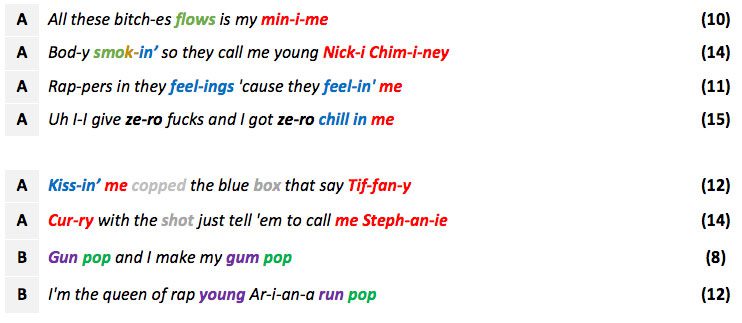


Bridge 2 is the only section in the entire song that features a rapped vocal delivery. It consists of two parts/stanzas and features an AAAA / AABB rhyme scheme, with the primary rhyme occurring at the end. As is the case with the sung bridge 1 section, it contains a plethora of in-line and cross-line rhymes as well as cross-stanza rhymes and commonalities that reinforce the connection value of the section as a whole with the listener.
Reference the color-coded chart above and the Vocal Melody Section of the report for further details.
Vocals
Side to Side features a plethora of different vocal characteristics that take its impact to a heightened level. They include rapped, sung, spoken, shouted, single-voiced, multi-voiced group, large choir-like mixed gender group, and more in a variety of combinations throughout.
Key
S: Sung R: Rapped SP: Spoken SH: Shout -/-: First Stanza/Second Stanza
Key:
Solo Lead Vocals
- Solo Lead 1: Ariana Grande – processed with ample reverb and delay – primary panning around 12:00
- Solo Lead 2: Nicki Minaj – processed with ample reverb in bridge 1, drier and more intimate in bridge 2 – primary panning around 12:00
Harmony/Double Background Vocals
- Double 1: Solo Female (Ariana Grande) – same pitch as the lead – less reverb than the lead – lower in the mix than the lead – primarily panned around 12:00
- Double 2: Female group – same pitch as the lead – less reverb than the lead – slightly lower in the mix than the lead – encompasses the full stereo field
- Harmony 1: Solo female – single voice and different pitch than the lead – primary panning around 12:00
- Harmony 2: Mixed gender group – processed with ample reverb and spans the stereo field
Independent Background Vocals
- Independent Background 1: Solo female – lower in the mix than the lead – processed with ample reverb, but no delay
- Independent Background 2: Female group – single note and multi-part harmony vocals – encompasses the full stereo field
- Independent Background 3: Mixed gender group choir style vocals – encompasses the full stereo field
- Independent Background 4: Male “whoa” sounding vocal shout – processed with ample reverb and a lengthy delay tail that decays over the course of a bar – essentially functions as a transitional marker between stanzas and sections when it’s in effect
- Independent Background 5: Heavily processed male “hey” and “ou” shouts with a militaristic-type quality
Markings
- Bold lyrics: Indicate an additional voice doubling the lead vocal. Harmony details are included at the top of each section in which they appear. Details appear in each section in which doubling occurs
- Underlined lyrics: Indicate the presence of vocal harmonies in addition to the lead vocal. Harmony details are included at the top of each section in which vocal harmonies appear
- (Lyrics in parentheses): Indicate independent background vocals. Details are included at the top of each section in which independent backgrounds appear
Vocals featured in the mix:
- Lead 1: Ariana Grande
- Lead 2: Nicki Minaj
Line 1: I been there all night
Line 2: Ariana
Line 3: I been there all day
Line 4: Nicki Minaj
Line 5: And boy got me walkin’ side to side
Line 6: Let them hoes know, uh
The first chorus features Grande’s sung vocal coupled with Minaj’s spoken “Ariana” and “Nicki Minaj” plugs on lines 2 and 4, and additional commentary on line 6. Both vocals are processed with ample reverb and a pronounced delay effect that is most audible on the last lyric of each line.
Vocals featured in the mix:
- Lead 1: Ariana Grande
- Independent Background 2: Female group (Grande)
- Independent Background 4: Male vocal shouts (“whoa”)
Line 1: I’m talkin’ to ya (whoa)
Line 2: See you standin’ over there with your body
Line 3: Feelin’ like I wanna rock with your body
Line 4: And we don’t gotta think ’bout nothing (’bout nothin’)
Line 5: I’m comin’ at ya
Line 6: ‘Cause I know you got a bad reputation
Line 7: Doesn’t matter ’cause you give me temptation
Line 8: And we don’t gotta think ’bout nothin’ (’bout nothin’)
Verse 1 features Grande’s sung lead vocal. Its characteristics are very similar to her vocal in the preceding chorus (i.e. ample reverb and delay). There are two notable vocal additions:
- Grande’s “’bout nothin’(g)” vocal at the end of lines 4 and 8 is repeated by an independent Grande background vocal. It’s lower in the mix than the lead and consists of multiple voices, which encompass the full stereo field. Note that it is processed with ample reverb, but no delay.
- A male “whoa” sounding vocal shout enters the mix on the first beat of part X and part Y. It is heavily processed with ample reverb and a lengthy delay tail that decays over the course of a bar. Note that this type of shout is a characteristic indicative of the Reggae genre (e.g. songs by Peter Tosh, Lee Scratch Perry, and more).
Additionally, note that the pronounced delay effect is diminished on the lead vocal at the end of lines 4 and 8 in contrast to the rest of the section. This is so that it doesn’t interfere with the background vocal repeat that follows.
Vocals featured in the mix:
- Lead 1: Ariana Grande
- Double 1: Solo female (Grande)
- Independent Background 3: Mixed gender group “ou” vocals
- Independent Background 4: Male vocal shouts (“whoa”)
- Independent Background 5: “Militaristic” male “hey” and “ou” vocals.
Line 1: These friends (whoa) keep talkin’ way too much
Line 2: Say I should give you up
Line 3: Can’t hear them no ’cause I
Pre-chorus 1 features the core lead vocal characteristics as heard in the preceding verse. There are, however, some notable changeups to take note of:
- Grande’s lead vocal is now multi-tracked. The additional vocal is positioned around 12:00, is lower in the mix than the lead, and drier as well (i.e. processed with less reverb and no delay).
- The delay effect implemented on Grande’s lead on the last two lyrics on lines 1 and 2 – “much” and “up” – is more pronounced than in the preceding sections.
- The male “whoa” shout that was first introduced in the preceding verse is heard in tandem with the lyric “friends” at the beginning of the section, following the “these friends” pickup.
- Underneath Grande’s lead, a heavily low-pitch processed and effected male “hey, ou, ou” vocal is featured throughout the section. This provides additional color and texture as well as militaristic type vibe that jibes with the march characteristic of the snare. Toward the end of the section, the “hey” and “ou” vocals speed up, coupled with the “hey” vocal ascending in pitch. Together, these changeups act in a transitional manner along with the drum fill in taking the tension and intensity to a climax in ushering the listener into the chorus payoff that follows.
Vocals featured in the mix:
- Lead 1: Ariana Grande
- Double 2: Female group (Grande)
- Independent Background 2: Female group (Grande)
- Independent Background 4: Male vocal shout (“whoa”)
Line 1: I been there all night
Line 2: I been there all day
Line 3: And boy got me walkin’ side to side
Line 4: I been there all night
Line 5: I been there all day
Line 6: And boy got me walkin’ side to side (side to side)
Chorus 2 features the same core Grande lead vocal characteristics as the preceding pre-chorus. The primary difference is the characteristic of the background vocals. While similar to the multi-tracked vocal in the pre-chorus, the double is at a higher level in the mix and features additional voices that span the full stereo field. As a result, the lead vocal is fuller and more powerful, thus standing out more in the mix.
Additionally, two independent background vocals are featured in the mix:
- A curtailed male “whoa” vocal shout sounds in tandem with the lyric “night” at the end of line 4. Note that the “wh” part of the vocal is the most audible, sounding more like a hiccup in the mix.
- On line 6, multi-voice/multi-pitch harmonized “ah” female background vocals enter the mix. They sound underneath Grande’s lead, providing the section with additional color and texture. Following Grande’s “side to side” lead vocal at the end of the line, they repeat the title for one iteration.
Vocals featured in the mix:
- Lead 1: Ariana Grande
- Double 2: Female group (Grande)
- Harmony 2: Mixed gender group
- Independent Background 2: Female group (Grande)
- Independent Background 4: Male vocal shouts (“whoa”)
Line 1: Been tryna hide it
Line 2: Baby what’s it gonna hurt if they don’t know
Line 3: Makin’ ev’rybody think that we solo
Line 4: Just as long as you know you got me (you got me)
Line 5: And boy I gotcha (whoa)
Line 6: ‘Cause tonight I’m making deals with the devil
Line 7: And I know it’s gonna get me in trouble
Line 8: Just as long as you know you got me
Verse 2 features very similar vocal characteristics as verse 1. The following are the main differences:
- The first line, “been tryna hide it,” features pronounced multi-tracking, which is very similar to the group female vocal doubling in the chorus. This helps to punctuate the onset of the section. The multi-tracking appears in the same manner at the beginning of part Y on the lyrics “and boy I gotcha.”
- The mixed-gender group harmonizes with Grande’s lead on the lyrics “deals with the devil” and “get me in trouble.” This provides engaging “like” section contrast, as there were no harmonies of this kind in the first verse, as well as additional color, texture, and lyrical emphasis.
- The last lyric in the section, “me,” features a very pronounced delay effect with a lengthy tail. This effect was not implemented at the end of the first verse. It is used here to help fill the void at the end of the section along with the synth effect (note: the repeat vocals present at the end of the first verse are not present at the end of the second verse).
Vocals featured in the mix:
- Lead 1: Ariana Grande
- Double 1: Solo female (Grande)
- Independent Background 3: Mixed gender group “ou” vocals
- Independent Background 5: “Militaristic” male “hey” and “ou” vocals.
Line 1: These friends keep talkin’ way too much
Line 2: Say I should give you up
Line 3: Can’t hear them no ’cause I
Pre-chorus 2 features essentially the same vocal characteristics as its pre-chorus 1 counterpart. The primary difference is that additional mixed group vocal “ou’s” are implemented at the tail end of the section, providing the transition into the chorus with subtly increased texture and power. Additionally, the single “whoa” vocal shout that is featured at the onset of the first pre-chorus is omitted this time around.
Vocals featured in the mix:
- Lead 1: Ariana Grande
- Lead 2: Nicki Minaj (brief bridge vocal pickup at the end of the chorus)
- Double 2: Female group (Grande)
- Independent Background 1: Solo female (Grande)
- Independent Background 2: Female group (Grande)
- Independent Background 3: Mixed gender group
- Independent Background 4: Male vocal shout (“whoa”)
Line 1: I been there all night
Line 2: I been there all day
Line 3: And boy got me walkin’ side to side (side to side)
Line 4: I been there all night (Been there all night baby)
Line 5: I been there all day (Been there all day baby)
Line 6: And boy got me walkin’ side to side (side to side)
Chorus 3 features the same core lead vocal characteristics as chorus 2. The primary difference between the two sections is the Grande multi-part harmonized independent background vocals – in particular their prominence within the section.
Instead of entering only in the second half/part Y of the section as they do in chorus 2, here the “ah…side to side” vocals are instituted on line 3 of the first half of the section. This harmonized background vocal remains in effect in the second half/part Y of the section as well, and features two new vocal parts:
- “Been there all night baby”
- “Been there all day baby”
These vocals follow at the end of lines 4 and 5, respectively, and provide the section with an additional call and response-type characteristic, as well as engaging “like section” contrast compared to choruses 1 and 2. Additionally, note that these lines as well as the “ah…side to side” vocal that concludes the section features additional layers of harmony compared to the first two choruses, including the mixed gender backgrounds.
At the tail end of the section, an additional Grande solo “got me walkin’ side to side, boy” vocal enters the mix in conjunction with the background vocals and Minaj’s “uh, yo” pickup into the ensuing bridge. Note that her vocal here features a lower-pitch and a slurred delivery compared to the other vocals within the section.
Vocals featured in the mix:
- Lead 2: Nicki Minaj – Sung
- Harmony 1: Solo female (Minaj)
- Independent Background 4: Male vocal shouts (“whoa”)
Line 1: It’s the new style with the fresh type of flow
Line 2: Wrist icicle ride dick bicycle
Line 3: Come true yo get you this type of blow
Line 4: If you wanna Minaj I got a tricycle
Bridge 1 features Nicki Minaj’s sung vocal with a Trinidadian accent, which provides the song with more of an authentic Reggae vibe. Her vocal is processed with ample reverb, and pronounced delay is featured on the last lyric of lines 1 and 3 – “flow” and “blow,” respectively. Note that the effect processing commonality reinforces the impact of the rhyme due to the familiarity imparted.
Furthermore, an additional Minaj vocal harmonizes with the lead at a slightly lower level at the beginning of lines 1 and 3 on the lyrics “it’s the new style” and “come true yo.” This provides the section with additional color and texture, and reinforces the memorability of the section due to the effect processing familiarity imparted.
Also note that the shouted “whoa” vocal is implemented once again at the beginning of the section in tandem with the lyric “new”.
Vocals featured in the mix:
- Lead 2: Nicki Minaj, rapped
- Double 2: Female group, rapped (Minaj)
- Independent Background 1: Solo female, sung
- Independent Background 4: Male vocal shouts (“whoa”)
- Independent Background 5: “Militaristic” male “hey” vocals
Line 1: Whoop, whoop, whoop All these bitches flows is my mini-me
Line 2: Body smokin’ so they call me young Nicki Chimney
Line 3: Rappers in they feelings ’cause they feelin’ me (murda)
Line 4: Uh I-I-I give zero fucks and I got zero chill in me
Line 5: Kissin’ me copped the blue box that say Tiffany
Line 6: Curry with the shot just tell ’em to call me Stephanie (ow)
Line 7: Gun pop and I make my gum pop
Line 8: I’m the queen of rap young Ariana run pop
While bridge 2 also features a lead vocal from Nicki Minaj, there are two primary differences to take note of:
- She’s rapping as opposed to singing
- The reverb processing on her vocals is much less than the preceding bridge. As a result, its drier characteristic provides her lead with a more intimate and direct vibe.
There are a few background vocals that play a role throughout the section:
- The male shouted “whoa” vocals are implemented at the beginning of both parts/stanzas.
- Minaj’s vocal is multi-tracked on the bolded lyrics as detailed above. This increases the engagement value of the section due to the punctuation it provides.
- A one-off, sung, reverb-laden background vocal – “murda” – is featured at the end of line 3. As subtle as it is, it provides the section with heightened engagement value do the contrast it provides.
- A high-pitched “ow” scream is heard at the end of line 6. This is another element that is indicative of the Reggae genre (e.g. Lee “Scratch” Perry songs)
- The “militaristic” male “hey” shouts enter the mix in the second stanza/part Y. They become more frequent toward the end of the section as the song heads toward pre-chorus 3. Together with the accompaniment, they help to bring the intensity level of the section to a climax, and provide stringent contrast against the ensuing breakdown on the lyrics “run pop.” This provides the full “Ariana run pop” plug/boast with increased emphasis in the scope of the section.
Vocals featured in the mix:
- Lead 1: Ariana Grande
- Harmony 1: Solo Female (Grande)
- Independent Background 3: Mixed Gender “ou” vocals
Line 1: These friends keep talkin’ way too much
Line 2: Say I should give him up
Line 3: Can’t hear them no ’cause I
Pre-Chorus 3 features the core characteristics of pre-chorus 2. However, there are some noticeable differences as well:
- The “militaristic” “hey” and “ou” vocals have been omitted from the mix.
- The pronounced delay effect featured in pre-chorus 2 on the lyrics “much” and “up” is mitigated this time around.
- The single voice harmony has been changed up. It is featured only on the lyrics “way too much” and “give him up” as opposed to the entire section, it is sung at a lower pitch than the lead, it loosely harmonizes with the lead (as opposed to a spot-on double), and is processed with significant reverb as opposed to the dryer quality in the second pre-chorus.
- The mixed-group “ou” vocal stabs that sound in tandem with the “friends,” “much” and “up” lyrics as is the case in the second pre-chorus are featured at a slightly lower level in the mix in pre-chorus 3. Additionally, they don’t become more frequent toward the end of the section so as not to detract from Grande’s “I” section-defining melisma.
Overall, the more minimal and subtle characteristics of the vocals in the third pre-chorus jibe with the sparser characteristics of the accompaniment in providing pronounced dynamic and arrangement contrast, which accentuates the engagement value of the song as a whole as it heads toward the final chorus, which features significantly more vocal types in the mix.
Vocals featured in the mix:
- Lead 1: Ariana Grande
- Lead 2: Nicki Minaj (pickup into the outro)
- Double 2: Female group (Grande)
- Independent Background 1: Solo female (Grande)
- Independent Background 2: Female group
- Independent Background 3: Mixed gender group
- Independent Background 4: Male vocal shout (“whoa”)
Line 1: I been there all night (Been there all night baby)
Line 2: I been there all day (Been there all day baby)
Line 3: And boy got me walkin’ side to side (side to side)
Line 4: I been there all night (Been there all night, baby)
Line 5: I been there all day (Been there all day, baby) (oh baby)
Line 6: And boy got me walkin’ side to side (side to side)
Chorus 4, which is the last chorus in the song, features both commonalities and differences with its chorus 3 predecessor:
Commonalities
- Grande’s lead and the female group double (multi-voiced but same pitch as the lead) remains the same as chorus 3.
- The “whoa” vocal shouts appear at the beginning of both parts/stanzas – just as they do in the preceding chorus.
- Minaj’s “uh, yo” pickup at the end of the section.
Differences
- The multi-part harmonized background vocals (e.g. “ah…been there all night/all day baby”) are put into effect right from the start of the section. Chorus 2 had it only in effect on line 6, and chorus 3 instituted it earlier on line 3. Note that the mixed group vocals double this background vocal throughout the course of the section, providing it with increased color, texture and prominence.
- An additional Grande solo background vocal is featured in the mix. It is processed with ample reverb and delay, both loosely harmonizing with the lead and background vocals, as well being featured independently. Overall, her vocal delivery is highly melismatic, providing the last chorus with a heightened degree of color, texture and excitement.
Vocals featured in the mix:
- Lead 2: Nicki Minaj
- Independent Background 1: Solo female (Grande)
- Independent Background 2: Female group
Line 1: This the new style with the fresh type of flow (Been there all night baby)
Line 2: Wrist icicle ride dick bicycle (Been there all day baby)
Line 3: Come true yo get you this type of blow
Line 4: If you wanna Minaj I got a tricycle (ah, side to side)
The vocals in the outro are a hybrid of bridge 1 (Nicki Minaj’s sung lead) and the chorus (the harmonized Grande group background “been there all night/all day baby, ah…side to side” vocals). Both vocals are featured concurrently in the section. As a result, both artists get a chance to shine at the conclusion of the song, coupled with one additional iteration of the song title.
Additionally, a single voice background vocal enters the mix (Grande) that is singing a prolonged nonsense lyric melisma.
Begins on C#4 and ends a perfect fourth higher on F#4.
Begins a major second lower on E4 and ends a perfect fifth lower on A3.
Begins a perfect fifth higher on E4 and ends a major sixth higher on C#5.
Begins an octave lower on C#4 and ends a perfect fourth higher on F#4.
Begins a major second lower on E4 and ends a major second higher on F#4.
Begins a major second lower on E4 and ends a major sixth higher on C#5.
Begins an octave lower on C#4 and ends a perfect fourth higher on F#4.
Begins a major sixth lower on A3 and ends a minor third lower on F#3.
N/A – N/A
Begins on E4 and ends a major sixth higher on C#5
Begins an octave lower on C#4 and ends a perfect fourth higher on F#4.
Begins a major sixth lower on A3 and ends a minor third lower on F#3.
Line 1: I’m talk-in’ to ya
Line 2: See you stand-in’ o-ver there with your bod-y
Line 3: Feel-in’ like I wan-na rock with your bod-y
Line 4: And we don’t got-ta think ’bout noth-ing
Line 5: I’m com-in’ at-cha
Line 6: ‘Cause I know you got a bad rep-u-ta-tion
Line 7: Does-n’t mat-ter ’cause you give me temp-ta-tion
Line 8: And we don’t got-ta think ’bout noth-in’
High: F#4
Low: A3
Key
Bold: Subtle phrase or line segmentation put into effect by a prolonged lyric or short rest (i.e. sixteenth note)
(//): Pronounced phrase or line segmentation put into effect by a rest that is an eighth note or longer
(Number): Line syllable count
Both stanzas (parts X and Y) feature the same line-to-line syllable count: 5-11-11-9.
In-Line Segmentation
Lines 2 & 3 (first stanza), Lines 6 & 7 (second stanza): Each 11 syllable line is subtly broken into two shorter, easier to digest 7 and 4 syllable segments. This is put into effect by the following lyrics which are stretched across two pitches (E-F#) and possesses an eighth note value in contrast to the sixteenth notes that precede and follow them.
- Line 2: “the-re”
- Line 3: “ro-ck”
- Line 6: “ba-d”
- Line 7: “gi-ve”
Note that this multi-line commonality also reinforces the memorability factor of the section as a whole due to the familiarity it imparts.
Additionally, the last line in both stanzas – lines 4 and 8 – features two distinct rhythms. The first half of each line possesses a sixteenth note rhythm, while the second half possesses a longer, eighth note-driven rhythm.
Cross-Line Segmentation
Each line in both stanzas is segmented from one another by a rest ranging from a quarter to a dotted quarter duration.
Cross-Stanza Segmentation
Stanzas 1 and 2 (parts X and Y) are segmented from one another by an eighth + dotted eighth rest.
Both stanzas feature a 1a / 2-1b / 2-1b / 3a melodic part structure across their four respective lines. While each part contains different melodic and/or rhythmic characteristics compared to the others in the section, each contains certain commonalities as well. As a result, the contrast helps to keep the full section engaging, while the repetition helps to get it ingrained in the listener’s head.
As a whole, the section is firmly constructed on the K.I.S.S. principal (keep it simple and singable), consisting of just five pitches, and residing primarily in just three (D, E & F#). The majority of the section consists primarily of monotone, straight sixteenth note runs, with the exceptions being a few minor embellishments and the longer rhythms that define the last line of each stanza. This rhythmic contrast adds variety to the section and helps to bring each stanza to a close.
Additionally, note that the last four syllables on the first three lines in each stanza feature the same melody and rhythm – four sixteenths on E. As a result, each line (and rhyme as well) is reinforced with the listener at the end despite the differences that precede them.
Line 1: I’m talk-in’ to ya
Line 2: See you stand-in’ o-ver there with your bod-y
Part 1a: “I’m talk-in’ to ya”
Line 1 is composed of part 1a. Consisting of only one segment, this short line essentially functions as a pickup, as it occurs in the last measure of the chorus that precedes it. It is very simple and straightforward, possessing a monotone E sixteenth note run. Note that this segment is reinforced three additional times within the stanza.
Line 2 is composed of two melodic parts – part 2 and part 1b.
Part 2: “See you stand-in’ o-ver there”
Line 2 commences on the “and” of beat 2. It begins on D, which is a step lower than line 1 that precedes it. As is the case with line 1, the majority of this segment features a monotone sixteenth note run, albeit on D as opposed to E. However, there are two instances where this monotone run is broken up:
- The second lyric/syllable, “you,” is an E.
- The last lyric, “the-re” is stretched across two pitches, E and F#.
As subtle as these two departures are, they provide the first segment (and the line as a whole) with engaging color and contrast against the monotone run that precedes it. Note that this segment also reoccurs throughout the section.
Part 1b: “with your bod-y”
Part 1b, which occurs at the end of the line, is a reversion back to the sixteenth note run on E that defines line 1. This reinforces the memorability factor of this two line run by concluding in the same manner as it began:
Line 3: Feel-in’ like I wan-na rock with your bod-y
Line 4: And we don’t got-ta think ’bout noth-ing
Part 2 / Part 1b: “Feel-in’ like I wan-na rock / with your bod-y”
Line 3 is composed of part 2 and part 1b. It is a melodic and rhythmic carbon copy of line 2 that precedes it.
Part 3a: “And we don’t got-ta think ’bout noth-ing”
Line 4 is composed of part 3a. It features both commonalities and differences with lines 1, 2 and 3 that precede it:
Commonality
- It begins with a monotone run, consisting of D sixteenth notes.
Differences
- Line 4 never ascends beyond the lowest pitch on the other lines, D.
- It concludes in a highly differentiated manner compared to lines 1 – 3. The lyrics “think ‘bout noth-ing” descend via D-C#-C#-A, and possess the longest note values in the scope of the stanza, consisting of eighth notes and a quarter note to conclude.
Essentially, the aforementioned differences function to provide both engaging contrast in the scope of the stanza, as well as wind the stanza down as the song heads into the second stanza/part Y that follows.
Line 5: I’m com-in’ at-cha
Line 6: ‘Cause I know you got a bad rep-u-ta-tion
Part 1: “I’m com-in’ at-cha”
Line 4, which is the first line in the second stanza/part Y, is composed of part 1. It is a melodic and rhythmic carbon copy of its line 1 counterpart.
Part 2 / Part 1b: “’Cause I know you got a bad / rep-u-ta-tion”
Line 6 is composed of part 2 and part 1b. It is a melodic and rhythmic carbon copy of its line 2 counterpart.
Line 7: Does-n’t mat-ter ’cause you give me temp-ta-tion
Line 8: And we don’t got-ta think ’bout noth-in’
Part 2 / Part 1b: “Does-n’t mat-ter ’cause you give / me temp-ta-tion”
Line 7 is composed of part 2 and part 1b. It is a melodic and rhythmic carbon copy of its line 3 counterpart.
Part 3a: “And we don’t got-ta think ’bout noth-in’”
Line 4 is composed of part 3a. It is a melodic and rhythmic carbon copy of its line 4 counterpart.
Line 1: Been try-na hide it
Line 2: Ba-by what’s it gon-na hurt if they don’t know
Line 3: Mak-in’ ev-’ry-bod-y think that we so-lo
Line 4: Just as long as you know you got me
Line 5: And boy I got-cha
Line 6: ‘Cause to-night I’m mak-ing deals with the dev-il
Line 7: And I know it’s gon-na get me in trou-ble
Line 8: Just as long as you know you got me
High: A4
Low: A3
Key
Bold: Subtle phrase or line segmentation put into effect by a prolonged lyric or short rest (i.e. sixteenth note)
(//): Pronounced phrase or line segmentation put into effect by a rest that is an eighth note or longer
(Number): Line syllable count
Both stanzas (parts X and Y) in the second verse feature the same line-to-line syllable count as the first verse.
The second verse features a very similar, and in some cases identical, segmentation structure to the first verse.
The first stanza features the same 1-2-2-3a melodic part structure as its verse 1 counterpart. The second stanza, however, possesses a 4-2-2-3b structure. Here, the first and last lines of the stanza possess both commonalities and differences with their stanza 1 counterparts, hence the part 4 and part 3b classifications. The two middle lines, however, possess the same melodic and rhythmic characteristics as their verse 1 and verse 2 counterparts.
As a result, the contrast helps to heighten the engagement of the song and prevent cookie-cutter monotony from occurring, while the repetition helps to get the vocal ingrained in the listener’s head.
As is the case with verse 1, the overall shape of the verse 2 melody is based on monotone runs emphasizing D and E, offering little in the way of ascending or descending phrases in contrast to the pre-chorus and chorus.
Line 1: Been try-na hide it
Line 2: Ba-by what’s it gon-na hurt if they don’t know

Part 1: “Been try-na hide it”
Line 1 is composed of part 1. It is a melodic and rhythmic carbon copy of its verse 1 line 1 counterpart.
Part 2 / Part 1b: “Ba-by what’s it gon-na hurt / if they don’t know”
Line 2 is composed of part 2 and part 1b. It is a melodic and rhythmic carbon copy of its verse 1 line 2 counterpart.
Line 3: Mak-in’ ev-’ry-bod-y think that we so-lo
Line 4: Just as long as you know you got me
Part 2 / Part 1c: “Mak-in’ ev-’ry-bod-y think / that we so-lo”
Line 3 is composed of part 2. It is a melodic and rhythmic carbon copy of its verse 1 line 3 counterpart.
Part 3a: “Just as long as you know you got me”
Line 4 is composed of part 2 and part 1c. It is essentially a melodic and rhythmic carbon copy of its verse 1 line 4 counterpart, with the sole exception being the E eighth note at the end as opposed to a sixteenth note.
Line 5: And boy I got-cha
Line 6: ‘Cause to-night I’m mak-ing deals with the dev-il
Part 4: “And boy I got-cha”
Line 5 is composed of part 4, and occurs only once in the scope of both verse sections. It possesses both commonalities and differences with its verse 1, line 5 counterpart:
Commonalities
- It begins and ends on E.
- It features an all sixteenth note delivery.
Differences
- From E the melody leaps up a fourth to A, and then descends down the scale back down to E.
The commonalities help to keep the familiarity/memorability of both verse sections in effect, while the melodic contrast provides an engaging burst of color and prevents cookie-cutter monotony from occurring. It also accentuates the impact of the key lyrics, “and boy I got-cha.”
Part 2 / Part 1c: “‘Cause to-night I’m mak-ing deals / with the dev-il”
Line 6 is composed of part 2 and part 1c. It is a melodic and rhythmic carbon copy of its verse 1 line 6 counterpart, except for the eighth note at the end as opposed to a sixteenth note.
Line 7: And I know it’s gon-na get / me in trou-ble
Line 8: Just as long as you know you got me
Part 2 / Part 1c: “And I know it’s gon-na get me in trou-ble”
Line 7 is composed of part 2 and part 1c. It is a melodic and rhythmic carbon copy of its verse 1 line 7 counterpart, except for the E eighth note at the end as opposed to a sixteenth note.
Part 3b: “Just as long as you know you got me”
Line 8 is composed of part 3b. It possesses both commonalities with its verse 1, line 8 counterpart (represented by part 3a), and differences as well.
Commonalities
- Everything up until the last C#.
Differences
- Instead of descending down to an A quarter note to conclude on the lyrics “got me,” the melody ASCENDS up to the tonic, F#, via C# – E – F#. Note that this is the only line in either verse sections that concludes on the tonic.
As is the case elsewhere, the commonalities help to reinforce the familiarity/memorability factor with the listener, while the changeup at the end has two primary functions:
- It provides engaging contrast in the scope of both verse sections, as this is only line in both verse sections that concludes with a melodic ascent at the tail end. The others are monotone or descend.
- It provides the key lyrics, “got me,” with a heightened degree of surety, impact and emotion via the ascending “go-o-t me” melisma. The preceding “got me” is conveyed in a more tender manner.
Line 1: These friends keep talk-in’ way too much
Line 2: Say I should give you up
Line 3: Can’t hear them no ’cause I
High: C#5
Low: E#4
Key
Bold: Subtle phrase or line segmentation put into effect by a prolonged lyric or short rest (i.e. sixteenth note)
(//): Pronounced phrase or line segmentation put into effect by a rest that is an eighth note or longer
(Number): Line syllable count
Pre-choruses 1 and 2 have the same syllable count, 8-6-6.
Notice that aside from the two syllable pickup on line 1 (i.e. “these friends”), each phrase consists of six syllables.
In-Line Segmentation
Line 1: “These friends” is segmented from “keep talk-in’ way too much” by an eighth rest. Additionally, note that the lyric “friends” is a quarter note, which is longer than the eighth note lyrics that precede and follow it.
Line 2: A similar type of segmentation effect as found on line 1 is implemented on the second syllable on line 2, “I.” It possesses a dotted eighth value compared to the eighth and sixteenth notes that precede and follow, respectively. While the segmentation is subtler than that found on line 1, it does create rhythmic familiarity in the scope of the section, thus accentuating the memorability factor.
Cross-Line Segmentation
Each line in pre-choruses 1 & 2 is segmented from one another for the duration of a quarter rest.
Pre-choruses 1 and 2 feature a 1-2a / 2a’ / 2b-3a melodic part structure. Following the brief part 1 pickup, each successive line/phrase features a variation of part 2, which is defined by a descending C#-B-A-G# progression at its core. The commonalities between each part 2 iteration heightens the overall memorability factor of the section, while the subtle differences prevent it from becoming overly monotonous. The most pronounced shift occurs at the very end of the section, where an infectiously prolonged “I” melisma is sung by Grande.
Additionally, note that the pre-chorus features a heightened degree of melodic variation and overall longer notes that the preceding verse. This helps to heighten the song’s overall engagement factor as a result. Additionally, it features primarily descending melodic phrases, as opposed to the monotone characteristic of the verse.
Verse (e.g. Verse 1)
Pre-Chorus (e.g. Pre-Chorus 1)
Line 1: These friends keep talk-in’ way too much
Line 2: Say I should give you up
Line 3: Can’t hear them no ’cause I
Line 1 is composed of two melodic parts – part 1 and part 2a.
Part 1: “These friends”
Part 1 comprises the first two notes/lyrics of the section, “these friends.” Functioning as a brief pickup, “these” enters on the last beat of the preceding verse, and “friends” enters on beat 1 of the pre-chorus.
Beginning a fifth UP from the end of verse 1 and a step DOWN from the end of verse 2, this two-word phrase ascends from E to F# and possesses an eighth – quarter note rhythm. Note that the quarter note on the lyric “friends” and the eighth rest that follows achieves the following:
- It further slows down the vocal delivery coming out of the verse (remember – both verse sections consist primarily of sixteenth notes and a succession of eighth notes at the end of each stanza). This rhythmic contrast heightens the engagement value of the song on a cross-section basis.
- It instantly heightens the level of tension and anticipation in the song. This is due in part to the lyrical incompleteness that the phrase imparts by concluding with an ascent to the tonic, and the pause that ensues before its conclusion (i.e. what is it about “these friends”?).
Part 2a: “keep talk-in’ way too much”
Part 2a comprises the balance of the line following the eighth rest. It begins a fifth up from part 1 on C#, descends down the scale to G#, and then doubles back to A before concluding on the tonic, F#. Rhythmically, the entire part consists of eighth notes. Aside from a couple of instances in the second verse (i.e. part 4 and part 3a), this progression provides stringent and engaging melodic contrast against the verse sections that precede them.
Part 2a’: “Say I should give you up”
Line 2 is composed of part 2a’. While it features the same melodic progression as part 2a that precedes it, its rhythm is slightly changed up. Instead of straight eighth notes, the second and third lyrics/syllables feature a dotted eighth and sixteenth value, respectively. While subtle, this syncopation provides engaging contrast in these otherwise identical back-to-back parts.
Part 2a – Line 1
Part 2a’ – Line 2
Line 3 is composed of two melodic parts – part 2b and part 3.
Part 2b: “Can’t hear them no ‘cause”
Part 2b comprises the entire line except for the last lyric, “I.” It features the same melodic progression and rhythm as part 2a, with the difference being that it doesn’t conclude by dropping down to the tonic, F#, at the end, and is not followed by a rest. As a result, the line is kept in motion as it heads into the infectious melisma in part 3 that follows.
Part 2b – Line 3
Part 2a – Line 1
Part 3: “I”
Part 3 comprises the last lyric in the section, “I.” It begins up a step up from the end of part 2b on B, and then alternates B-C# across 10 syllables. It is comprised of sixteenth notes until the end, which is a dotted eighth. This melisma achieves the following:
- It provides Ariana Grande with the opportunity to showcase her vocal chops.
- It functions as a highly infectious and engaging vocal WOW factor that takes the impact of the section (and the song) to a heightened level.
- It helps to take the tension, anticipation and excitement factors of the section to an apex as the song heads into the release in the chorus that follows.


Line 1: These friends keep talk-in’ way too much
Line 2: Say I should give him up
Line 3: Can’t hear them no ’cause I
High: D5
Low: E4
Key
Bold or (/): Subtle phrase or line segmentation put into effect by a prolonged lyric or short rest (i.e. sixteenth note)
(//): Pronounced phrase or line segmentation put into effect by a rest that is an eighth note or longer
(Number): Line syllable count
Pre-chorus 3 features the same syllable count as its pre-chorus 1 and 2 counterparts.
Pre-chorus 3 features the same segmentation structure as its pre-chorus 1 and 2 counterparts with one exception. The lyric “no” on line 3 is followed by a brief sixteenth rest. Although subtle, it puts subtle syncopation into effect building momentum into the melismatic climb that occurs at the end of line 3 into motion.
Pre-chorus 3 features a 1-2a’’ / 2c / 2b’-4 melodic structure, which is very similar to the 1-2a / 2a’ / 2b-3a melodic part structure that defines pre-choruses 1 and 2. The primary difference occurs at the end of the section (i.e. part 4 as opposed to part 3 as in pre-choruses 1 and 2), which features a differentiated “I” melisma.
Line 1: These friends keep talk-in’ way too much
Line 2: Say I should give him up
Line 3: Can’t hear them no ’cause I
Line 1 is composed of two melodic parts – part 1 and part 2a’’.
Part 1: “These friends”
Part 1 is a melodic, rhythmic, and lyrical carbon copy of its pre-chorus 1 and 2 line 1 counterpart.
Part 2a’’: “keep talk-in’ way too much”
Part 2a’’ is nearly identical to its pre-chorus 1 part 2a counterpart. The sole difference is that the last note is a quarter note as opposed to an eighth, and is followed by an eighth rest as opposed to a quarter rest.
Part 2c: “Say I should give him up”
Line 2 is composed of part 2c. It possesses the same core melodic and rhythmic characteristics as its pre-chorus 1 and pre-chorus 2 counterparts, except for the following:
- Instead of climbing a half step up to A on the “&” of beat 4, it descends a major third down to E. It then ascends a step up to F# to conclude as opposed to descending a minor third to F# as is the case in pre-choruses 1 and 2.
- The last lyric is a quarter note as opposed to an eighth.
While these differences are subtle, the contrast helps to prevent cookie-cutter monotony from occurring.
Part 2a’: Pre-Chorus 1 & 2
Part 2c: Pre-Chorus 3
As is the case with its pre-chorus 1 and 2 counterparts, line 3 in pre-chorus 3 is composed of two parts.
Part 2b’: “Can’t hear them no”
Part 2b’ in pre-chorus 3 is nearly identical to its part 2b counterpart in pre-choruses 1 and 2. The primary difference is that it concludes on G# on the lyric “no” as opposed to ascending to A on the lyric “’cause.”
Part 4: “’cause I”
Following the subtle syncopation imparted by the sixteenth rest that follows part 2b’ and the sixteenth note value of the lyric “’cause” (as opposed to an eighth note), the last lyric, “I” provides the most pronounced contrast compared to pre-choruses 1 and 2 due to the changed up characteristics of the melisma and the additional two beats added to the measure. Instead of alternating B-C# sixteenth notes as is the case in pre-choruses 1 and 2, here it ascends from F# to D, featuring a combination of eighth note triplets, eighth, sixteenth, quarter, thirty-second notes, ending with a half note..
As a result, it achieves everything that the “I” melisma achieves in pre-choruses 1 & 2 (see pre-chorus 1 & 2 above), but on a more colorful and intricate level.
Part 4 – Pre-Chorus 3
Part 3 – Pre-Chorus 1 & 2
Line 1: I been there all night
Line 2: I been there all day
Line 3: And boy got me walk-in’ side to side
Line 4: I been there all night
Line 5: I been there all day
Line 6: And boy got me walk-in’ side to side
High: C#5
Low: C#4
Key
Bold: Subtle phrase or line segmentation put into effect by a prolonged lyric or short rest (i.e. sixteenth note)
(/): Pronounced phrase or line segmentation put into effect by a rest that is an eighth note or longer
(Number): Line syllable count
Both stanzas (parts X and Y) feature the same line-to-line syllable count: 5-5-9. However, note that certain lyrics are stretched past their normal syllable count:
- “Night”: Slurred across two pitches in both stanzas.
- “Day”: Slurred across three pitches in the first stanza, and four in the second stanza.
- “Boy”: Slurred across eight pitches in both stanzas.
- “Side”: The first iteration is slurred across two syllables in both stanzas.
In-Line Segmentation
None. Each line runs straight through without a pause.
Cross-Line Segmentation
Lines are segmented from one another for durations lasting a dotted quarter to a half + dotted eighth.
Cross-Stanza Segmentation
In choruses 2, 3 & 4 stanzas are segmented by a quarter rest + dotted eighth.
In contrast to the verse sections that feature a monotone-based melodic progression at their core and the pre-choruses that feature a descending progression at their core, the chorus features an ascending progression at its core.
Verse (e.g. Verse 1)
Pre-Chorus (e.g. Pre-Chorus 1)
Both chorus stanzas feature an almost identical melodic part structure, with the sole difference being an additional (yet important) note on line 5 – denoted as part 1c:
- Stanza 1: 1a-1b-2
- Stanza 2: 1a-1c-2
Essentially, the part 1’s function to build excitement and anticipation into the payoff that defines part 2, consisting of Grande’s infectious “boy” melisma and the song title “side to side,” which brings each stanza to a conclusion on the tonic.
Line 1: I been there all night
Line 2: I been there all day
Line 3: And boy got me walk-in’ side to side
Part 1a: “I been there all ni-ght”
Line 1 is composed of part 1a. It features an ascending melodic progression that spans a minor seventh – C# to B. It essentially consists of two segments as follows:
Segment 1: “I been there all”
This segment is the core melodic, rhythmic and lyrical commonality shared by each part 1 variation in the section. It begins an octave below where the pre-chorus leaves off on C#, and then leaps up a fourth to two successive F# notes, followed by ascending a minor third to A. Rhythmically, it features a succession of sixteenth notes followed by an eighth note at the end.
Segment 2: “ni-ght”
Segment 2 is the variable in each part 1 iteration and represents the last lyric. Here, the lyric, “ni-ght,” is slurred across two pitches (A-B) and features an eighth – quarter note rhythm.
Part 1b: “I been there all day”
Line 2 is composed of part 1b. It begins with segment 1, which is identical to segment 1 in line 1 that precedes it. Segment 2 represents the last lyric, “day.” In contrast to the lyric “ni-ght” on line 1 that is stretched across two pitches, “day” is slurred across three (A, B, C#). The main difference is that it ascends an additional step up to C#, which causes the line to span a full octave.
While subtle, the higher ending pitch brings up the excitement and builds anticipation for the melisma that follows.
Part 2: “And boy got me walk-in’ side to side”
Line 3 is composed of part 2. It begins a major third below where line 2 ends, but a minor sixth above where lines 1 and 2 begin. As a whole if features a “down a hill / up a hill” type flow, with a thirty-second note, section-defining melisma at its core. It concludes on the tonic, F#, thus bringing the stanza to its conclusion. Note the following:
Ascent/Descent Commonality
With the exception of the closing descent on “boy” from C# to E, which spans a major sixth, each ascent and descent within the line spans a major third – either via major second steps or major third leaps.
Additionally, the 3x back-to-back repetition of the A-F#-E / G#-F#-E / G#-F#-E descending melodic progression at the end helps to reinforce the memorability factor of the line, and the section as a whole.
Song Title Highlight
While the majority of the line is delivered with sixteenth notes, the end of the song title, “to side,” is delivered with longer notes, an eighth and a quarter.
Line 4: I been there all night
Line 5: I been there all day
Line 6: And boy got me walk-in’ side to side (side to side)
Part 1a: “I been there all night”
Line 4 is a melodic, rhythmic, and lyrical carbon copy of line 1 in the first stanza.
Part 1c: “I been there all day”
Line 2 is composed of part 1c. It’s essentially the same as its first stanza counterpart, part 1b, with an additional note tacked onto the end of the “day” melisma (a drop down a step to B). While subtle, the contrast it imparts breaks up the otherwise mostly verbatim stanza repetition within the scope of the section.
Part 2: “And boy got me walk-in’ side to side”
Line 6 is a melodic, rhythmic, and lyrical carbon copy of line 3 in the first stanza.
Line 1: It’s the new style with the fresh type of flow
Line 2: Wrist i-ci-cle ride dick bi-cy-cle
Line 3: Come true yo get you this type of blow
Line 4: If you wan-na Min-aj I got a tri-cy-cle
High: C#4
Low: F#3
Key
Bold: Subtle phrase or line segmentation put into effect by a prolonged lyric or short rest (i.e. sixteenth note)
(/): Pronounced phrase or line segmentation put into effect by a rest that is an eighth note or longer
(Number): Line syllable count
Lines within bridge 1 are very close in their syllable count, ranging from 9 to 12 (10-9-9-12).
In-Line Segmentation
Lines 1 & 3: The first phrase on both of these lines is segmented from the second by the prolonged lyric at the end that is stretched across two pitches for the duration of a quarter note – “sty-le” and “yo-o.”
Line 4: While not as pronounced as lines 1 and 3, the eighth note value of the syllable “-aj” in “Min-aj” provides subtle phrase segmentation due to the sixteenth notes that both precede and follow it.
Cross-Line Segmentation
Lines 1 and 3 are segmented from lines 2 and 4 by an eighth and sixteenth rest, respectively. Line 2 flows directly into line 3. Note that aside from one instance in the pre-chorus and the entire bridge 2 section, bridge 1 features the shortest breaks between lines in the scope of the song.
Bridge 1 features a sung lead vocal from Nicki Minaj, and is sung in the lowest register in the scope of the song. Each line is composed of two melodic parts, which represent the first and second phases.
The first phrase on lines 1 and 3 feature a similar structure, and are denoted as part 1a and 1b, respectively. The first phrase on lines 2 and 4 also feature a similar structure, and are denoted as parts 3a and 3b, respectively.
The second phrase on EVERY line features very similar characteristics, and all are denoted as part 2’s accordingly. The subtle variations are denoted as part 2a, 2b, and 2c. The differences between them only occur at the beginning of each. All end with the same melodic and rhythmic structure, which reinforces the familiarity/memorability of the section as a whole, along with the rhyme reinforcement it provides:
In contrast to the verse sections that feature an essentially monotone melodic progression at their core, the pre-choruses that feature a descending progression at their core and the choruses that feature an ascending progression at their core, bridge 1 essentially features a combination of all three.
Verse (e.g. Verse 1)
Pre-Chorus (e.g. Pre-Chorus 1)
Chorus
Bridge 1
Line 1: It’s the new style with the fresh type of flow
Line 2: Wrist i-ci-cle ride dick bi-cy-cle
Line 1 is composed of two melodic parts – part 1a and part 2a.
Part 1a: “It’s the new style”
The first phrase, denoted as part 1a, begins a major sixth down from where the preceding chorus left off, on A. The first two notes – A sixteenth notes – are pickups that occur at the end of the preceding chorus. The emphasis it put on the lyrics that follow – “new sty-le” – which are a succession of eighth notes that climb from A to C# (“sty-le” is a two-pitch slur). Note that these lyrics stand out due to both their melodic direction as well as the longer note values compared to the lyrics/syllables that precede and follow them.
Part 2a: “with the fresh type of flow”
The second phrase is denoted as part 2a. It begins with two C# sixteenth notes, and concludes with the B-B-A-F# / sixteenth – eighth – sixteenth – eighth motive, which is core commonality between all lines within the section.
Line 2 is composed of two melodic parts – part 3a and part 2b.
Part 3a: “Wrist i-ci-cle”
In contrast to the beginning of line 1 (part 1a), line 2 forgoes the A-B lead up and instead immediately begins on C#. The first phrase, denoted as part 3a, is a monotone run consisting of C# notes. Rhythmically, it features a sixteenth – eighth – sixteenth – eighth rhythm, which is the same rhythm found in the aforementioned motive at the end of part 2a, as well as part 2b that follows. This helps to reinforce the memorability factor of the line (and section) despite the melodic changeup, which keeps things fresh and engaging.
Part 2b: “ride dick bi-cy-cle”
The second phrase is denoted as part 2b. It is the same as part 2a which occurs at the end of line 1 with one changeup – One C# eighth note vs. two C# sixteenth notes. This eighth note essentially functions as the dividing point between both halves of the line, which feature the same rhythm.
Line 3: Come true yo get you this type of blow
Line 4: If you wan-na Min-aj I got a tri-cy-cle
Line 3 is composed of parts 1b and 2a. It features the same melodic and rhythmic structure as line 1 with one exception – A single A eighth note is sung at the beginning of the section as opposed to two A sixteenth notes.
Line 4 is composed of two melodic parts – part 3b and part 2c.
Part 3b: “If you wan-na Min-aj”
The first phrase on the line, denoted as part 3b, begins on the tonic, F#, leaps up a fourth to B, and then follows a succession of C# sixteenth notes, followed by an eighth note to conclude. While the monotone C# delivery is the same as part 3a on line 2, the rhythm is different.
Part 2c: “I got a tri-cy-cle”
Part 2c is the same as parts 2a and 2b with the exception of the first two notes. In this case, they are C#-B sixteenth notes, which differ from how parts 2a and 2b begin.
Line 1: All these bitch-es flows is my min-i-me
Line 2: Bod-y smok-in’ so they call me young Nick-i Chim-i-ney
Line 3: Rap-pers in they feel-ings ’cause they feel-in’ me
Line 4: Uh I-I give ze-ro fucks and I got ze-ro chill in me
Line 5: Kiss-in’ me copped the blue box that say Tif-fan-y
Line 6: Cur-ry with the shot just tell ’em to call me Steph-an-ie
Line 7: Gun pop and I make my gum pop
Line 8: I’m the queen of rap young Ar-i-an-a run pop
High: N/A (Rapped)
Low: N/A (Rapped)
Bridge 2 consists of two stanzas, both of which possess rhythmic similarities and differences with one another. The parts for this section have been grouped by rhythms due to the rapped delivery and lack of pitch content. There are four primary rhythms being used throughout the section as follows:
- Part 1 – Four sixteenths to a beat
- Part 2 – One eighth + two sixteenths to a beat
- Part 3 – Two sixteenths + one eighth to a beat
- Part 4 – Two eighths to a beat
With only two exceptions, these four rhythms account for the entirety of the section. The exceptions are the pickup to line four, “Uh, I, I,” and the middle of line 5, “copped the blue box that say Tiffany.”
Key
(/): Pronounced phrase or line segmentation put into effect by a rest that is an eighth note or longer
As illustrated above, syllables range from as few as 8 to as many as 15.
In-Line Segmentation
There is subtle in-line segmentation put into effect by the use of eighth notes. In the sixteenth note-dominated section, the use of eighths imparts the effect of segmentation, and gives the impression of a sixteenth note + sixteenth rest due to the rapped delivery.
Cross-Line Segmentation
The most pronounced instance of of cross-line segmentation is between lines 3 and 4, which are separated by a quarter rest + a sixteenth rest. All additional segmentation is imparted by the use of eighth notes.
Cross-Stanza Segmentation
There is subtle cross-stanza segmentation put into effect by the use of an eighth note at the end of the first stanza. As is the case with in-line segmentation, the use of eighths imparts the effect of segmentation.
Line 1: “All these bitch-es flows is my min-i-me”
Line 1 progresses straight through rhythms 1 – 2 – 3.
Line 2: “Bod-y smok-in’ so they call me young Nick-i Chim-i-ney”
Line 2 is very similar to line 1. The primary difference is that it features an additional repetition of rhythm 1 at the beginning (1 – 1 – 2 – 3).


Line 3: “Rap-pers in they feel-ings ’cause they feel-in’ me”
Line 3 begins like line 2 with two repeats of rhythm 1, but then changes things up by going directly to rhythm 3 (1 – 1 – 3).
Line 4: “Uh I-I give ze-ro fucks and I got ze-ro chill in me”
Line 4 begins with a rhythmic anomaly, the three-note pick up on the lyrics “Uh, I, I.” It then progresses through a 2 – 2 – 2 – 3 rhythmic phrase, which brings the first stanza/part X to a conclusion.
Line 5: “Kiss-in’ me copped the blue box that say Tif-fan-y”
Line 5 begins with rhythm 3 (it’s the only line to do so). It is then followed by the second rhythmic anomaly in the section, on the lyrics “copped the blue box that say.” It contains elements of rhythms 1 and 3, but the syncopation imparted by the tie separates this from the other rhythms used in the section. The line then closes with another iteration of rhythm 3.
Line 6: “Cur-ry with the shot just tell ’em to call me Steph-an-ie”
Line 6 progresses through rhythms 1 – 2 – 1 – 3. Line 1 also begins 1 – 2.
Line 7: “Gun pop and I make my gum pop”
Line 7 introduces rhythm 4, progressing through rhythms 4 – 1 – 4. This is the simplest rhythm yet, and really helps to drive home the rhyme scheme and lyrical interplay between “gun pop,” “gum pop,” and “run pop.” This line and the one that follows feature the most energetic delivery of the section.
Line 8: “I’m the queen of rap young Ar-i-an-a run pop”
Line 8 follows a rhythmic phrase similar to that of line 7, 1 – 4 – 1 – 4. Lines 7 & 8 are the most repetitive in the scope of the full section, which helps to close out the bridge in a highly memorable manner.
The majority of the song is rich in detail. What follows are a couple of examples from each section. Reference the Story Flow & Meaning section of the report for a full narrative analysis.
- ‘Cause I know you got a bad reputation
- Doesn’t matter ’cause you give me temptation
- ‘Cause tonight I’m making deals with the devil
- And I know it’s gonna get me in trouble
- These friends keep talkin’ way too much
- Say I should give you up
- I been there all night
- I been there all day
- And boy got me walkin’ side to side
- It’s the new style with the fresh type of flow
- Wrist icicle ride dick bicycle
- Body smokin’ so they call me young Nicki Chimney
- Kissin’ me copped the blue box that say Tiffany
- See you standin’ over there with your body (inferred)
- And boy got me walkin’ side to side (inferred)
- Wrist icicle ride dick bicycle
- If you wanna Minaj I got a tricycle
- Body smokin’ so they call me young Nicki Chimney
- Kissin’ me copped the blue box that say Tiffany
- Curry with the shot just tell ’em to call me Stephanie (inferred)
- Gun pop and I make my gum pop
- See you standin’ over there with your body (non-specified place)
- ‘Cause tonight I’m making deals with the devil
- I been there all night
- I been there all day
- I’m talkin’ to ya
- I’m comin’ atcha
- These friends keep talkin’ way too much
- Say I should give you up
- And boy got me walkin’ side to side
- Kissin’ me copped the blue box that say Tiffany
- Gun pop and I make my gum pop
- Feelin’ like I wanna rock with your body
- And we don’t gotta think ’bout nothing
- Doesn’t matter ’cause you give me temptation
- And I know it’s gonna get me in trouble
- Rappers in they feelings ’cause they feelin’ me
- Uh I-I give zero fucks and I got zero chill in me
Male background “whoa” shouts are featured in certain sections throughout the song, background militaristic “hey’s” and “ou’s” are featured in the pre-chorus sections, and Minaj delivers a few nonsense grunts in her lead vocal sections. Reference the Vocal Production Section of the report for details.
Song titles fall within one of two categories – those that are unique, clever, attention grabbing and/or possess a powerful nature (e.g. Black Beatles, Broccoli, Heathens, Panda), and those that possess more of a universal/generic characteristic (e.g. Can’t Stop The Feeling, Let Me Love You, We Don’t Talk Anymore).
Side To Side falls into the former. Taken out of context of the song’s narrative, the prospective listener does not know what Side To Side specifically relates to. As a result, their curiosity is piqued to check out the song and find out what it’s all about. Taken within the context of the narrative, the clever connotation of the title becomes fully apparent due to the song’s hookup/sex theme.
Side To Side appears 13 times throughout the song, in both the chorus and outro sections.
Lead Vocal: Communicated by Ariana Grande at the end of each part/stanza in choruses 2, 3 and 4. In chorus 1, it precedes Minaj’s “let them hoes know” vocal.
Background Vocal: Directly following each “side to side” lead vocal at the end of the second part/stanza in choruses 2, 3 and 4, there is an additional “side to side” communicated by Ariana Grande. It’s also featured at the end of the first stanza in choruses 3 and 4, and at the tail end of the outro where it is featured concurrently with Minaj’s lead.
Line 1: I been there all night
Line 2: Ariana
Line 3: I been there all day
Line 4: Nicki Minaj
Line 5: And boy got me walkin’ side to side
Line 6: Let them hoes know
Line 1: I been there all night
Line 2: I been there all day
Line 3: And boy got me walkin’ side to side *(side to side)
Line 4: I been there all night
Line 5: I been there all day
Line 6: And boy got me walkin’ side to side (side to side)
*Choruses 3 and 4 only
Line 1: This the new style with the fresh type of flow (Been there all night baby)
Line 2: Wrist icicle ride dick bicycle (Been there all day baby)
Line 3: Come true yo get you this type of blow
Line 4: If you wanna Minaj I got a tricycle (ah, side to side)
Side To Side is composed of three primary lyrical themes – hooking up, love/relationships, and boasting. It features two independent narratives – one conveyed by the song’s primary artist, Ariana Grande, and one conveyed by the song’s featured artist, Nicki Minaj:
- Grande’s narrative, which defines the verse, pre-chorus and chorus sections, features love/relationship and hooking up lyrical themes. It’s about a woman who is in a physical relationship with a “hot bad boy,” whom she continues to see despite her friends’ objections – ultimately because the sex is so good (which is cleverly communicated by the song title payoff/summation, “Side To Side”).
- Minaj’s narrative, which defines bridge 1 and bridge 2, features a combination sexual innuendo and boasting about her flows, looks, and stature of herself and Grande in the mainstream.
Both narratives cleverly intertwine in the outro, providing Grande and Minaj with an opportunity to shine together as the song comes to a conclusion.
Key
Green Font: Protagonist #1 communicating (Ariana Grande)
Red Font: Protagonist #2 communicating (Nicki Minaj)
Line 1: I been there all night
Line 2: Ariana
Line 3: I been there all day
Line 4: Nicki Minaj
Line 5: And boy got me walkin’ side to side
Line 6: Let them hoes know
The first chorus is unique in the scope of the song in that it is the only chorus section that consists of one part/stanza as opposed to two, and features additional lyrics not found elsewhere in the song.
Essentially, it functions as a chorus-based intro, as it both provides the summation of the narrative/primary lyrical payoff and plugs the artists featured in the song. Another example of this technique can be found in Pitbull’s Time Of Our Lives.
Odd numbered lines – chorus lyrics: Lines 1, 3, 5
These lines are communicated by the song’s primary artist, Ariana Grande, and feature the chorus lyrics:
Line 1: I been there all night
Line 3: I been there all day
Line 5: And boy got me walkin’ side to side
While out of context with the rest of the narrative (i.e. the verse and pre-chorus haven’t provided the lead up to the lyrical summation/payoff), the inference can be made that the lyrics pertain to a sexual encounter:
- Lines 1 & 3: Communicate that the hooking up has been going on for an extended period of time (i.e. “all night” and “all day”).
- Line 5: Cleverly communicates the consequence of the lengthy hook up – “walkin’ side to side.” This line functions as the song’s primary lyrical payoff, as it both houses the song title and provides the summation of the narrative.
Even numbered lines – artist plug & verse set-up: Lines 2, 4, 6
These lines are communicated by the song’s featured artist, Nicki Minaj. Lines 2 and 4 plug Ariana Grande and Nicki Minaj, respectively. Note that artist plugs function as free marketing build directly into the song, which is especially useful when artists are not announced in conjunction with a song in an airplay environment (i.e. it makes it easier for the listener to find the song). Line 6 functions as a lyrical setup/lead-in to the verse that follows:
Line 2: Ariana
Line 4: Nicki Minaj
Line 6: Let them hoes know
Line 1: I’m talkin’ to ya
Line 2: See you standin’ over there with your body
Line 3: Feelin’ like I wanna rock with your body
Line 4: And we don’t gotta think ’bout nothing
Line 5: I’m comin’ atcha
Line 6: ‘Cause I know you got a bad reputation
Line 7: Doesn’t matter ’cause you give me temptation
Line 8: And we don’t gotta think ’bout nothin’
Lines 1 and 5
The first line in both stanzas functions as a lyrical setup/pickup to the details that follow on the two lines that follow:
- Line 1: “I’m talkin’ to ya” because… (details to follow)
- Line 5: “I’m comin’ at ya” because… (details to follow)
First Stanza/Part X – Lines 2 and 3: Inferred physical detail and desires
Line 2 – Provides observational details about the antagonist: The protagonist is observing the antagonist’s “body” in a non-specified place. Note that a description of the antagonist’s “body” isn’t necessary to communicate that she perceives it as being hot. It’s inferred.
Line 3 – Provides state of mind and desired outcome details: Building upon the observation stated on line 2, line 3 details the effect that the antagonist’s “body” has on the protagonist – the fact that it makes her “feel” that she “wants to rock with his body” (i.e. hook up with him).
Second Stanza/Part Y- Lines 6 and 7: Character and state details
Line 6 – Provides character detail about the antagonist: Now that the listener has inferred physical details about the antagonist as detailed in the first stanza (i.e. that he’s hot), here the listener learns about his character – specifically that he has a “bad reputation.” However, this doesn’t dissuade the protagonist’s desire for him – it actually has the opposite effect as communicated on the preceding line, “I’m commin’ atcha” (“’Cause I know you got a bad reputation”).
Line 7 – Provides detail as to the effect the antagonist’s “bad reputation” has on the protagonist: Line 7 substantiates why the protagonist is pursuing the antagonist despite his “bad reputation” as stated on lines 5 and 6. It, along with his “body,” gives her “temptation.”
Lines 4 and 8: The last line in both stanzas features the same lyrics, “And we don’t gotta think ’bout nothing.” Quite simply it infers that the nature of the relationship will be purely physical. There is no thought process required.
Verse 1 Summed Up
The protagonist observes and approaches a hot guy who has a bad reputation and wants to hook up with him. The inferred basis of the relationship will be purely physical. This serves as the foundation as to why she’s “walking side to side” in the chorus.
Additionally, note that the lyrics establish the essence of the protagonist’s character in a non-direct, roundabout manner – the fact that she’s into hot bad boys.
Line 1: These friends keep talkin’ way too much
Line 2: Say I should give *you up
Line 3: Can’t hear them no ’cause I
The pre-chorus provides a key shift in the narrative relative to the preceding verse sections by introducing the protagonist’s friends into the mix, and their take on the protagonist’s relationship with the antagonist.
Lines 1 and 2
Due to the antagonist’s negative qualities, the protagonist’s friends suggest that she should stop seeing him. Their decisiveness about this is inferred by the lyrics “keep talkin’ way too much” (i.e. they won’t let it go with the protagonist). However, this line also conveys that the protagonist is sick and tired of hearing it (i.e. “they’re talkin’ way too much – I can’t take it anymore!”)
*Note that the lyric “you” on line 2 is changed to “him” exclusively in the third pre-chorus. As a result, the communication is changed from the second person to the third person.
Line 3
Line 3, which is the last line in the pre-chorus, has two primary functions:
- It substantiates that the protagonist is unwilling to heed her friends’ advice to end the relationship with the antagonist (i.e. they’re “talkin’ way too much” about “giving the antagonist up” but she “refuses hear them”).
- It provides the lyrical lead-in to the chorus that follows. Notice that the line doesn’t come to a conclusion in the pre-chorus lyrically or melodically, and instead is continued in the chorus (i.e. “can’t hear them no ‘cause I…been there all night…”).
Pre-Chorus Summed Up
Despite the protagonist’s friends wanting her to break up with the antagonist due to his negative qualities, the protagonist refuses to take their advice because the sex is so good, as communicated in the ensuing chorus.
Line 1: Been tryna hide it
Line 2: Baby what’s it gonna hurt if they don’t know
Line 3: Makin’ ev’rybody think that we solo
Line 4: Just as long as you know you got me (you got me)
Line 5: And boy I gotcha
Line 6: ‘Cause tonight I’m making deals with the devil
Line 7: And I know it’s gonna get me in trouble
Line 8: Just as long as you know you got me
Lines 1 and 5
As is the case in the first verse, the first line in both stanzas functions as a lyrical setup/pickup to the details that follow on the two subsequent lines:
- Line 1: “Been tryna hide it” (details to follow)
- Line 5: “And boy I gotcha” (details to follow)
First Stanza (Part X)
Lines 1, 2 and 3 expound on the premise that was initially established in the pre-chorus – the fact that the protagonist’s friends don’t want her to see the antagonist anymore. Because of this, the protagonist wants to keep the relationship secret:
- Line 1: The protagonist has been “trying to hide” the fact that they’re together.
- Line 2 & 3: The protagonist communicates directly to the antagonist in the form of a question “Baby what’s it gonna hurt if they don’t know?” “Makin’ ev’rybody think that we solo.”
Line 4 provides the summation of the stanza. Although the protagonist wants to hide the fact that she and the antagonist are together due to what other people think, it shouldn’t matter “as long as he knows that he has her.”
Second Stanza (Part Y)
The second stanza provides a development in the narrative where it’s inferred that she’ll be hooking up once again with the antagonist:
- Lines 5, 6, 7: Despite the objections from her friends, the antagonist makes a “deal with the devil” that she “knows will get her in trouble” (i.e. with her “friends”) so that she can hook up with the antagonist (“and boy I gotcha”). Note the clever use of the lyrics “deal with the devil,” and how it ties in with the antagonist’s bad boy qualities and the protagonist going against her friends that look out for her (i.e. her angels).
- Line 8: As is the case in the first verse where the last line in each stanza is identical, the same is true here in verse 2. In the second stanza, the fact that the protagonist is “making deals with the devil” that she “knows will get her in trouble” is worth it, so long as the antagonist “knows that he has her.”
Verse 2 Summed Up
The protagonist suggests keeping the relationship that she “knows will get her in trouble” a secret. However, it shouldn’t matter to the antagonist so long as he “knows that he has her.”
Line 1: It’s the new style with the fresh type of flow
Line 2: Wrist icicle ride dick bicycle
Line 3: Come true yo get you this type of blow
Line 4: If you wanna Minaj I got a tricycle
In bridge 1 the lead vocal duties shift to the song’s featured artist, Nicki Minaj. While the section does feature an underlying sex theme, it breaks from the narrative flow conveyed by Ariana Grande in the verse, pre-chorus and chorus sections.
The lyrics in this section are both clever and cryptic, and subject to interpretation by the listener.
Line 1: All these bitches flows is my mini-me
Line 2: Body smokin’ so they call me young Nicki chimney
Line 3: Rappers in they feelings ’cause they feelin’ me
Line 4: Uh I-I give zero fucks and I got zero chill in me
Line 5: Kissin’ me copped the blue box that say Tiffany
Line 6: Curry with the shot just tell ’em to call me Stephanie
Line 7: Gun pop and I make my gum pop
Line 8: I’m the queen of rap young Ariana run pop
Bridge 2, which directly follows bridge 1, is also conveyed by the song’s featured artist, Nicki Minaj. It too breaks from the narrative conveyed by Ariana Grande in the verse, pre-chorus and chorus sections.
In contrast to the sex theme that defines the other sections of the song, bridge 2 primarily features a boasting theme, as Minaj hypes up her flows, looks, and stature of herself and Grande in the mainstream (i.e. “I’m the queen of rap young Ariana run pop”).
Line 1: This the new style with the fresh type of flow (Been there all night baby)
Line 2: Wrist icicle ride dick bicycle (Been there all day baby)
Line 3: Come true yo get you this type of blow
Line 4: If you wanna Minaj I got a tricycle (Ah, side to side)
The outro is the only section in the entire song that features concurrent vocals from both the primary artist (Ariana Grande) and featured artist (Nicki Minaj). Grande’s sings the background vocal lyrics from the chorus (“been there all night…”) while Minaj sings the lyrics from bridge 1. As a result, both narratives cleverly intertwine, providing both artists with one last opportunity to shine as the song comes to a conclusion.
This section compares Side To Side to the 17 songs that landed in the Billboard Hot 100 Top10 during Q3-2016
“D” Section: The sum of bridge and bridge surrogates – sections that provide a pronounced departure around two-thirds of the way into a song.
**Although these characteristics are in the top three, they are unpopular compared to other characteristics.
Side To Side shares the following compositional characteristics that were most popular among the 17 songs that charted in the Hot 100 Top 10 during Q3-2016. The commonalities make it easier for a mainstream audience to connect with the song, especially in an airplay environment due to the familiarity they impart (i.e. the song isn’t coming out of left field which would cause the listener to have to work at connecting with the song).
Side To Side being in-line with the most popular (#1) characteristics of Q3-2016’s Top 10 charting hits:
- Credited Songwriter Count: 5+ category
- Primary Genre: Pop
- Influences: Electropop
- Lyrical Theme: Love/Relationships
- Song Title Placement: Chorus
- Prominent Instruments: Drums/Percussion
- Electronic Vs. Acoustic instruments: Primarily Electronic
- Last Section: Outro
- Contains a Pre-Chorus: Yes
- Contains a “D” Section: Yes
- Contains an Instrumental Break: No
- Contains a Vocal Break: No
- Lead Vocal Gender: Duet/Group
- Lyrical Theme: Hooking Up (in addition to Love/Relationships)
- Prominent Instruments: Synth
- Tempo: 80 – 89 BPM Range
- Song Length: 3:30 – 3:59
Traditional Reggae & Contemporary Fusion: The clever and engaging blend of traditional Reggae elements (mainly the electric guitar and bass) and contemporary mainstream influences enable Side To Side to stand out among the majority of its contemporaries. At the time of its release, most songs in the Top 10 leaned more toward the Tropical/Dance end of the spectrum, featuring faster tempos and fewer, if any traditional Reggae elements (One Dance, Cheap Thrills, Treat You Better, and This Is What You Came For were all in the Hot 100 Top 10 chart dated September 17, 2016, when Side To Side debuted at number 31.
Dual Narratives: Side To Side features two independent narratives – one conveyed by the song’s primary artist, Ariana Grande, and one conveyed by the song’s featured artist, Nicki Minaj. Together they provide the song with a heightened degree of impact and engagement value.
Clever Title & Narrative Summation: Side To Side is a clever, attention-grabbing title that takes on a whole new meaning when viewed in context with the full narrative. It’s about a woman who is in a physical relationship with a “hot bad boy,” whom she continues to see despite her friend’s objections – ultimately because the sex is so good and cleverly communicated by the song title payoff/summation, “Side To Side.”
Multifaceted Minaj: Most times that Nicki Minaj is heard in the Hot 100 Top 10 she is rapping. In both of her bridge sections (which is also an anomaly in the Top 10 – most songs contain only one bridge), she both raps and sings. This helps the song to stand out among other Nicki Minaj songs, and adds an additional layer of interest both musically speaking and for her fans.
Combined Star Power: The combined star power of two of the mainstream’s hottest artists – Ariana Grande and Nicki Minaj – heightened the visibility and clout of the song.

